An American WWII Tribute



 My Father Franklin Charles Micheals
My Father Franklin Charles Micheals





 My Father Franklin Charles Micheals
My Father Franklin Charles Micheals





All rights reserved. No part of this publication may be reproduced, stored in a retrieval system, or transmitted, in any form or by any means, electronic, mechanical, photocopying, recording, or otherwise, without prior written permission of the publisher.
ISBN: Pending
First Printing 2012 (Not for Sale)
Unless otherwise indicated, all Scripture quotations are taken from the Holy Bible, NEW INTERNATIONAL VERSION®. Copyright © 1973, 1978, 1984, 2011 by Biblica, Inc. All rights reserved worldwide. Used by permission.
NEW INTERNATIONAL VERSION® and NIV® are registered trademarks of Biblica, Inc. Use of either trademark for the offering of goods or services requires the prior written consent of Biblica US, Inc.
To the brave men and women of the armed forces of the United States of America who have fought to preserve freedom.
This book is to honor the sacrifice my father made during World War II, which allows me to live in freedom and to be able to worship God freely.
“For the one in authority is God's servant for your good. But if you do wrong, be afraid, for rulers do not bear the sword for no reason. They are God’s servants, agents of wrath to bring punishment on the wrongdoer.” (Romans 13:4)

Frank's life was forever changed when God opened his eyes as a young adult and then he received Christ as his Savior. While my father occasionally attended church and was taken to Sunday School by family members, it wasn’t until after some time he was married to my mother Sue Mejeur that he came to fully understand his sin and publicly professed faith in Christ on June 27, 1948
At that time the Lord Jesus revealed to my father that life consists of more than the abundance of things which he possesses. As I saw my father grow older, I also saw his faith and love for Jesus grow and his life being transformed for the glory of God.
While this book details my father’s life only during his time in the military, his Christian faith was the central part of his life. Not only did it define his adult life, but also as he was near to the end of his life.
I travelled from Papua New Guinea to his home in Kalamazoo, Michigan to be with him during this time and when he lay on his death bed he was asked what he believed to be his only comfort in life and in death. Although he was too weak to say the answer to that which he believed, the answer was then posed as a question.
“Frank, do you believe that you with body and soul both in life and in death belonged to your faithful Savior Jesus Christ?”
He mustered all his strength and in as loud a voice as was possible for him replied, "Absolutely!"
After his death on May 7, 1996 this Bible verse which described the suffering and death of Frank’s Lord and Savior Jesus Christ, also became Frank’s verse which described his life and death:
I have fought the good fight, I have finished the race, I have kept the faith. Now there is in store for me the crown of righteousness, which the Lord, the righteous Judge, will award to me on that day, and not only to me, but also to all who have loved his appearing. (II Timothy 4:7 8)
Michigan State Troops Military: It is not known exactly when Frank joined the National Guard, but he was discharged on March 12, 1943, Grand Rapids, Michigan so he could be inducted in the Army of the United States.
History of the Michigan State Troops: MSP Historian Phillip Schertzing found during his research, the Michigan State Troops were created in 1917 to replace the National Guard which were called into active service during WW1, with their main objective being "for domestic security," and to "guard the home front."
The Michigan State Legislature told the governor he could create as many organizations as needed, as long as he called them Michigan State Troops.
Two such units were formed, one being called the "Michigan State Troops Home Guard," which was a state militia for people who had regular jobs, and the other was called the "Michigan State Troops Permanent Force." These were their legal names, however, most people called them the Michigan State Constabulary or the State Police.
The Michigan State Police Home Guard had over 100 companies all over the state. And they were part of a militia that was available for full time duty if called up. Even the uniforms looked similar. The above says "Michigan State Troops" and the brass buttons include the Michigan State Seal.
Duties of the troopers included guarding war production facilities from labor radicals, German saboteurs, apprehending draft dodgers and wartime state liquor prohibition.
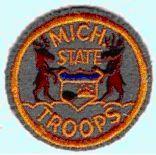
Then Secretary of War Robert F. Patterson summed it up best in his letter to the Governor on November 27, 1946:
"It is with a feeling of pride that I express thanks and appreciation to the State of Michigan for the valuable services rendered by the personnel of the Michigan State Troops during World War II.”

Since December 16, 1941, these troops have a record of outstanding performance in guarding bridges, tunnels, and installations so vital to the vast industrial areas of Michigan. By their alert and faithful service, they have prevented possible sabotage and have insured law and order so that the production of essential materials and equipment continued without interruption.
"With approximately 400 members of the Michigan State Troops on active duty during the entire [World War II] emergency and another 6,000 troops available for instant call, the [U.S.] Army was able to withdraw practically all federal troops from the Michigan area and send them overseas."
The Michigan State Troops were largely deactivated and disbanded in the early part of 1947.
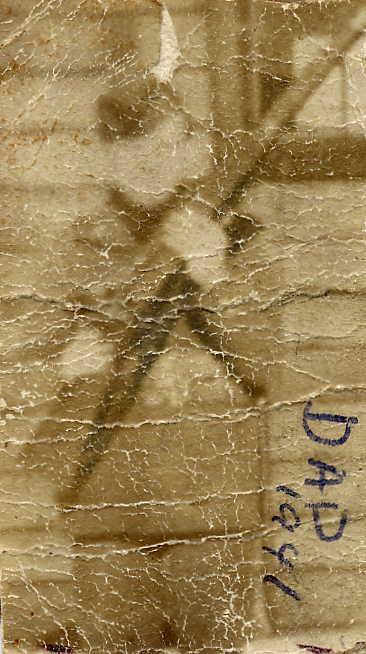
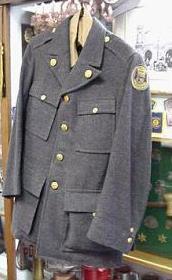
Why and when Frank joined the Michigan State Troops is unknow. What we do know is that he achieved the rank of Corporal, Level V in the 32nd Infantry Regiment, 1st Battalion, Company A as part of the Michigan State Troops. Its function was to provide domestic security and to guard the home front.
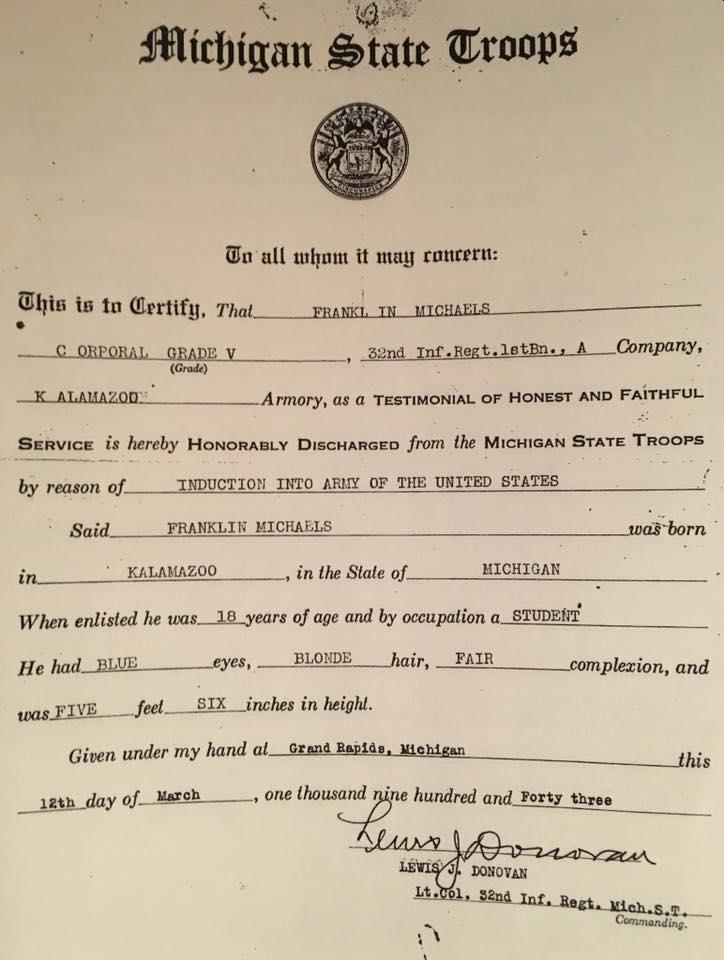
The 32nd Infantry Regiment was called the “Red Arrow” regiment and if you live in Michigan you know that designation because a highway in the Kalamazoo area is called the “Red Arrow Highway” (U. S. 12) which was named after this regiments victories in Europe in WWI and in New Guinea in WWII.
Frank was Honorably Discharged by the Michigan State Troops in Grand Rapids, Michigan on March 12, 1943, because he was inducted into the Army on March 3, 1943 when he was 18 years and 12 days old.
Franklin Charles Micheals was inducted into the Army here on March 3, 1943. Thus, he began his military basic training at this facility. He stayed at this camp until September 1943.

On June 24, 1917, the work of building suitable quarters for housing, and providing drill grounds, rifle ranges, etc., for the training of this division of 43,000 men of the new National Army, began. In a little more than three months after the erection of the first building, 180 barracks were ready for the reception of the first contingent of the selected men who were being trained. And in the short period of five months the corn fields, pastures, and orchards had been razed, and in their stead long rows of bare, unpainted structures had sprung up, macadamized roads built, sewers put in, heating, lighting and water systems installed, bridges built and a remount station and rifle range constructed.
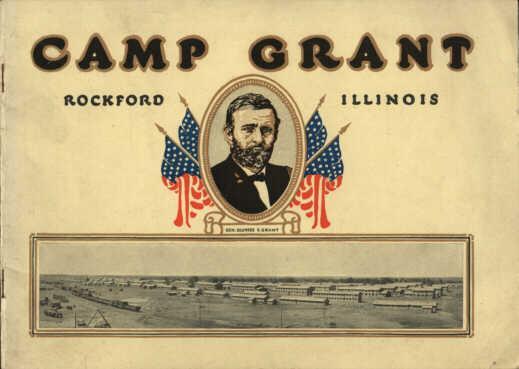
The post was christened Camp Grant in honor of General Ulysses S. Grant.
The total cost of the camp was $7,000,000. The largest number of men working at any one time was 8,500, but it is estimated that at least 50,000 individuals worked on the big job.
The total area of the camp is 5640 acres, within which eighteen miles of water pipe were laid, through which the camp water plant forces 6,000,000 gallons of water per day. Three hundred and fifty miles of electric wire was strung and is in use. The 1,520 buildings had an aggregate floor space of 2,200 acres, and if placed end to end would reach a distance of twenty five miles. Forty eight million feet of lumber, 680 tons of nails and 21,000 barrels of cement were used in constructing the buildings and their foundations. In all, 4,500 carloads of material were hauled into camp by railroads.
Fifty nine steam heating plants furnish heat for the cantonment through a system of thirty two miles of pipes. Each of the big power plants contains a battery of from two to ten 250 horsepower boilers. In contrast to the heating system, an ice plant turns out 20,000 tons of ice a day to supply the cold storage house and the refrigerators of the 180 barracks. From these barracks, fifteen tons of rubbish are carted away each day to the garbage incinerator to be burned. Most of the garbage from the camp was sold to near by farmers for feeding to hogs.
The base hospital unit contains 61 buildings, which were erected at a cost of $500,000. Thousands of dollars’ worth of equipment and supplies had been purchased for the hospital.
Camp Grant has a remount depot, which has a capacity of 5,000 animals. At this station, animals for the army are assorted and assigned to the various army posts in the zone of the central department at Chicago. In connection with the remount depot is a school for blacksmiths. The remount depot buildings cover fifteen acres.

Fire protection for the military city was secured through an efficient fire department, housed in three fire stations. Two hundred and sixty two fire hydrants are provided throughout the camp and 18,000 pails and as many fire extinguishers are placed in the various buildings for emergency use.
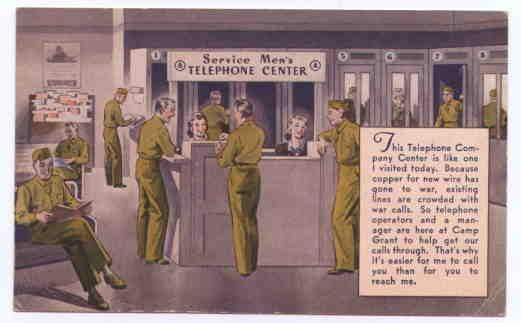
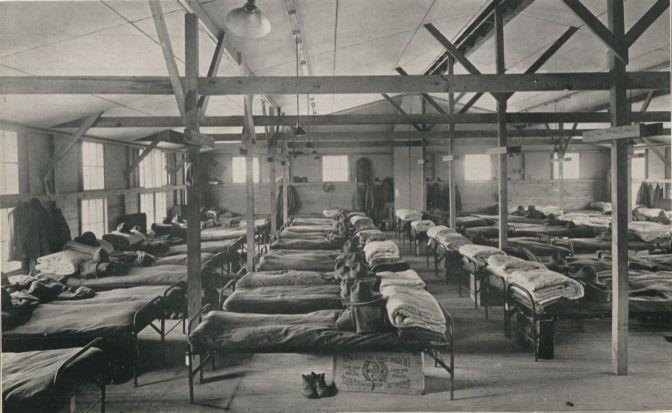

Eighteen miles of macadam road and a pile bridge 1,000 feet in length with an eighteen foot driveway were built. Connecting with the camp system of roadways are two cement roads leading from Rockford to the cantonment.
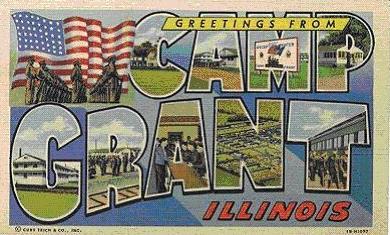
Frank Micheals had his second military training here from September 1943 April 3, 1944. It was mainly infantry training since the land features in this area resembled the land features in Germany.
During the time Frank was at this camp, he was assigned to the 553rd AAA (AW) Battalion, Battery C. This is a post card he sent home on March 20, 1944.

This 45,000 acre site build in 1940 was the training site for over 500,000 GIs headed to the ETO. The camp originally was known as Camp Tioga, but it was soon named after Chancellor Robert R. Livingston who was the chief negotiator of the Louisiana Purchase.
Camp Livingston was designated as an infantry replacement training center, as well as a garrison for these infantry divisions. Here they practiced maneuvers for battles overseas. Over 500,000 troops trained on the 47,000 acre base during the war.
The camp also held German and Italian POWs after the war. On some old concrete walls in the site, beautiful artwork and graffiti has been discovered and is thought to have been drawn by Italian POWs.
Camp Livingston was deactivated in late 1945. Camp Livingston was home to the 28th, 32nd, 38th and 86th Infantry Divisions during the war.
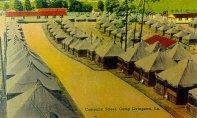

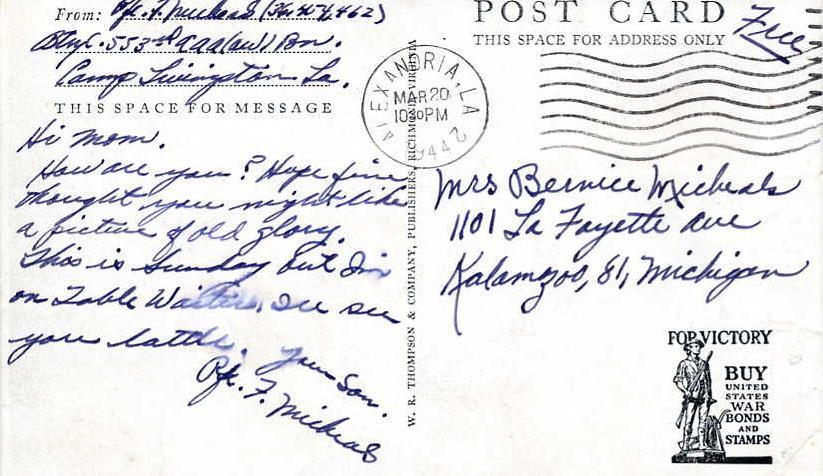
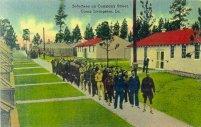
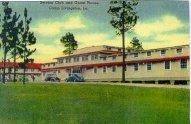




As good as the training has been at Camp Grant, that camp did not look at all like the battlefields of Germany. However, one camp had terrain that was similar, complete with swollen rivers and difficult to cross terrain. That important training camp was Camp Livingston in Alexandria, Louisiana.
It was here that the Lord spared Frank’s life. On one of the Louisiana maneuvers on September 23, 1943, Frank and some men were driving in a Jeep at night with no lights on and on a very narrow road. One of the men in the Jeep, Wesley DeBoer asked the driver to stop so he could change seats with him. Frank agreed and they switched seats.
It was just a short time later when the Jeep was driving on an incline and the Jeep overturned killing the Wesley who had just changed seats with Frank. I don’t believe Frank was hurt in that accident, but I am sure he and the others were pretty shook up. How much Frank understood about the Providence of God then I don’t know, but God did spare his life that day and the rest you can say is history.
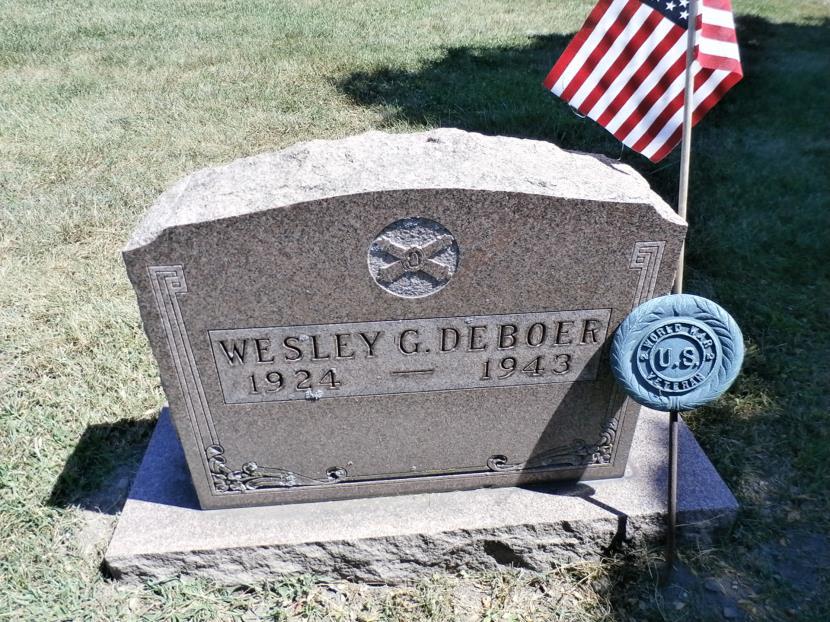
Frank did find the time amidst his sorrows and busy training to write his mother, Bernice on March 20, 1944. And it is a post card that I’d say defined Frank’s love of country which features “Old Glory” flying in the land of the free and the home of the brave.
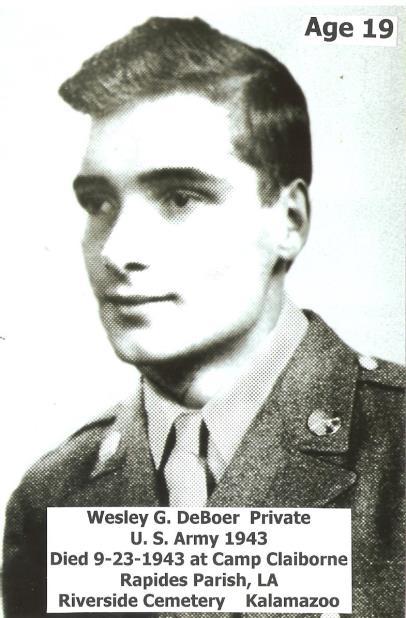
So after Frank’s training was finished he departed Camp Livingston. Frank and his army buddies were now needing to be trained in the skill of canon use. It was time to head to Texas!
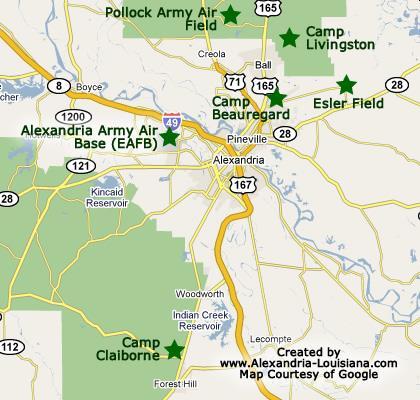
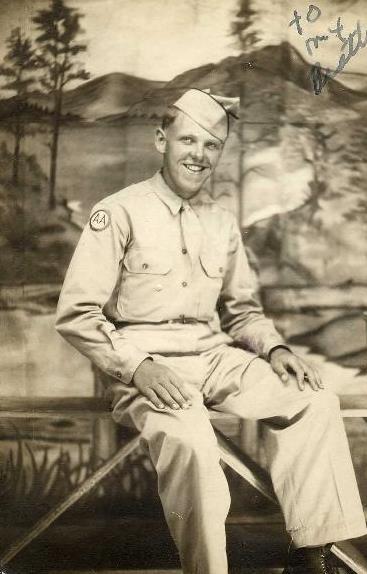
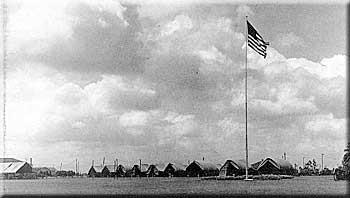
Frank Micheals had his third military training here from April to September 1944. It was here that he did his training to be a Cannoneer on a 90 mm canon.
Camp Hulen, formerly known as Camp Palacios, was on Turtle and Tres Palacios bays just west of Palacios in southwestern Matagorda County. It reached its peak use as a United States Army training center during World War II. It was originally established as a summer training camp for the Thirty Sixth Infantry Division of the Texas National Guard after the Palacios Campsite Association donated the land to the state in 1926. The association had in mind the economic benefits a military training center would bring Palacios. Some 6,500 men came to the first training session in the summer of 1926.
Beginning in July 1926 Camp Palacios had a newspaper, the Camp Palacios T Arrow Daily, published by the Palacios Beacon; its name was derived from the symbols for the two states that largely made up the Thirty sixth Division: T for Texas and an arrowhead for Oklahoma.
In 1930 the camp, where more than $500,000 was spent on housing for the division, was renamed Camp Hulen, after John Augustus Hulen. By 1934 some 1,886 concrete tent floors had been laid for the trainees. Because the surrounding bays provided a safe range for target practice, in 1940 the United States War Department began to use the base for antiaircraft training for National Guard units from across the country (the Thirty sixth Division had moved to Camp Bowie in Brown County).
In January 1941 the first draftees arrived, and the following month saw the first printed issue of the weekly Camp Hulen Searchlight, which had begun earlier as a simple mimeographed sheet. The paper ran until 1945; a few 1943 copies are housed at the Barker Texas History Center, University of Texas at Austin.
Civil contractors and the Work Projects Administration constructed additions to the camp, which eventually included some 400 semi permanent buildings and 2,825 floored, framed, and screened tents, as well as a tent theater, fire station, bakery, weather station, library, dental clinic, post office, and 500 bed hospital. At its height the installation's troop capacity was 14,560. Associated with Camp Hulen were the Indianola Battalion Camp, the Wells Point rifle range and antiaircraft firing range, the Olivia projectile area, and the Civilian War Housing Project. Camp Hulen proper encompassed some 1,460 acres and adjoined the army air base to the north, which, despite the damage done the area by a September hurricane, saw construction begin in October 1942.
Housing for soldiers' families and other newcomers was limited in nearby Palacios, and the town, a fourth of which did not even have proper sewage facilities, was temporarily overloaded by the sudden rise in population. At one time the Texas Rangers were called in to help maintain order. In November 1940, Gen. Harvey C. Allen took command of the camp and the antiaircraft artillery training center. In May 1942, Col. John K. Brown became camp commander, though Allen maintained command of the antiaircraft training center. Several other men commanded the camp before it was deactivated.


In January 1944 Camp Hulen was converted to a prisoner of war camp; the Germans housed there were farmed out to help with agricultural work in the county. On May 31, 1946, the War Department declared Camp Hulen surplus and returned it to the Texas National Guard. Rather than use it for summer training, the guard slowly dismantled it for scrap. Though in 1965 the site was sold to developers hoping to construct an industrial park, by 1985 the abandoned camp still remained undeveloped. The army air base became the Palacios Municipal Airport.
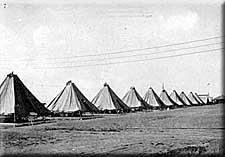
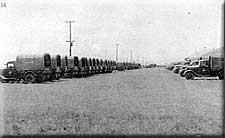


The boots of war initially led Frank to the shores of the Gulf of Mexico and to Camp Hulen in Palacios, Texas. This camp would be formative for Frank because without his time there he would not have been prepared to fight in the Battle of the Roer and Rhine Rivers
This camp, nestled by Turtle Bay in the Gulf, was initially home to the 36th Infantry Division after WW I, but in WWII this 1,460 acre camp had been converted into an anti aircraft and artillery training camp. It was likely here that Frank was actually assigned to the 553rd AAA (Mobile) Battalion, Battery C.
Knowing that Frank operated a 90 mm cannon for most of his months in the ETO might lead one to assume that was all he did. However, that was not the case because the AA Battalions were actually comprised of five Gun Crew teams and Frank served on two of those teams.

The five Gun Crew teams for each of the many AA Battalions were:
1. The Canonners
2. The Portable Generator Operators
3. The Radar/Radio Operators
4. The Searchlight Operators
5. The Truck Drivers
It is likely that men who served in the first four groups helped served as truck drivers so Frank could have been a truck driver in addition to his other two official positions. However, it is unlikely the men served in
other areas unless they were trained because they were specialized teams and the men on those teams had to be specifically trained in those areas.
While 26 months of Frank’s active duty was spent as a 90 mm Cannoneer, he also served for 6 months as a Portable Generator Operator. Perhaps it was serving on this team and the loud noise of the generators that contributed to Frank’s hearing problems he experienced in life.
After a number of months of arduous training and before heading into war, Frank was issued a three day pass. He and his army buddies took advantage of that time off and drove up to Houston, Texas. During this time, Frank’s thoughts drifted back simpler and more peaceful days, to his home and loving family in Kalamazoo, Michigan and so found time to drop his parents a post card on July 11, 1944.

He left Camp Hulen for the last time in late July 1944 and headed to Camp Kilmer in New Jersey. From there he would make his way to the harbor in New York City and a ship, following the drumbeat of war.
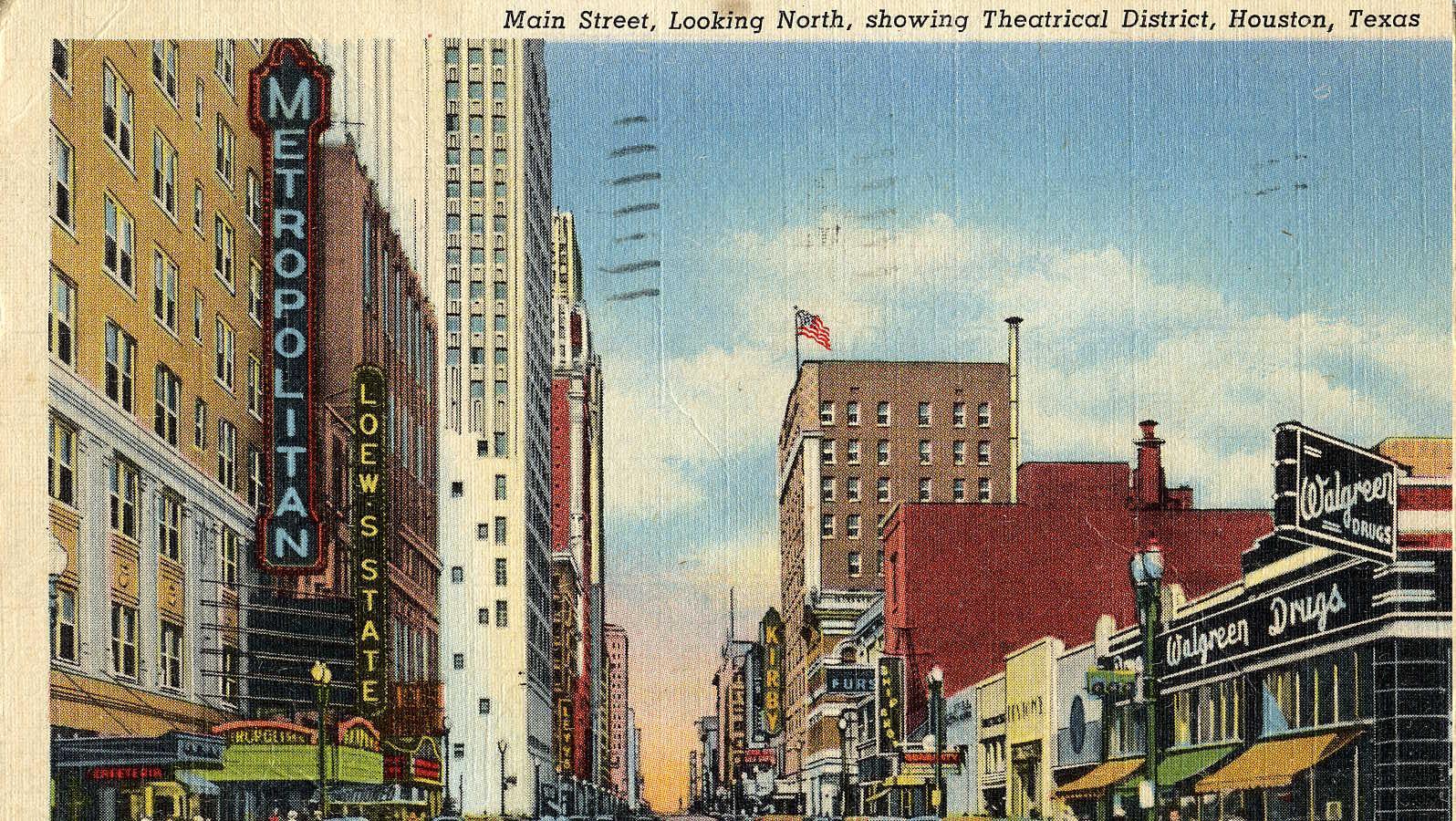
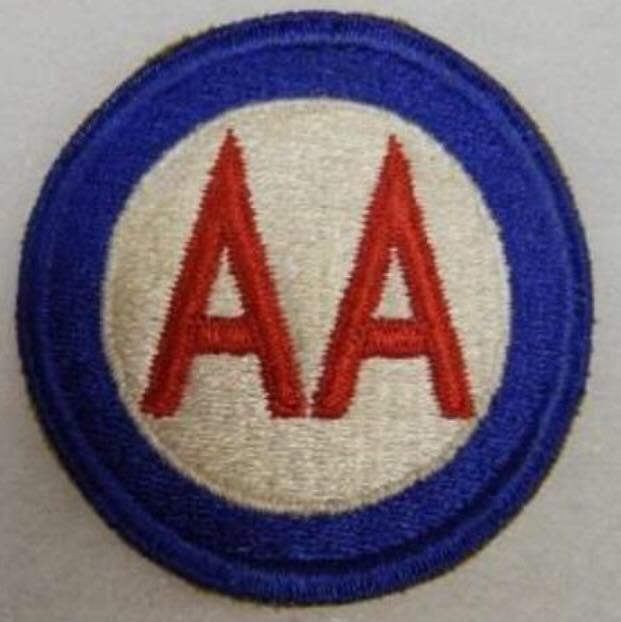

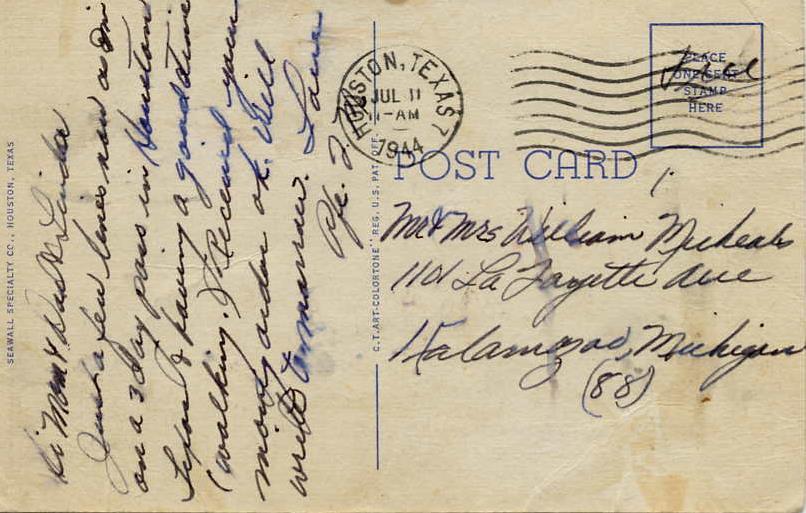
Camp Kilmer, an installation of the New York Port of Embarkation was operated by the Army Transportation Corps In 1941 the War Department selected the New Brunswick, NJ area as the best site for a staging area to serve the port of New York. Construction was started in January 1942, and Camp Kilmer was officially opened in June of that year.
The post is located two miles east of New Brunswick, an industrial city of (at the time) 38,768 people. It was 30 miles south of New York City and 55 miles northeast of Philadelphia.
Camp Kilmer was located near US Route 1, the Garden State Parkway, and the New Jersey Turnpike; and had railroad tracks leading to the PA Railroad, Lehigh Valley Railroad, and the Reading Railroad. This was important as it aided the GIs as they made their way back home.
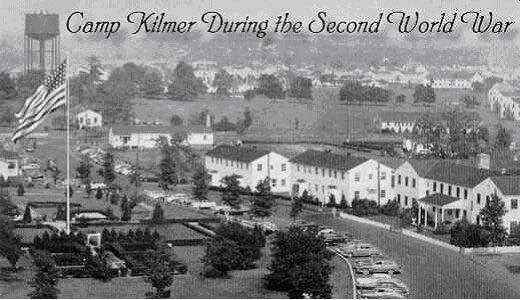
It was the first and largest Army camp constructed initially exclusively for the staging of overseas bound troops. Built in the record breaking time of four and one half months, it was completed on June 15, 1942.
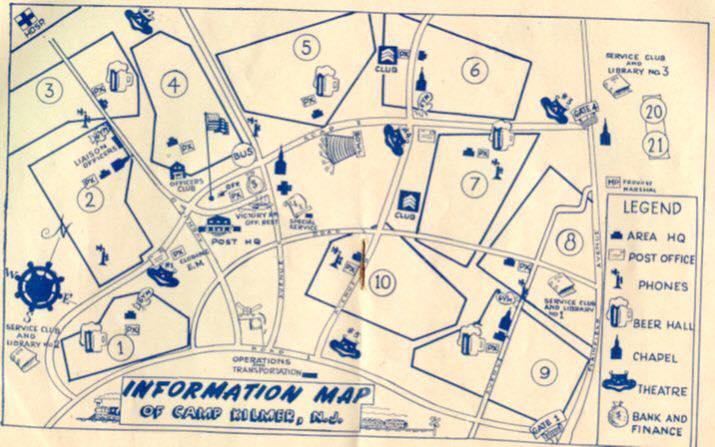

There were 1,268 buildings on the 1,544 acres covered by the post. It included 29 mess halls, five theaters, three gymnasiums, three service clubs, and an 8,500 seat outdoor amphitheater, the Kilmer Bowl.

On January 9, 1945, Camp Kilmer was repurposed to be the main camp processing troops returning from overseas duty for furlough, redeployment, or discharge. These men were fed, issued new clothes, and prepared for transshipment to reception stations in their home areas within 24 to 48 hours after their arrival.
Camp Kilmer became the largest processing center for troops heading overseas and returning from World War II, processing over 2.5 million soldiers.
The camp is named for Sgt. Joyce Kilmer, World War I soldier poet, who gained fame from his poem "Trees." Born in December 6, 1886, in New Brunswick, Sgt. Kilmer was killed in action June 30, 1918, while with the 42nd "Rainbow" Division during the Aisne Marne offensive.
When it was definitely known that an army camp would be established near New Brunswick, the Joyce Kilmer Post of the American Legion sponsored a movement to name the camp in honor of the poet. On
February 24, 1942, the War Department announced that the new installation would be named Camp Kilmer.
In more recent years, the camp was used for other purposes. In the immediate aftermath of the September 11th terrorist attacks, the Federal Emergency Management Agency created a temporary headquarters at the facility. The camp officially closed in 2009.1
1 https://www.archives.gov/nyc/exhibit/camp kilmer
Frank's Military Unit - 553rd AAA (Mobile)
Frank started his military career serving in the 553rd Anti Aircraft Artillery Automatic Weapons Battalions (Mobile), Battery C which was part of the Ninth Army The 553rd was integrated in November 1944 into the 84th Infantry Division once they arrived in the European Theatre of Operations (ETO).
The AAA units attached to the Ninth Army were the: 397
, 430
, 440
, 445
, 446
, 448
, 453
, 459
, 463
, 531
, 547
, 553rd, 553
,
, 556
, 557
, 559
562
563
580
, 597
and the 635
At the beginning of World War II, the US antiaircraft artillery force was very much the poor stepchild of the Coast Artillery Corps. The units were mostly three battalion (a gun battalion, an automatic weapons battalion, and a searchlight battalion) regiments and separate battalions. They were equipped with a motley mix of obsolescent 3" guns and single barrel water cooled .50 caliber machine guns. The German Blitzkrieg in Europe forced a widespread reevaluation of the Army's AAA capability and, beginning in 1940 1941 a vast expansion of the arm (it finally achieved an identity separate from the Coast Artillery in 1943). On September 30, 1942, it was proposed that 811 AAA battalions be organized (with a total strength of 619,000 men).
In 1943, the AAA regiments were broken up into separate battalions, with the regimental H&H companies becoming new AAA Group Headquarters. The AAA battalions were organized as either gun (equipped with the M1 90mm AA gun) or automatic weapons (equipped initially with a U.S. designed M1 37mm gun, but later almost wholly re equipped with the famous M1 40mm Bofors designed gun, and with the M51 or M55 quad mount .50 caliber machine gun). Battalions were further classified as mobile (that is towed), SP (utilizing halftrack mounted guns, the M16, a quad .50 caliber mounting, and the M15, a combination
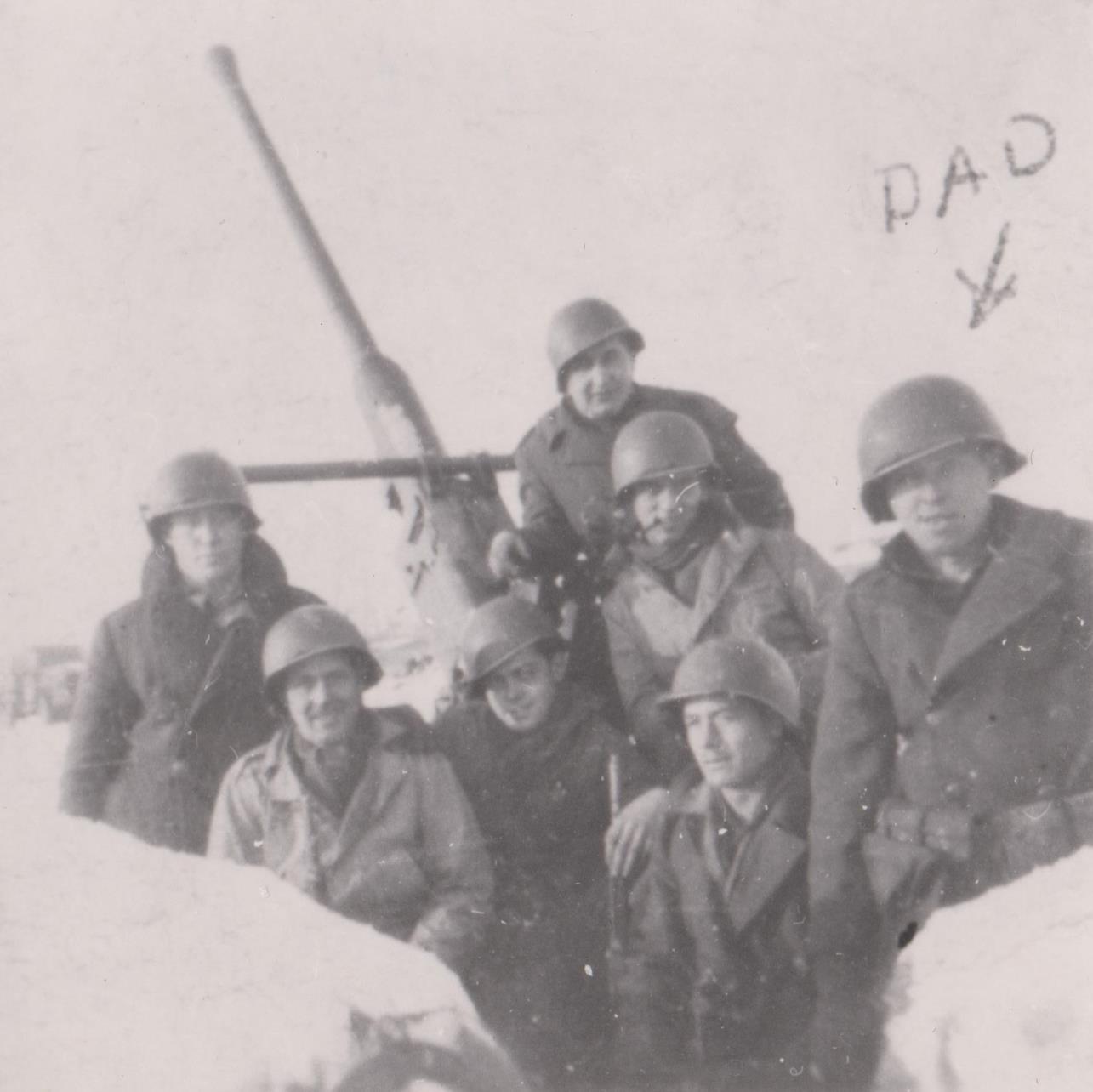
mounting twin water cooled .50 caliber and a single 37mm), or semi mobile (with a reduced number of prime movers, designed for the defense of static installations).
The automatic weapons battalions of all types were organized with four firing batteries, lettered A to D, an H&H Battery, and a Service Battery. Each battery nominally contained eight towed 40mm or 37mm SP guns and eight quad .50 caliber towed or SP machine guns. However, many slight variations existed, some battalions had batteries composed of eight towed 40mm guns, four quad .50 caliber mounts, and eight single water cooled .50 caliber machine guns (there was a shortfall in production of the M51 and M55 mounts). Gun battalions were organized identically, except the batteries were equipped with four 90mm guns each and, usually, three water cooled .50 caliber machine guns.
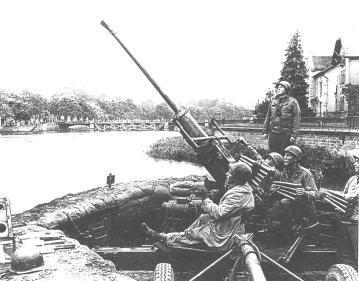

Normally, an AAA automatic weapons battalion was attached to each Infantry division, or an armored division. Sometimes they remained unattached and were mobile. An Army Corps normally had several AAA groups attached. Each AAA group consisted of two or more automatic weapons battalions (usually mobile), although a gun battalion was occasionally attached.
In the European Theater, gun battalions were more frequently found in AAA groups attached to the army or army groups. Antiaircraft brigades were also formed and were normally attached to armies or to theater commands. In addition, the IX Air Defense Command (in effect an AAA division, originally organized as a part of the US Ninth Tactical Air Force), with an average of ten to fifteen gun and automatic weapons battalions, formed a powerful AAA reserve for the US 12th Army Group in Europe. However, this massive buildup of AAA units became largely redundant when another formerly poor relation of the US Army, the Army Air Corps, wrested command of the air from the Luftwaffe in 1943 and 1944.
Many AAA battalions were disbanded to provide replacements in 1944, but some were converted to artillery. A total of 258 battalions were inactivated or disbanded between January 1, 1944 and May 8, 1945. Many AAA Battalions were assigned to various Infantry Divisions and put in their artillery companies. Some were attached directly to the individual Infantry Divisions. Nevertheless, the AAA battalions remained a strong component of the army and achieved something of resurgence in late 1944 in Belgium, defending Antwerp from the threat of the V 1 "Buzzbomb." On December 31, 1944, there were still a total of 347 AAA battalions (with 257,000 men) active in the Army.
Frank served in the 553rd AAA with Wesley G. DeBoer (killed in the Jeep roll over noted later in the book), Bob DeVries (Third Reformed Church, Kalamazoo, MI), Carl Bussema (Third Reformed Church, Kalamazoo, MI), Pvt. Glenn Mummert, Pvt. Warren Peterson, Pvt. William Rasak, Pfc. Raphael A. Siedler (killed in 1945) among others.
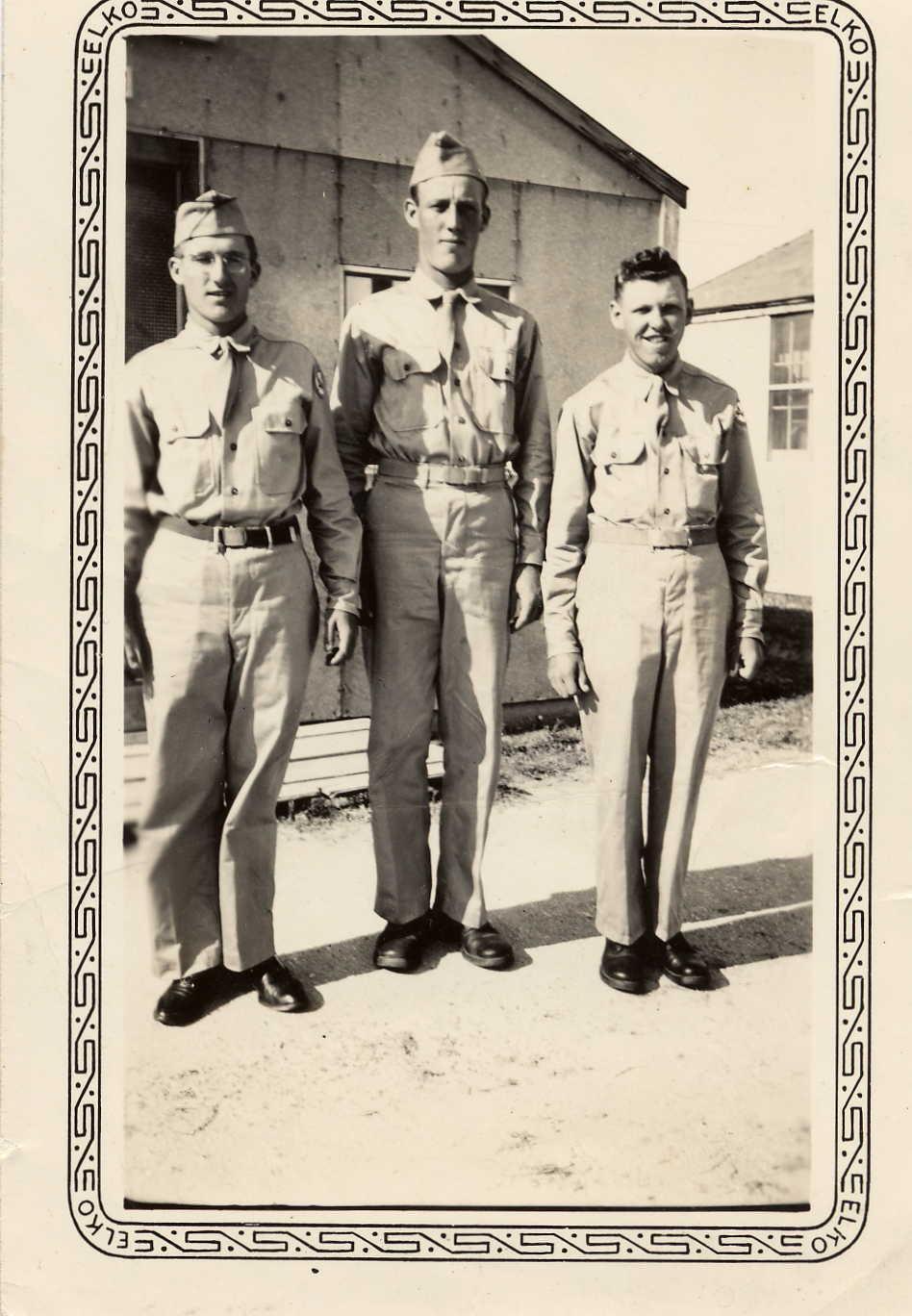
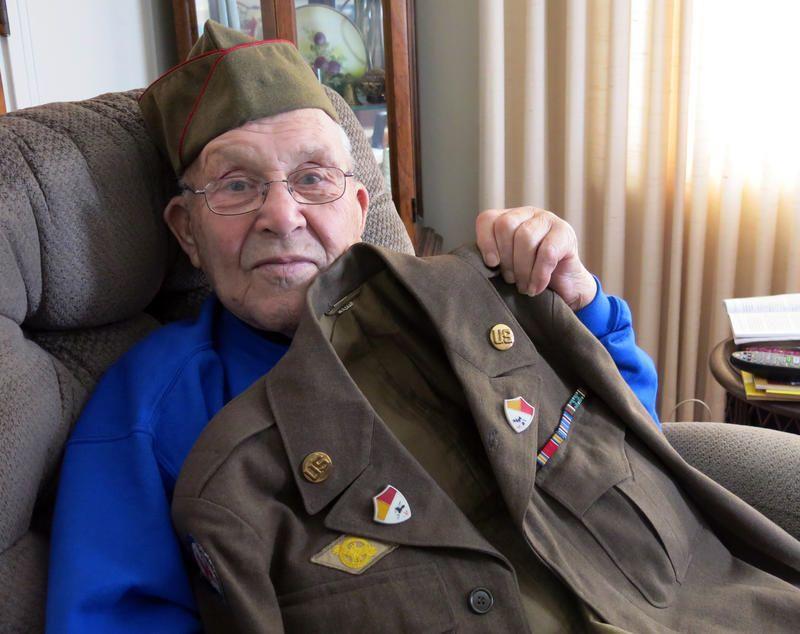
Frank departed the New Work Embarkation Port on August 11, 1944. He took the Thomas H. Barry Troopship.

The photo on the next page is part of a military report called the "Morning Report". It is a record of the events of that day and it appears that each operational unity in the military has someone who creates such reports. There is another report called the "After Action Report" that gives detailed description of the events that had just taken place after an engagement with the enemy. I have yet to find any After Action Reports from Frank’s 553rd AAA Battalion or his Company M of the 84th Infantry Division he was eventually assigned to.
2 https://www.criticalpast.com/video/65675058760_American
While this photo taken from the 553rd AAA "Morning Report" seem dull, it is exciting because the match dates in Frank's Discharge Papers. It shows the day he left New York, August 11, 1944 and the military group he was a part of when he left. Another Morning Report shows the date he arrived in Glasgow, Scotland on August 24, 1944. They went by ship to Glasgow in order to avoid possible German submarines in the Atlantic Ocean.

The second report shows that they left Glasgow, Scotland by rail at 8:15 am on August 24, 1944 and arrived in Blackshaw Moor, England at 7:30 pm that same day. They continued on my rail to Bristol, England and eventually to Southampton, England where they regrouped before crossing the English Channel.
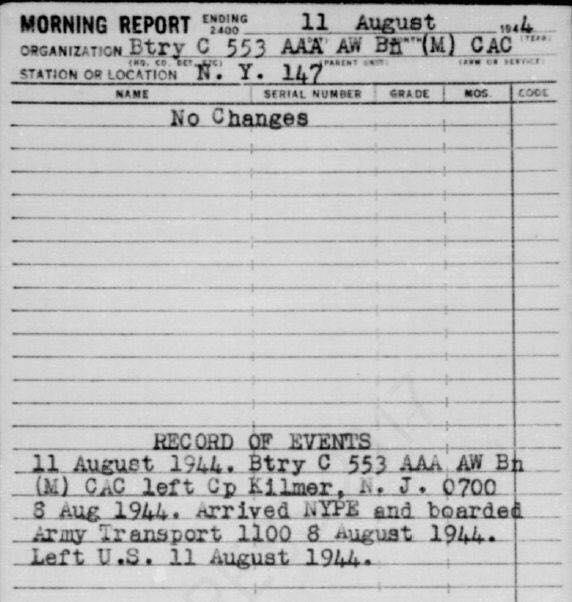
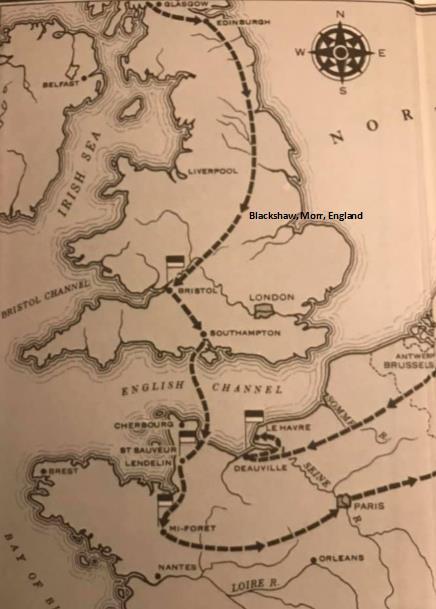
Frank was part of the Ninth Army. For much of the war, the Ninth Army was sandwiched between he better known Army General Omar Bradley of the First Army and General George Patton of the Third Army. While part of the Ninth Army was to be the backup military group for the other two Armies, the Ninth Army saw plenty of action once they landed in France and as they made their way to Germany.
The Ninth Army had the reputation of being loyal to the General of the Ninth Army, General William H. Simpson. He felt likewise and after the war ended, he penned this fitting tribute to the men of the Ninth Army.
“To the individual soldier I give final and highest praise. Whether in a front line unit often cold, wet, tired and miserable, always exposed to the hazards of mines, shell fire, sniping, and strafing or in a rearward position, performing hard and frequent monotonous and dull tasks without glamour it was only though his spirit, courage, and ability, working in a team with his fellow soldiers, that our armies were victorious. To all Ninth Army men I say again: Command of the Ninth army I consider a privilege; service in it, along with you, a great honor.” W. H. Simpson
Lt. Gen. William H. Simpson, veteran of overseas service in World War I, held the command of the 9th Infantry Regiment, 2nd Division, in June 1940. He was given command of the Infantry Replacement Training Center of the Army in April 1941. Six months later he became commanding general of the 35th Division, and he served from April to September 1942 as commander of the 30th Division. For one month he commanded the XII Corps. In September 1943, he was placed at the head of the Fourth Army. In the spring of 1944, an additional army headquarters (the Eighth) was formed from the Fourth Army and General Simpson was made commander of the new headquarters. He took it to the United Kingdom in May 1944 and remained as its head when it was renumbered the Ninth.
The Ninth Army had up to 650,000 troops at its peak. A total of 5,194 were killed, 27,555 wounded, 4,716 missing and 37,581 captured. They captured 1,123,795 prisoners of war.
Gen. Simpson died on August 15, 1980 at the age of 92. In this newspaper clipping, you can see that Frank Micheals (own handwriting) was with General Simpson when he landed at Utah Beach on August 29 or 30, 1944.
Kalamazoo Gazette, August 17, 1980

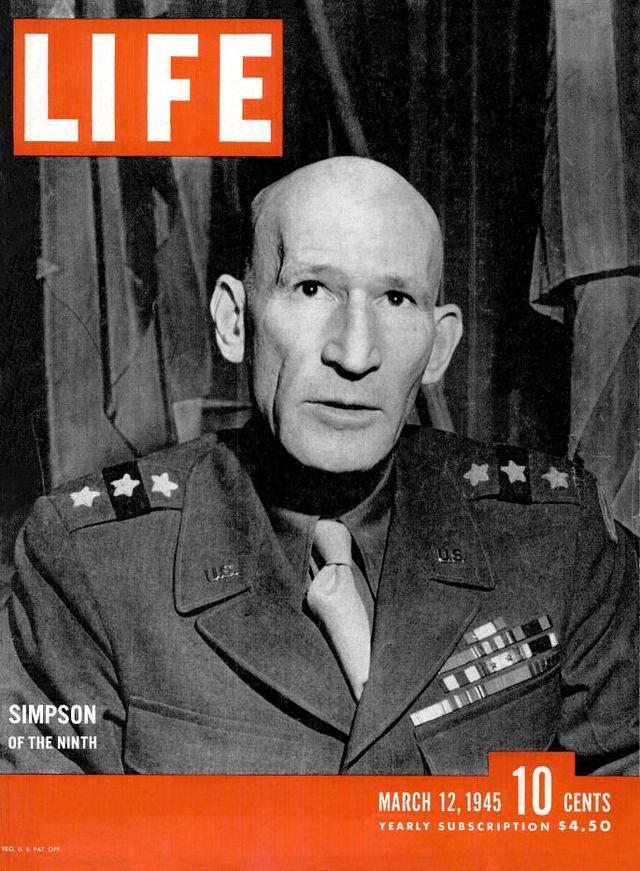
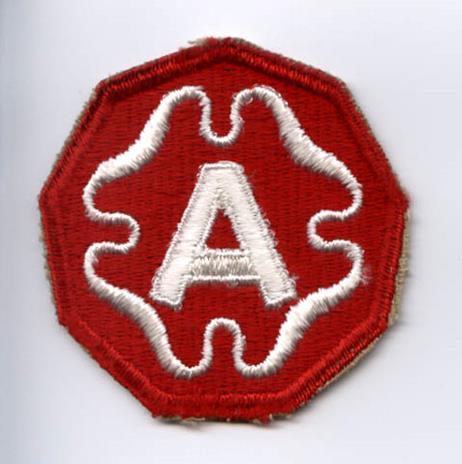
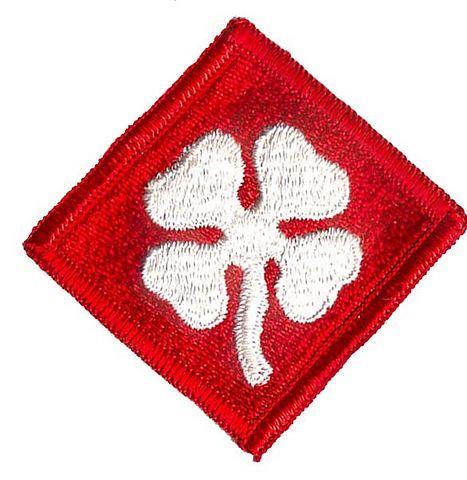
The Ninth Army was the Eighth Army in 1944, but Dwight D. Eisenhower did not want to have the U.S. Eighth Army confused with the British Eighth Army, so he had the U.S. Eighth Army renamed the Ninth Army after it arrived in England in August 1944. Therefore, a new patch had to be quickly designed. The four leaf clover from the Fourth Army patch was used and redesigned. The red nonagon shape from the Eighth Army was then used to create a new patch for the new Ninth Army.
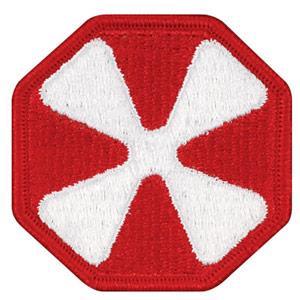
The operational life history of Ninth Army began on September 5, 1944. At noon on that date General Simpson took command of all the forces in the Brittany Peninsula which had been operating under the Third Army. His mission was to complete the reduction of the Brittany Peninsula and to protect the south flank of the 12th Army Group along the Loire River as far east as Orleans.
General Simpson’s Headquarters landed on Utah Beach some weeks ahead of the rest of the Ninth Army. The main part of the Ninth Army landed after dark on Utah Beach on August 29 and throughout the day on August 30, 1944. When they landed they had no opposition since the Germany Army had been beaten off the beach by the invasion on D Day. Upon landing the Ninth Army marched about eight miles inland (to around Saint Côme du Mont) with full pack through the rain and mud. Once they were established in France, they made their way to Périers, St. Sauveur Lendelin and Mi Forêt, France, where the rear echelon established their quarters.

The situation in this area as it existed when the Ninth Army assumed responsibility had developed in the following manner. The invasion of Normandy had begun June 6, 1944, by the U.S. First Army, under Lieutenant General Omar N. Bradley, and by British and Canadian forces. The initial successful beachhead landings had been followed by many weeks of hedgerow fighting with very slow progress and numerous bloody battles. The names Caen, Carentan, La Haye du Puits, and St. Lo are well known to all who lived through those tense days.
Late in July the now famous breakthrough at St. Lo was affected by First Army, and early in August Lieutenant General George S. Patton’s newly operational Third Army drove through the bottleneck at Avranches and struck to the east, the west, and the south. On August 1 the 12th Army Group Headquarters became operational, with both First and Third Armies, under the command of General Bradley, and Lieutenant General Courtney H. Hodges took command of the First Army.
Following the breakthrough at St. Lo and the drive southward, American armor and motorized infantry raced rapidly forward in independent, daring advances. So rapid and so demoralizing were these sudden thrusts that German defensive plans and defensive lines became useless, and the enemy had to resort to concentrating what forces he could at key points and holing up in such fortresses as would afford him the opportunity for a long term defense and the denial to the Allies of the most important facilities for carrying on their campaign. Accordingly, he chose such ports as St. Malo, Brest, Lorient, and St. Nazaire, and garrisoned these cities with all the manpower and materiel he could salvage.
A brief stand was made at Rennes, ancient capital of Brittany Province, but this was short lived. St. Malo was reduced by Major General Robert C. Macon’s 83nd Infantry Division while still operating under Third Army. By passing St. Malo and pushing out west through the Brittany Peninsula, the main forces of the VIII Corps, under the command of Major General Troy H. Middleton, had made rapid progress until the Germans finally dug in, in and around Brest, to fight it out for that worth while prize. This, then, was the situation when Ninth Army became operational.
The city of Brest, with a pre war population of some 85,000, began its connection with the United States Army when it was developed as the chief American port in France during World War I. Most of the American troops and supplies used to break the might of German aggression twenty six years previously had entered France through Brest. In subsequent years the French Navy continued the development of
Brest until, at the outbreak of World War II, it was France’s chief naval port. When, in 1940, the German Blitzkrieg swept across Western France, Brest was one of the first class plums that fell to the enemy, for in its magnificent harbor the Germans were able to develop one of their most important submarine bases with tremendous concrete covered submarine pens which withstood every Allied attempt to knock them out from the air.
The enemy was fully aware of the usefulness of the port of Brest to the Allies in the continuation of their European campaign. The estimate of the Allied planners of the invasion was that operations could be sustained by supplying over the beaches and through the limited port facilities of Cherbourg until early September, but after that the port facilities of Brest must be in Allied hands in order to continue the impetus of the offensive throughout the winter. This estimate was based particularly on the weather conditions which were expected to reduce drastically the tonnage which could be successfully handled across the beaches. That it did not prove entirely accurate is beside the point.
In planning operations for late summer of 1944, one mission stood out boldly in the minds of Allied leaders Brest must be taken.
VIII Corps had begun operations in the actual battle of Brest in mid August 1944, and it was expected at that time, that the capture of the city would be accomplished within one week. However, it was to be nearly a month later before the tenacious defenders finally surrendered the city, which by then had been virtually destroyed by Allied planes and artillery.
Ninth Army’s first battle mission was defined in the first paragraph of 12th Army Group’s Letter of Instructions No. 7, dated September 5, 1944.
The Ninth Army, effective at 1200 hours, 5 September 1944, assumes command of the VIII Corps, as now constituted, with the mission of reducing the Brittany Peninsula and protecting the south flank of 12th Army Group along the Loire River from its mouth to Orleans exclusive. Ninth Army will prepare for further action to the east on the right (south) flank of the Third Army.
Actually this mission was given to the Army Commander on the previous day. Leaving the tents of his command post in the forest of Mi Foret near Rennes on September 4, General Simpson had reported to General Bradley at 12th Army Group Headquarters, which by contrast was then located at Versailles. There General Bradley informed him of his mission and urged the speediest conclusion possible to the campaign for Brest.
The forces which came under Ninth Army command on September 5 were the VIII Corps with its supporting combat and service troops and with four infantry divisions the 2nd, commanded by Major General Walter M. Robertson; the 8th commanded by Major General Donald A. Stroh; the 29th commanded by Major General Charles H. Gerhardt; the 83rd, commanded by Major General Robert C. Macon — and one armored division, the 6th, commanded by Major General Robert W. Grow. The VIII Corps Artillery, commanded by Brigadier General John E. McMahon, Jr., included some five group headquarters and seventeen artillery battalions, principally of medium and heavy calibers. Attached to the VIII Corps Artillery was Brigadier General John F. Uncles’ 34th Field Artillery Brigade, which was destined to be the Ninth Army brigade of army artillery.
The disposition of these troops was as follows: the 29th, 8th, and 2nd Infantry Divisions formed an arc around the city of Brest with the 29th on the right (west), the 8th in the center, and the 2nd on the left (east). This arc stretched from the Conquet Peninsula around to the Elorn River east of Brest proper. Occupying the bases of the peninsulas to the south and southeast of Brest and completing the encirclement of the fortress were two task forces. Task Force A on the Crozon Peninsula, under Brigadier General Herbert L. Earnest, commanding the 1st Tank Destroyer Brigade, included a tank destroyer group headquarters, a cavalry group headquarters and two cavalry squadrons, an infantry battalion, and elements of a tank destroyer battalion and of a combat engineer battalion. Task Force B on the Daoulas Peninsula had already completed the clearing of that area and now consisted of small infantry elements to prevent the Germans from infiltrating back onto the peninsula from either Crozon or Brest. Also in the Daoulas area was a group of corps artillery whose battalions could fire across the harbor and pound the enemy batteries on Crozon and the rear of the defenses around Brest.
The siege of the city was twelve days old when Ninth Army assumed command, and it was well established at the time that the defenders had no intention either of capitulating or of evacuating, but were intent upon holding their positions to accomplish a maximum delay in American occupancy of the port. The 6th
Armored Division, which had led the race westward through the Brittany Peninsula to Brest, had been withdrawn once the siege had begun, in order to permit infantry work to be done by infantry, and now it was engaged in containing the enemy pocket at Lorient and patrolling the Vannes area in the vicinity of
Quiberon Bay. Continuing the flank protection to the south and east the 83d Infantry Division, having completed its task at St. Malo, was containing the large German pockets at St. Nazaire and Nantes (Map No. i) and patrolling the Loire River as far east as Orleans. Plans made long before for the invasion had designated the Loire River as the southern limit of advance of Allied forces. There was no intention to disperse the effort aimed at the heart of Germany by embarking on a campaign in southern France. However, the security of this long, exposed flank of the Army Group was of extreme importance, and the limited number of troops engaged in its protection were pressed to the utmost to accomplish their task. In fact, had it not been for the able assistance of the loyal French Forces of the Interior, it is doubtful that the mission could have been executed so economically.
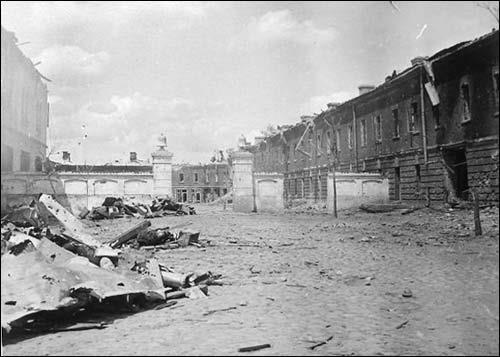
In the Brest area the enemy forces under Major General Hermann Bernhard Ramcke, an able, courageous, and fanatic Nazi who had commanded the German airborne invasion of Crete, were disposed in two pockets the larger one in Brest proper and smaller one on the Crozon Peninsula. The core of the German defensive organization was three regular divisions the 266th Infantry, the 343d Infantry, and the 2d Parachute Divisions. The parachute division was an elite unit of the German Army, but it was estimated that losses without corresponding replacements had reduced the parachutist strength in its infantry companies to about thirty five percent of normal. Reinforcing the three regular divisions was a heterogeneous collection of battle groups comprising all manner of personnel. In addition to members of the static coastal garrison, there were odd lot army individuals and naval and marine units, all of which had been trapped by the besieging American forces. The defenders even utilized members of the customs service and the navy meteorological service in their desperate attempt to hold out.
By September 5 the attack on Brest had been slowed almost to a stop. The strong natural defensive features of the area, the skillfully constructed German defenses, and the desperate, well coordinated effort of the defenders proved a difficult problem to overcome. The key to the situation for the attackers was overwhelming artillery support, and therein lay the reason for the slowing down of the operation. Although adequate artillery was present in the battle area, there was a critical shortage of ammunition, particularly of heavy caliber. Supply lines were long and the speed of the attack on the Peninsula had given rise to the hope that a siege of Brest would not be necessary; that it could be taken quickly before the enemy had time to prepare an effective defense. By September 5 steps had already been taken to accelerate the ammunition supply, and further artillery operations were curtailed in order to permit a build up of three units of fire for all types of artillery ammunition, a level estimated to be necessary to support an all out coordinated attack. General Middleton, the VIII Corps commander, already had completed his plans for the contemplated attack and after study General Simpson approved them.
The final battle for Brest began at 10:00 a.m. on September 8. At that time the 29th Division was two to four miles west of the city, the 8th Infantry Division two miles to the north, and the 2nd Infantry Division three miles to the east. Task forces, already described, were operating on the small Daoulas Peninsula south of the city and the larger Crozon Peninsula farther to the south. A twenty minute artillery
preparation, now possible with the newly arrived stocks of ammunition, preceded the jump off on the morning of September 8. All three divisions attacked simultaneously.
The Penfeld River, running south along the western edge of Brest proper, divides Brest from its smaller companion city of Recouvrance. This river had been the location of the great French naval establishment, but now it was merely a very difficult obstacle, for it tended to divide the efforts of the 29th Division on the right (west) from those of the 8th and 2nd Divisions on the left (east). It was planned, therefore, that the 29th Division clear the Conquet Peninsula and drive east to the Penfeld River while the 8th and 2nd Divisions closed in on Brest proper. In the final stages, the 8th Division would be pinched out for lack of room, and the mopping up of the city would be done by the 2nd Division. There was no room whatever for large scale maneuvering and, in fact, very limited small unit maneuvering was possible. Moreover, the beaches in this vicinity were studded with steel rails and well wired; coastal guns of calibers up to fourteen inches covered the sea approaches — they covered the land approaches, too, for they were capable of
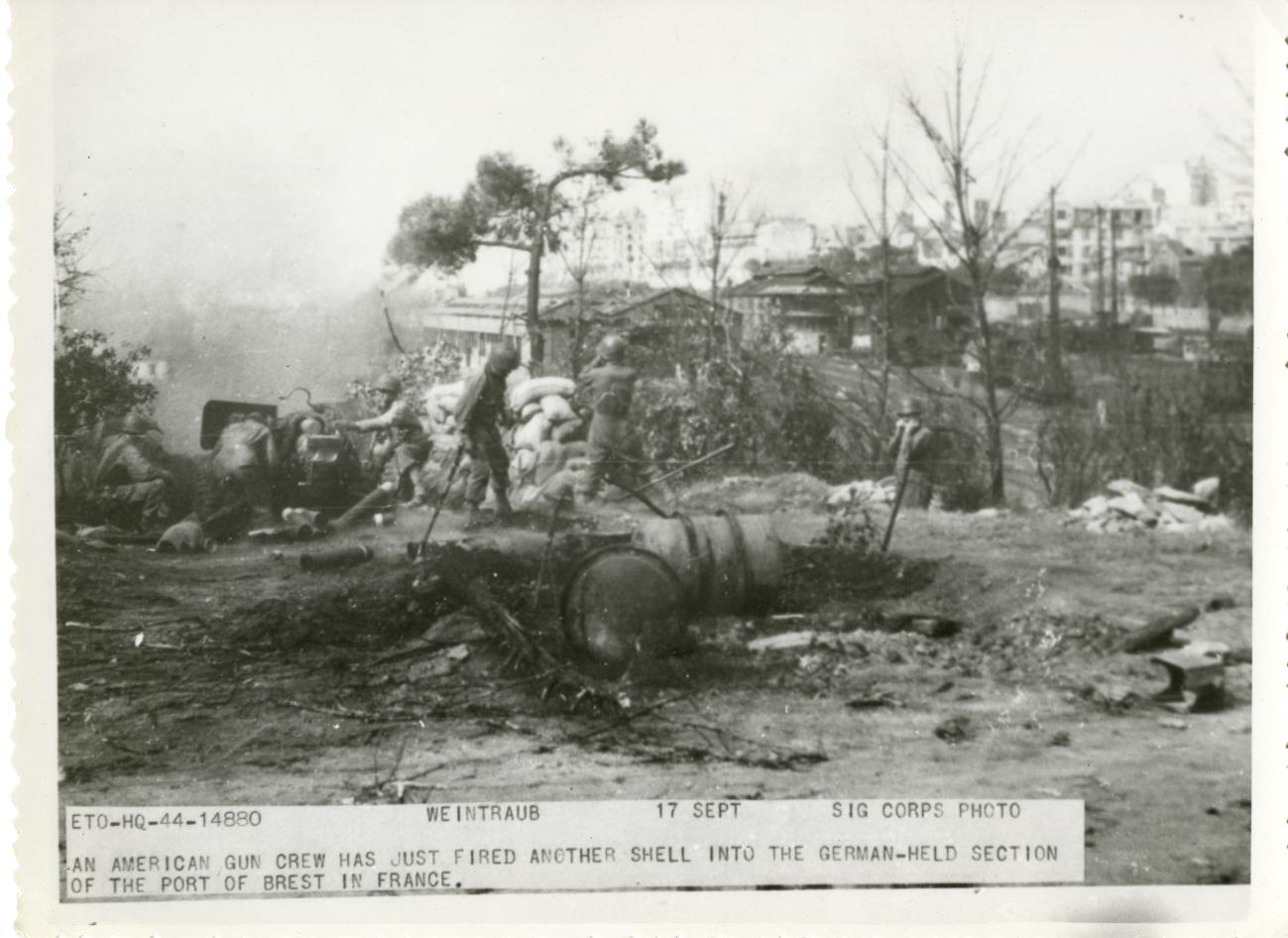
all around traverse and promised terrific losses for any attempted amphibious flanking maneuver. In general, it had to be a head on attack against a stubborn enemy.
Resistance was very stiff during the first day, particularly on the Conquet Peninsula and in the Recouvrance area. North and northeast of the city gains of up to half a mile were accomplished. The enemy was using every device at his disposal to inflict maximum delay. Pillboxes and strongpoints were hotly defended, and mines and booby traps were used in great numbers. For the first time in this area the enemy used miniature tanks, radio controlled and carrying a charge of high explosives. His air power, however, was practically nonexistent, as it was throughout the attack on Brest. Only two small scale bombings were recorded, and these caused neither casualties nor damage.
The Brest operation was really unique in the respect that it was the first operation of the Allied armies in northern Europe to be almost completely free of enemy air attack. Fighters of the American Ninth Air Force were able to carry out missions in cooperation with the ground forces with practically no interference from enemy interception; the attacking troops were free from enemy air attack, particularly the harassing night attacks commonly used by the Germans; and, except for a minimum of alert personnel, the power of five AA artillery battalions was available in its secondary role to reinforce the infantry artillery team.
On September 9 and 10 fighting continued along much the same pattern. In the Conquet Peninsula area the 29th Division, progressing in the face of heavy opposition, secured the surrender of the commanding officer of the troops in this area on the 9th, although the mopping up met stubborn resistance. Isolated forces refused to acknowledge their commander’s surrender and gave up as individuals only after another day of fighting, but September 10 saw the last enemy cleared from the Conquet Peninsula by the 29th Division. In the Recouvrance area, however, the division made little or no advance.
The 2nd and 8th Divisions pressed forward, gaining nearly a mile on September 9. They were now well into the built up area of Brest proper, and their battle became that of destroying a city. The advance which squeezed the life from the encircled fortress was not made down the streets of the city but rather through the buildings, block by block. Pillboxes, positions dug in at intersections, and small embrasures cut in buildings at street level permitted the enemy to sweep the streets with such intense fire as to deny their use to the attacker. The doughboy and engineer teamed to go through the buildings, blasting a path and
capturing the defenders from the bottom floor, a houseful at a time. Concrete air raid shelters were strongly defended and difficult to take. Open spaces such as cemeteries, parks, and railroad yards had to be bypassed because they were covered with crossfire from the surrounding buildings. The Germans also
made maximum use of the extensive network of tunnels in the city. They employed them as hospitals, headquarters, and troop shelters, and, in addition, utilized them to facilitate movement of troops from one quarter of the city to another in comparative safety. Slowly, however, and with considerable cost, the German garrison was being strangled.
On September 11 the 2d and the 8th Divisions again pushed ahead with gains up to one half a mile, while the 29th Division made little or no progress in the Recouvrance sector. In Brest proper the old wall and moat which surrounded the medieval fortress in the center of the city had now been reached. This was a formidable obstacle and it was strongly defended. Initial efforts to scale the wall were repulsed. The ditch or moat was some 45 to 60 feet wide and some 18 to 45 feet deep, and in general followed the contour of the fortress wall. The wall varied from 25 to 45 feet in height. All entrances were blocked and heavily defended. Along the wall and on top of it the enemy was firmly entrenched. Efforts to breach the wall

with artillery, including heavy and super heavy weapons, proved useless. Eight inch howitzers, 8 inch guns, and 240mm howitzers all had a turn at trying to make a hole for the infantry but to no avail.
Although the upper portion of the wall was breached in several places, the lower part, forming the rear wall of the moat and hence defiladed from direct artillery fire, remained undamaged.

With the Conquet Peninsula cleared and Brest penetrated as far as the old wall it was now decided to withdraw the 8th Division for recommitment on the Crozon Peninsula. There was not suflScient room east of the Pen f eld River for two divisions to operate and in addition the establishment of a division on the Crozon Peninsula before Brest fell would insure that no large number of German troops could escape from the city through Crozon, where Task Force A was containing, on order, a strong line of enemy resistence.
On the night of September 11 12, therefore, the 8th Division withdrew its lines 1000 yards and prepared to move.
By September 13 the 29th Division had taken over the zone vacated by the 8th Division, and the 8th Division was completing its move to the Crozon Peninsula. The 29th Division also, in spite of continued strong enemy resistence, had taken Forts Keronroux and Portzic, west of the city, and stood before Fort Montbary, the strongest of the strongpoints. The 2nd Division was still stopped by the massive wall of the old fortress.
The next three days saw little progress. The German defense was desperate, and their use of the built up city was particularly effective. Fort Montbary withstood terrific punishment before it finally capitulated to the 29th Division on the afternoon of the 15th. This old French casemated fort had earth filled masonry walls 40 feet thick and was surrounded by a moat 40 feet wide and 1 5 feet deep. Its gun positions, facing to the northwest, were protected by a minefield composed of 300 pound naval shells equipped with pressure igniters. It garrisoned an estimated 200 to 250 troops.
Once the infantry reached the sunken road along the western side of the fort they found themselves pinned down, and the reduction of the fort became a problem requiring help for the doughboy. At this point, a British unit equipped with flame throwing tanks was brought into the battle. On two successive days these tanks flamed the fort, its walls, and the moat, and after exhausting their fuel, remained in position while the crews employed white phosphorus hand grenades in support of the assault by the infantry. It was a bloody battle and when the garrison finally capitulated, only eighty Germans remained alive to be taken prisoner.
By now the relentless pressure was having a telling effect on the Brest garrison. On September 16 and 17 the artillery maintained continuous fire into an area only 900 yards wide paralleling the waterfront, and into the walled city itself. Although the German antiaircraft guns were now serving as field pieces, the intensity of the enemy artillery fire had diminished considerably.
On the Crozon Peninsula the 8th Division had taken over Task Force A and, supported by the principal elements of five battalions of medium and heavy artillery under the attached 34th Field Artillery Brigade, advanced nearly three miles to the west against scattered resistance. The important turn of events came on the 17th, when the enemy situation deteriorated rapidly. During the day the 29th Division broke through the Recouvrance defenses and occupied the entire area west of the Penfeld River. At the same
time the 2nd Division was able to breach the fortress wall in two places and was pouring its infantry into the old fortress itself.
Meanwhile the 8th Division was moving another three miles to the west on the Crozon Peninsula, steadily shrinking the area that the Brest defenders might have hoped to occupy for a last stand.
Brest fell to the forces of the VIII Corps on September 18. On that date the 2nd Infantry Division completed the capture of the fortress and cleared the area east of the Penfeld River while the 29th Division completed mopping up in the area west of the river.
Ninth Army’s phase of the Brest campaign netted a total of some 28,000 prisoners of war, with an additional 4,000 enemy estimated killed. The total of prisoners captured by VIII Corps during the entire Brest operation, including the period prior to Ninth Army participation, was 37,888. Of this number approximately 20,000 were actual combat troops, including naval personnel; the remainder were civilians who had been put in uniform and armed to assist in the defense. From September 5 through September 20 Ninth Army casualties, incurred almost entirely at Brest, totaled 2,952, including 436 killed and 2,286 wounded.
It was bitterly ironical that the port for which this bloody campaign had been waged was rendered entirely useless in the taking and proved valueless throughout the war. In fact, the terrific destruction brought upon Brest by the desperate resistance of its trapped German defenders was the worst suffered by any major city of the invasion up to that date, and left the French nation with the difficult decision as to whether it was even worthwhile to rebuild the city in the same location.
During the operations in Brittany the Army operated two from cemeteries at St. James, north of Rennes one for American and Allied dead, the other for enemy dead. An additional enemy cemetery was located at Lesneven, near Brest. These cemeteries were transferred to Army control on September 9, and were operated until September 30, when they became a responsibility of Normandy Base Section of Communications Zone. During this period 1,457 Americans, 41 Allied, and 314 enemy were buried. Of the 1,498 Americans and Allies, only some four hundred were killed during the Brest operation. The others were disinterments of isolated burials or bodies recovered subsequent to the breakthrough at St. L6 and the fast moving operations through the Brittany Peninsula.
On September 24, 12th Army Group issued a letter of instructions which included orders to Ninth Army to move the VIII Corps to positions in Belgium Luxembourg between the first and Third Armies generally along the Siegfried Line. Army Headquarters was to be moved to the new area when necessity demanded it. The 29th Division was assigned to the First Army and was to be dispatched prior to the movement of other VIII Corps I troops in order to bolster the American penetration of the German frontier north of Aachen. It will be recalled that in its initial instructions of September 5, 12th Army Group had directed that Ninth Army "prepare for further action to the east and on the right (south) flank of Third Army.” Now the mission was changed to direct the Army’s planning efforts to the area between St. Vith on the north and Metz on the south between First and Third Armies.
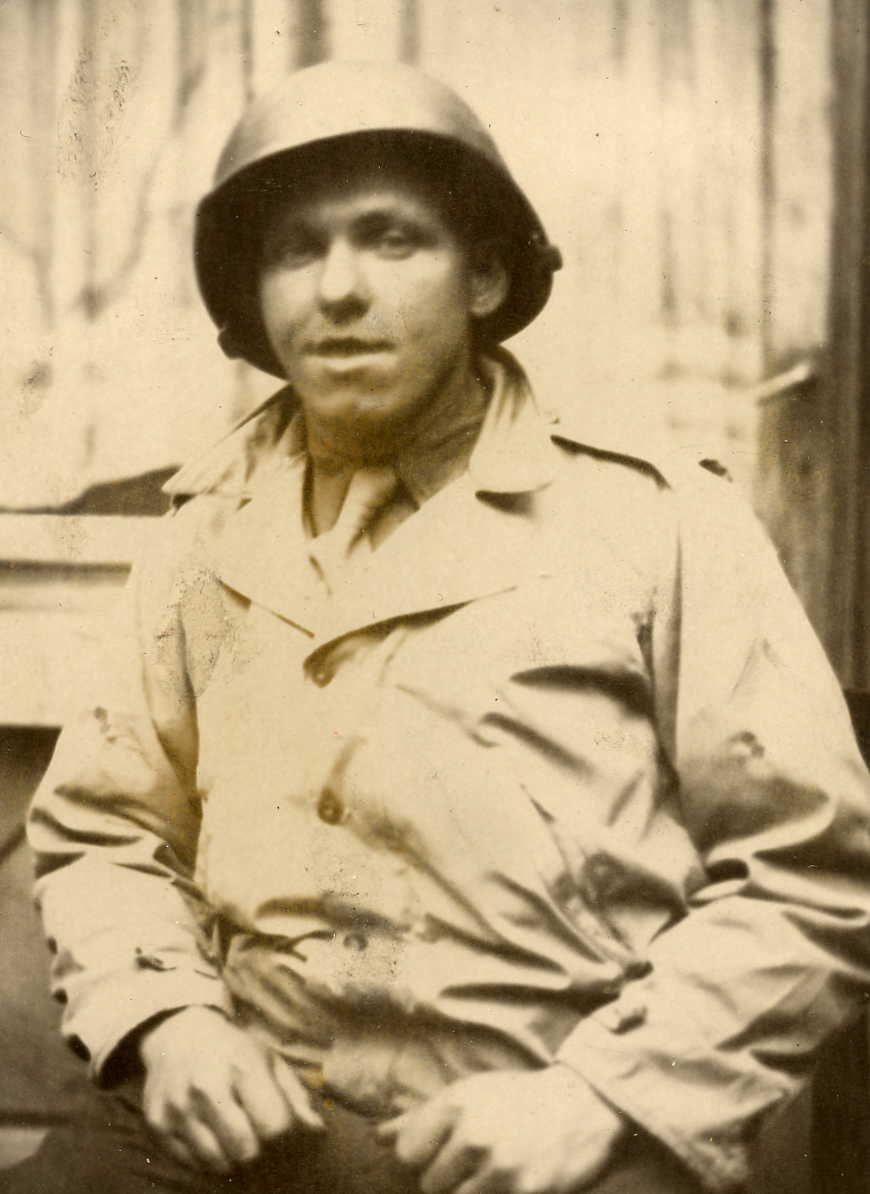
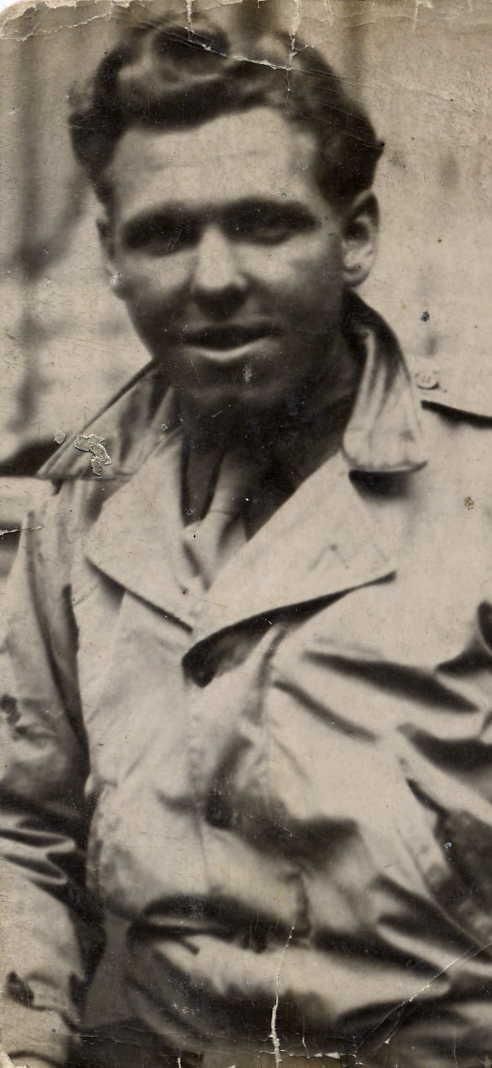
The French Francs above came when Frank met his half brother Lawrence Bates when they met I believe in London by a Providential unplanned meeting I believe in London on July 11, 1945. They had not seen each other for several years. Lawrence wrote on this note where he was stationed in Barrington, England.





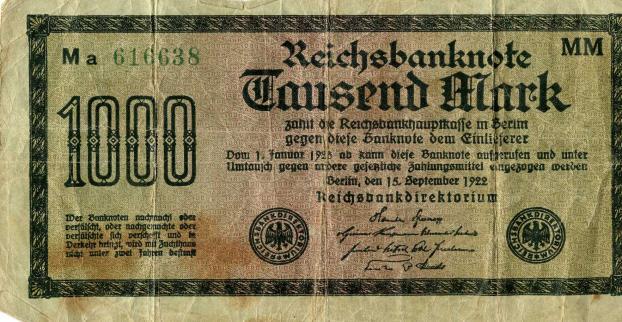

On September 24, 1944, the Ninth Army receives orders to move to Belgium Luxembourg between the First and the Third Armies. The Ninth Army drives to Paris with no opposition noted and sets up its headquarters in Arlon, Belgium.
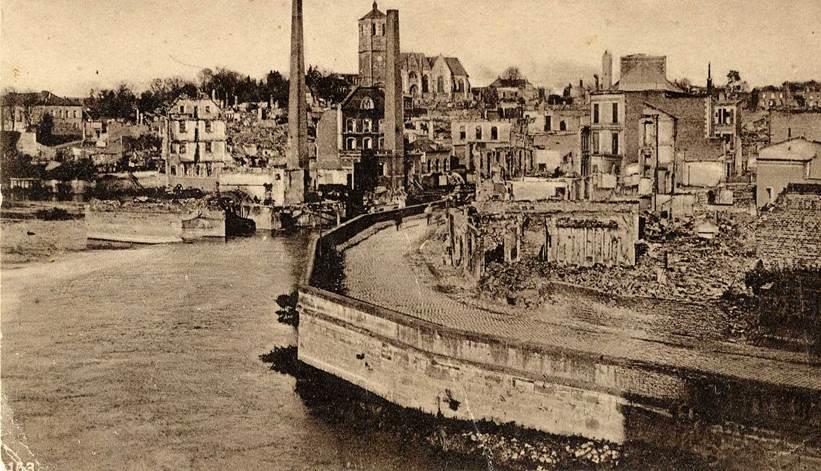
On October 8, 1944 a rear echelon opened up at Maastricht, Holland. Maastricht was the hub of Ninth Army’s new supply area. The Ninth Army’s position in the Maastricht region brought its first major contact with flying bombs; the Army rear area was squarely in the path of the buzz bomb attack against the port of Antwerp. Graphical analysis of the incidence of the flying bombs showed, however, that no target in the Ninth Army area was under a planned attack.” Therefore, the troops in the town of Maastricht did not launch a counter attack because it was not worth the risk of losing men, the bridges, or supplies.
On November 8, 1944, the Ninth Army assumes control of the 84th Infantry Division.
NICKNAME: Railsplitters. (In WW I the division was known as the “Lincoln Division” because it first trained in KY, and because it drew much of its personnel from KY and IL, in which states Lincoln began his political career. The name was changed to Railsplitters in this war as the shoulder patch symbolizes this occupation of Lincoln as a young man.
SHOULDER PATCH: Patch consists of a red disc on which, in white, an axe is shown splitting a rail. The original insignia was a red ax on a white background within a red circle, with the name Lincoln above and the number 84 below the ax. Later the name and number were dropped from the patch.

HISTORY: The division was organized in August 1917, at Camp Taylor, KY. The division was depleted from time to time to fill up other organizations. In June 1918, however, it was transferred to Camp Sherman OH and was brought up to authorized strength. The 84th went overseas in Sept and Oct 1918 where it was broken up to provide replacements for combat units at the front. Headquarters of the 84th and the permanent cadres were returned to the US in January 1919, at which time the division was demobilized.
ACTIVATION DATE: 15 October 1942. INACTIVATION DATE: 24 January 1946, Camp Kilmer, New Jersey.
COMPONENT UNITS: 333rd, 334th and 335th Inf Regts; 84th Cav Rcn Tp (Mecz); 309th Engr Combat Bn, 309th Med Bn. Div Arty: 325th, 326th and 909th FA Bns (105 How) and 327th FA Bn (155 How). Sp Tps: 84th QM Co, 84th Sig Co, 784th Ord Co (LM), Hq Co, MP Plat and Band.
TRAINING UNDER ARMY GROUND FORCES: The division trained first at Camp Howze, Texas coming under the X Corps of the Third Army. In September 1943, it went to the Louisiana Maneuver Area to take part in eight weeks of large scale war games under the Third Army. The 84th was transferred to Camp Clairborne, Louisiana in November 1943
DEPARTED U.S. FOR FOREIGN DUTY: September 20, 1944.
OVERSEAS TRAINING: Division trained in England for a month prior to going to the continent. Use and detection of land mines was emphasized.
DATE ENTERED COMBAT: DIVISION November 18, 1944 FIRST ELEMENTS: November 9, 1944
COMBAT DAYS (DIV): 152
BATTLE CREDITS: (Division) Rhineland, Ardennes, Central Europe.
RETURNED TO US: January 19, 1946.
SUCCESSIVE COMMANDING GENERALS: Major General John H Hildring from Oct 192 to Feb 1943; Major General Stonewall Jackson from February to October 1943; Major General Robert L Mc Clure from Oct 1943 to March 1944; Major General Roscoe B Woodruff from March to June 1944; Major General Alexander R Bolling from June 1944 to inactivation.
DISTINGUISHED UNIT CITATIONS: 326th FA Bn, Cannon Company, 334th Inf, 3rd Bn, 334th Infantry, 1st Bn, 334th Inf for 23 Feb 5 Mar action in Germany; Company G, 334th Infantry for 23 28 Feb 1945 for action in Germany; and Company K, 335th Inf for 29 Nov 2 Dec 1944 action at Siegfried, Germany.
COMBAT HIGHLIGHTS: The 84th landed in France in November 1944 and was immediately sent into battle. Jutting out into allied lines was the enemy salient at Geilenkirchen, an anchor of the Siegfried
Line. The 84th fought its way into Geilenkirchen by November and then went on to take Lindern and a succession of towns which were stubbornly defended by the enemy. By 18 December the 84th had captured both Wurm and Mullendorf, two strong points of the Siegfried Line defenses. On December 21 the division turned its attention to Belgium and the job of halting von Runstedt’s winter offensive. The 84th gathered in and around Marche and began bitter days and nights of fighting in sub zero weather. The enemy was strong and this was his all out effort, but the 84th held, secured its ground and then lashed out against the Germans.
On January 3, 1945, the division, along with the 2nd Armored Division, attacked the enemy in the snow, sleet and rain. Where tanks could not get through the Infantry had to push on alone. By night the woods above Odeigne had been cleared out. On January 4, 1945 Deffe fell to the 84th and then Devantage and Magoster. The 84th couldn’t be stopped; it smashed on. Early in February the division took up positions along the Roer River crossing the river on February 23. Kerrenzig fell and then in rapid succession, Baal, Matzerath, Hoven and Gelkrath were taken by the division. Rolling on the 84th cleared up Krefeld and then started the drive to the Rhine. The division moved from the Roer to the Rhine in ten days.
In March it began to assist the XVI Corps in preparations for the Rhine crossing. The crossing came the later part of March and in April the division began driving ahead once again, this time with the Elbe River as its objective. On April 10, the division took Hanover and 4 days later broke through German resistance to reach the Elbe. Climax of the drive was the meeting with Russian units across the river. In 128 days of combat the 84th took more than 70,000 prisoners. The division remained in Germany after V E Day, and was inactivated upon its return to the United States in Jan 1946.
These Army Ground Forces Fact Sheets were prepared at the end of the war (1 March 1947) by The Information Section, Analysis Branch, Headquarters Army Ground Forces on each division. They may be found in Record Group 407, Unit Records, for each division, under the file number 3 (Division #) 0 at the National Archives and Records Administration, 8601 Adelphi Rd, College Park MD
September 10, 1944 Ninth Army
September 21, 1944 III Corps
November 4, 1944 XIX Corps, Ninth Army, 12th Army Group
November 8, 1944 XIII Corps
November 11, 1944 Ninth Army, 12th Army Group, but attached for operations to the British XXX Corps, British Second Army, British 21st Army Group
November 23, 1944 XIII Corps, Ninth Army, 12th Army Group
December 20, 1944 Ninth Army, 12th Army Group, but attached to the XVIII (Abn) Corps of First Army, itself attached to the British 21st Army Group
December 20, 1944 VII Corps
December 22, 1944 VII Corps, First Army (attached to British 21st Army Group), 12th Army Group
January 18, 1945 VII Corps, First Army, 12th Army Group
January 23, 1945 XVIII (Abn) Corps
February 3, 1945 XIII Corps, Ninth Army (attached to British 21st Army Group), 12th Army Group
April 4, 1945 XIII Corps, Ninth Army, 12th Army Group
The Ninth army was part of Omar Bradley’s U.S. 12th Army Group from September 1944 to the first week of December when the Ninth Army came under the direction of the British 21st Army group. The Ninth Army stayed with the British 21st Army Group until the first week of April 1945 when the unit again came under the control of the 12th U.S. Army Group until the unit disbanded on June 15, 1945. From June 15, 1945 until the time when Frank went home he was under the direction of the U.S. Seventh Army.
It is unknown exactly when Frank was put into the 84th Infantry Division as part of the Ninth Army. It was likely sometime in early to mid November 1944 after the 84th Infantry Division was added to the Ninth Army. Frank was assigned to the 334th Infantry Regiment and in the 3rd Battalion, Company M, which was the artillery Company. He stayed with this Division until he went back to the USA.
In the 1946 book entitled, “The 84th Infantry Division In The Battle Of Germany”. It details the 84th Division Frank was assigned to.
The 84th Infantry Division was fully assembled in France on November 12, 1944. they were engaged in battle. This map below shows where they were located when they began their assault. This military operation was called “Operation Clipper. ”
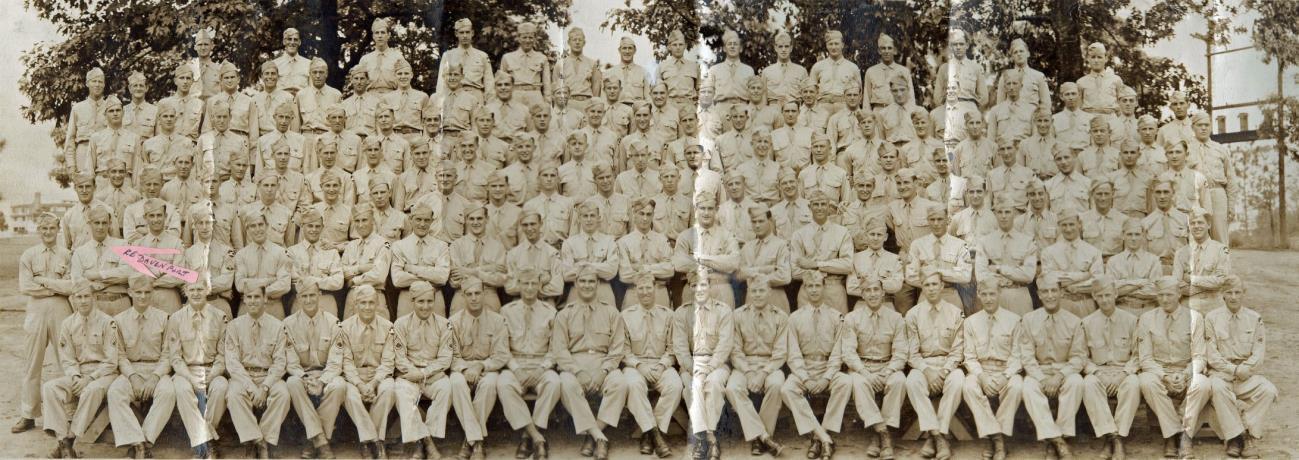
On November 18, 1944, under command of the British XXX Corp the 84th Division went into action at 7:00 am. To the north was the British 43rd Division (Wessex) and the Sherwood Rangers Yeomanry, a crack tank outfit. To the south was the U. S. 2nd Armored Division and the 405th Regiment of the 102nd Division.
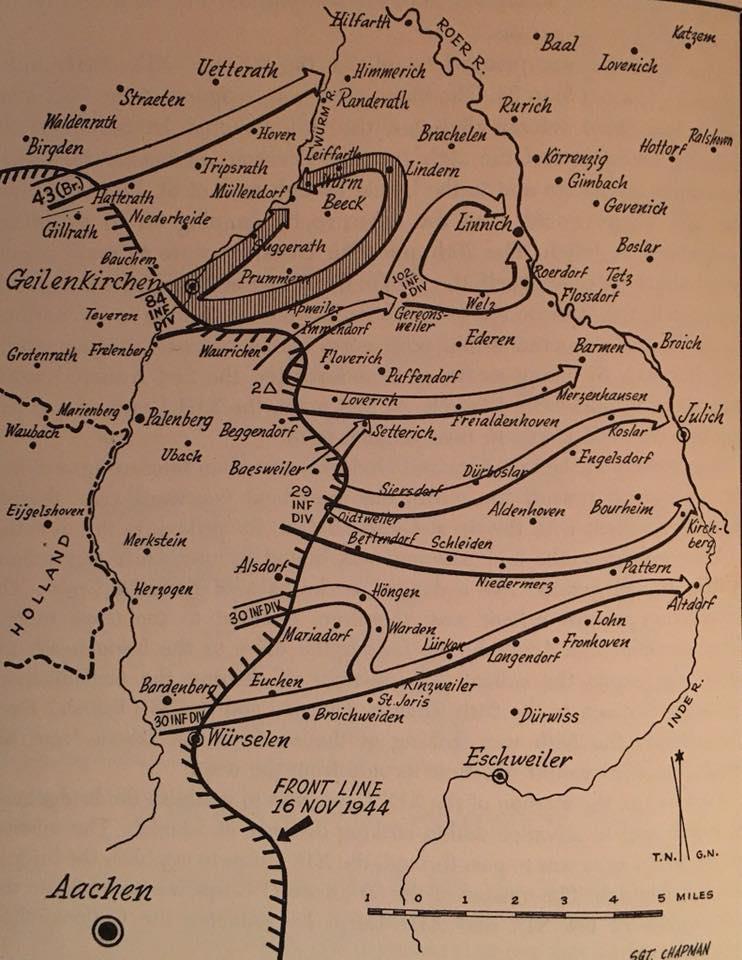
The 84th Division started its battle on the eastern banks of the Wurm River, a 16 33 foot wide river only 2 5 feet deep. Their objective was to capture the town of Prummern, Germany and to hold the ground between Geilenkirchen and Prummern. At the end of the first day, they succeeded in the capture of Prummern and holding the ground as indicated. They also fared better than the plans and also secured the ground between Prummern and Breeck. The story is now told of these battles.
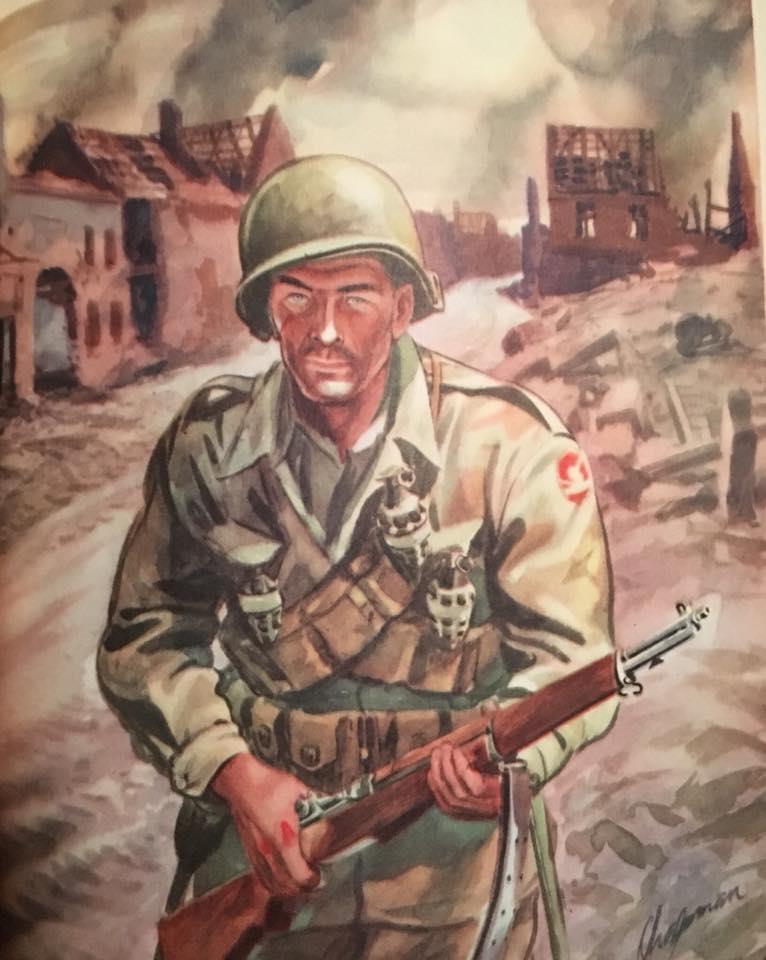
The town of Geilenkirchen on the Ninth Army’s extreme left wing was more than a block severely restricting maneuver space at the line of departure for the November offensive. It also was the hard tip of a German salient or re entrant created and exaggerated by the advance of the XIX Corps northeastward toward Gereonsweiler. Following generally the course of the Wurm River as it winds northeastward between Geilenkirchen and the Roer, the salient formed a wedge between the Second British Army’s 30 Corps west of the Wurm and the XIX Corps between the Wurm and the Roer.
In devising the plan and securing British approval for the 30 Corps to take Geilenkirchen, the Ninth Army commander, General Simpson, had been motivated by the need for a two pronged thrust against the town and by the problems which might have developed had headquarters of different nationalities tried to control the attack. Temporary attachment of the 84th U.S. Division to the 30 Corps had solved the problem. Knowledge that the British in November had greater stocks of artillery ammunition than had the Ninth Army also had influenced the arrangement.
Scheduled originally for D plus 1, the attack was postponed a day in the hope that additional time might drain some German strength from the salient to the front of the XIX Corps. As events developed, the delay prompted no shift of German troops actually in the line, but it did encourage the movement of part of the Army Group B reserve, the 15th Panzer Grenadier Division, to a point from which it might engage the XIX Corps. This did not negate use of the panzer grenadiers in the vicinity of Geilenkirchen, though it did delay their employment there.
Flanked by clusters of West Wall pillboxes, Geilenkirchen sits astride the Wurm River, which is the only terrain feature distinguishing this sector from other portions of the Roer plain. In the valley of the Wurm and on undulating slopes on either side are to be found the same drab farming and mining villages and the same endless rows of stock beets and cabbages that characterize the greater part of the plain. An occasional patch of woods may be found in the valley. "At best," wrote one who was there through the dismal weather of November, 1944, "the Geilenkirchen area was not one of Germany’s more attractive places."
The Geilenkirchen Salient by Charles MacDonald (Siegfried Line Campaign)
Two main highways in the salient laterally bisected the planned northeasterly direction of attack. Though secondary roads connecting the villages were muddy, they were adequate for normal tactical purposes. The Aachen Geilen kirchen Muenchen Gladbach railroad follows the valley for several miles past Geilenkirchen before veering eastward at the village of Wuerm.
Having assumed control of the seventeen mile sector from the Maas River to the vicinity of Geilenkirchen, General Horrocks’ 30 British Corps had positioned the 43nd Infantry Division northwest of Geilenkirchen. South and southeast of the town, between Geilenkirchen and the left flank of the XIX Corps, a regiment of the 102nd Division, the 405th Infantry, held a narrow sector which at this time was the only front line responsibility of the XIII U.S. Corps.
Labeled Operation CLIPPER, the fight to eliminate the Geilenkirchen salient was to develop in four phases. Attached for operations to the British but still tied for other purposes to the XIII Corps, the 84th Division was to make the main effort by passing through the 102nd Division’s narrow sector in early morning of the first day, November 18, two days after the start of the Roer River offensive. Using but one regiment at first, the 84th Division was to take high ground east of Geilenkirchen and about Prummern, two miles to the northeast.
A second phase was to begin about noon on the first day when the 43d British Division was to attack to gain high ground in the vicinity of Bauchem and Tripsrath, villages west and north of Geilenkirchen. In conjunction with the 84th Division’s first attack, this drive was designed to promote virtual encirclement of Geilenkirchen, whereupon the 84th Division was to launch a third phase by moving into the town and continuing a mile and a half northward to Sueggerath in the valley of the Wurm. In the fourth phase, the 43nd Division was to continue to clear the west bank of the Wurm as far as Hoven, three miles to the north of Geilenkirchen, while the 84th Division pushed beyond Sueggerath and Prummern to a trio of villages located near the point where the railroad veers away from the Wurm River. These villages Muellendorf, Wuerm, and Beeck are approximately three miles northeast of Geilenkirchen.
Taking all these objectives would eliminate the German wedge between the British and Americans. The front line then would describe a broad arc from the Maas River near Maasbracht, southwest of Roermond, to the Wurm River at the trio villages, thence southeast to Gereonsweiler. The final boundary between
the XIII and the 30 Corps (and thus between Second British and Ninth U.S. Armies and the 12th and 21st Army Groups) was to follow generally the course of the Wurm to the villages, thence northeastward along the Aachen Muenchen Gladbach railroad.
A successful Operation CLIPPER combined with the 2nd Armored Division’s capture of Gereonsweiler would broaden the Ninth Army’s maneuver space by some five to six miles. As this space became available, General Gillem’s XIII Corps was to assume control of operations in the new sector. After relief of the 2nd Armored Division at Gereonsweiler, General Gillem intended to send the 102nd Division across a remaining two and a half miles to the Roer at Linnich, there to force a crossing. In the meantime, a special force, named Task Force Biddle and composed of the 113th Cavalry Group strongly reinforced with additional tanks and artillery, was to protect the corps north flank. Task Force Biddle was to occupy the sector along the railroad between the trio of Wurm villages and the Roer. Later, the 84th Division and the recuperated 7th Armored Division were to join the 102nd Division in the Roer bridgehead at Linnich to make the final push to the Rhine.
No immediate British participation, once Operation CLIPPER had been concluded, was planned, though the 30 Corps did contemplate a later local advance along the west bank of the Wurm to high ground overlooking Heinsberg, seven miles north of Geilenkirchen near the confluence of the Wurm and the Roer.
The British intended eventually to drive either southeast from Nijmegen or northward from Nijmegen, but extensive preparation and reorganization were necessary before the drive could be undertaken. Other than Operation CLIPPER, the only British offensive action coincident with the November offensive was the continuing drive to clear the Peel Marshes west of the Maas River. As events developed, the fact that no large scale offensive was launched by the British not even a large scale feint worked to the detriment of the November offensive. It enabled the Germans to shift divisions from the front of the 21 Army Group to oppose the First and Ninth U.S. Armies.
Since virtually all German reserves in the West had been marked "untouchable" in preparation for the Ardennes counteroffensive, the Commander in Chief West could obtain reserves only by denuding fronts not considered immediately threatened. Hardly had Field Marshal von Rundstedt received the reports on November 16 of the multiple strikes in the vicinity of Aachen before he divined the extent of the Allied offensive. He immediately ordered the shift of the 10th SS Panzer Division from the Holland front to the extreme south wing of Army Group H where it could be committed quickly in support of Army Group B
He also took steps to prepare a volks grenadier and two infantry divisions for movement from Holland to the same sector.
On November 17 Rundstedt found justification for these moves in the intelligence that the 104th U.S. Division, identified earlier in the Antwerp fight, had been moved to participate in the new offensive. By November 18 Rundstedt had gained even greater confidence in his situation estimate and his decisions: To date [OB WEST noted] there are no indications for an equally strong British attack against the Maas front [in Holland], coordinated with the present offensive. The relatively feeble attacks against the Venlo Bridgehead [i.e., the Peel Marshes] even speaks against such a possibility. Hence . . . OB WEST orders the immediate transfer of 10th SS Panzer Division to Army Group B.
Subsequent events were to demonstrate even more clearly that the offensive was confined primarily to the American part of the front. During the course of the fighting west of the Roer, the Germans were to move from Holland to active participation against the U.S. armies not only the 10th SS Panzer Division but also the 3nd Parachute Division and an infantry and a volks grenadier division.
As to the immediate situation at Geilenkirchen on the eve of the 30 Corps attack, the German line up was the same as it had been two days before when the November offensive began. Both Colonel Landau’s 176th Division, northwest of Geilenkirchen, and General Lange’s 183rd Volks Grenadier Division, in and southeast of the town, had concentrated their greatest strength about Geilenkirchen. Here also General Blumentritt, commander of the XII SS Corps, had emplaced the bulk of his artillery.
Attacking two days behind the main forces in the November offensive, the 30 Corps could count upon little direct assistance from the big air bombardment of Operation QUEEN, though Linnich and Heinsberg were scheduled to be hit. The 30 Corps counted instead upon a steady softening process by fighter bombers which began as early as November 8 with a napalm strike against Geilenkirchen. Assistance was to be provided by both the Second British Tactical Air Force and the Ninth Army’s usual ally, the XXIX TAC. At least two groups of XXIX TAC fighter bombers were to operate on November 18, D Day for Operation CLIPPER.
In addition to artillery support to be expected from the 30 Corps, the 84th Division was reinforced by two U.S. battalions attached from the XIII Corps. Because position areas in the congested sector between the
Maas and the Wurm were at a premium, four other artillery battalions available in XIII Corps were not to participate.
In its first combat experience, the 84th Division had two handicaps: inexperience and only two instead of its usual three regiments. (The third was attached to the 30th Division of the XIX Corps at Wuerselen.) In the first step of the attack, the division was to be reinforced by a special British unit named Drewforce, which included two troops of flail tanks, and by a troop of the 357th Searchlight Battery, Royal Artillery, manning four giant beacons. A flail tank had a rotor in front to which were attached heavy chains that flailed the ground as the rotor was driven by the tank engine. The searchlight provided "artificial moonlight" on dark nights by bouncing light off low hanging clouds.
By light of the searchlights, the flail tanks before dawn on November 18 were to clear two paths through a thick mine field which the 84th Division had to cross. The mine field was southeast of Geilenkirchen, south of a spur railroad running from Geilenkirchen into the sector of the XIX Corps at Immendorf and Puffendorf and on to Juelich. Because the number of flail tanks for piercing the mine field was limited, the division commander, Brig. Gen. Alexander R. Bolling, decided to use only one, regiment at first. The 334th Infantry under Col. John S. Roosma was to capture high ground east of Geilenkirchen and at Prummern, whereupon on the second day, the 333rd Infantry was to attack Geilenkirchen and proceed up the Wurm valley to Sueggerath. Both regiments presumably would combine for the final push into the trio of Wurm villages, Muellendorf, Wuerm, and Beeck.
As D Day for Operation CLIPPER approached, the atmosphere as influenced by progress of the main forces in the November offensive was conducive neither to elation nor to discouragement. Early success of the adjacent 2nd Armored Division, for example, had been tempered by arrival of the 9th Panzer Division. During the evening of November 17, reports of tank concentrations near Geilenkirchen convinced the staff of the 84th Division that a prompt counterattack from the direction of Geilenkirchen was "very probable"; but the news failed to deter General Bolling from proceeding as scheduled. He might, he said, "beat the Germans to the punch."
As British searchlights provided hazy illumination across the fields between Geilenkirchen and Immendorf, the flail tanks of Drewforce at 0600 on November 18 churned toward the German mine field. Because
mud gummed the flail chains and lessened their effectiveness, engineers checked behind the tanks with mine detectors. Only desultory German fire interfered.
An hour later, after a sharp five minute artillery preparation, two battalions of the 334th Infantry began moving through the two gaps in the mine field. Concealed by the fading darkness, neither unit encountered accurate fire while passing through the gaps. On the west, attached British tanks could not accompany the advance at first because of deep mud, but the 2d Battalion nevertheless plodded ahead through use of marching fire and small unit maneuver. By midmorning the battalion had gained the high ground east of Geilenkirchen. On the regiment’s right wing, the 1st Battalion was held up for a while along the spur railroad by a cluster of ten pillboxes, an intermediate objective en route to Prummern. The battalion commander, Lt. Col. Lloyd H. Gomes, moved among his platoon leaders encouraging them to urge their men forward. Once the men had overcome the temptation to court the protection of the railroad embankment, they used marching fire to advantage. When they had driven the Germans from trenches into the pillboxes, they discovered as had others before them that this was three fourths of the battle.
Still concerned lest the Germans counterattack from Geilenkirchen, the regimental commander, Colonel Roosma, delayed the final push to Prummern until he could send his reserve battalion to hold the high ground east of Geilenkirchen. Though an expected counterblow by the 9th Panzer Division had failed to develop, Colonel Roosma had another reason for concern. In midmorning, artillery observers of the 30 Corps had reported a force of 4,500 men in a column of tanks and vehicles stretching for three and a half miles en route south from Heinsberg in the direction of Geilenkirchen. These observers probably were correct in assuming this to be part of the 15th Panzer Grenadier Division. That division was moving, however, not to Geilenkirchen but, in compliance with orders issued the night before, to back up the 9th Panzer Division opposite the XIX U.S. Corps.
To relieve the 84th Division of some concern, the XIII Corps commander, General Gillem, alerted two regiments of the 102nd Division for possible commitment in event of a German blow. When by midday the Germans had not struck, the 334th Infantry resumed the attack in the direction of Prummern. The 2nd Battalion on the right aimed at the village, while the 1st Battalion moved toward Hill 101, west of the village.
Routes to both these objectives were across exposed ground, and the Germans by this time obviously were alert. Working with attached British Sherman tanks, both battalions nevertheless made steady progress. By late afternoon the 334th Infantry could report both Hill 101 and Prummern in hand, though some resistance still had to be eliminated in the village. The defenders of Prummern represented both the 183d Division and the 9th Panzer Division’s 10th Panzer Grenadier Regiment. In a commendable operation, the novice 334th Infantry had taken its D Day objectives, bagged 330 prisoners, and reached a point almost on line with Task Force X of the 2nd Armored Division, which during the day had occupied Apweiler, a mile and a half southeast of Prummern. American losses had been moderate: 10 killed and 180 wounded.
On the opposite side of Geilenkirchen and the Wurm River, the 43rd British Division had attacked about noon on 18 November. By the end of the day the British controlled Tripsrath and most of Bauchem, north and west of Geilenkirchen. The day’s advances on both banks of the Wurm obviously had taken the starch out of the hard tip of the Geilenkirchen salient. Allied forces now looked down upon the town from three sides.
Having learned much during their first day’s combat, men of the 334th Infantry had another lesson in store as dusk approached. What is listed as a day’s final objective, they were to discover, sometimes can change to an intermediate objective with surprising abruptness. Even as the 1st and 2nd Battalions were fighting for Hill 101 and Prummern, the division commander, General Bolling, directed that they continue past these objectives before stopping for the night. On the left, the 1st Battalion was to push a company northwest along a nose of Hill 101 to gain a position dominating Sueggerath and the Wurm valley, while the 2nd Battalion was to seize high ground northeast of Prummern in the direction of Beeck, an objective known by the code name given it as Mahogany Hill (Hill 92.5).
Out of context, this order must have been hard to understand; for as night approached, both battalions had incurred the disorganization inherent in a day of fighting, and the men were cold, muddy, and hungry. Yet, in the over all pattern, taking advantage of the momentum of the day’s advance to get these additional objectives before pausing made sense. The 30 Corps commander, General Horrocks, had directed during the afternoon that the 84th Division the next day combine the third and fourth phases of Operation CLIPPER. On November 19 the 84th Division was to take Geilenkirchen and Sueggerath and, on the same day, the trio of villages Muellendorf, Wuerm, and Beeck. Holding the tip of Hill 101 overlooking
Sueggerath obviously would facilitate, advance of the 333d Infantry into Sueggerath and beyond against Muellendorf and Wuerm. Occupying Mahogany Hill would provide the 334th Infantry high ground between Prummern and Beeck that would improve the defense of Prummern and at the same time assist materially an attack upon Beeck.
As night fell on November 18, the attached British searchlight battery moved forward. The attack continued.
A company of the 1st Battalion made the move along the nose of Hill 101 with little real difficulty, but in Prummern the 2nd Battalion could not get an attack started against Mahogany Hill. Men of Colonel Gomes’ battalion were too involved still with eliminating points of resistance within the village.
Only a reconnaissance patrol moved toward Mahogany Hill during the night. Returning two hours after midnight, the patrol brought back disturbing news. The men had spotted six German tanks moving against Prummern from the north.

The blow that followed was delivered by an estimated two companies of the 9th Panzer Division’s 10th Panzer Grenadier Regiment, plus six tanks. Though the situation never reached critical proportions, the men in Prummern had their hands full the rest of the night and into the next day.
The result was that no attack could be mounted against Mahogany Hill until an hour before noon the next day, November 19, when Colonel Roosma committed his reserve battalion to the task. Fire from three pillboxes atop the hill, from two pillboxes at a crossroads in the northeastern fringe of Prummern, and from field fortifications on the eastern edge of the village stymied this attack. For another day Mahogany Hill remained somewhat aloof from the fighting while the Americans tried to eliminate the last resistance from the fringes of Prummern.
This they finally accomplished late on November 20 with the help of flame throwing British Crocodile tanks, used against the pillboxes at the crossroads. Mahogany Hill itself was to fall two days later after only a token engagement as a company caught the Germans atop the hill by surprise.
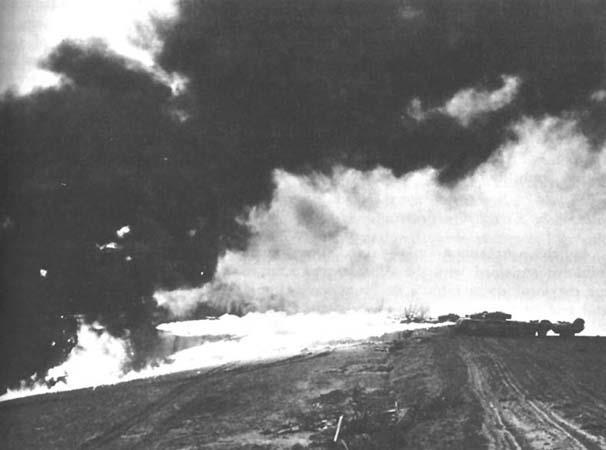
The nature of resistance at Prummern emphasized to the 84th Division commander, General Bolling, a concern which had begun to grow during the first day of Operation CLIPPER. Instead of the division’s west flank opposite Geilenkirchen, the danger spot fast was beginning to look like the east flank between Prummern and the closest positions of the 2nd Armored Division a mile and a half to the southeast at Apweiler. "Our flank is sort of out in the breeze now," was the way General Bolling put it on November 19 after his second regiment had begun to attack up the Wurm valley. "Our chief concern . . . is our right flank. The 2nd Armored Division has advanced only to Immendorf Apweiler. I have pushed a salient up the river valley and they [the armor] haven’t advanced."
Though certainly aware of why the 2nd Armored Division had not advanced because of the 9th Panzer Division’s counterattacks and because a main supply route through Setterich still was not open—General Bolling’s superiors apparently shared his concern. Early on November 19 they provided help in the form of the 102nd Division’s 405th Infantry. The regiment was attached to the 84th Division with the proviso that it be committed "only in case of emergency."
As this precaution was taken, the initiative remained with the Allies except for the local counterattack at Prummern and one or two minor forays out of the Wurm valley against the British. Expected commitment of the 15th Panzer Grenadier Division against the XIII Corps still had not developed.
On November 19, the 84th Division’s second regiment, the 333rd Infantry, launched another phase of Operation CLIPPER at Geilenkirchen amid an aura of success. Advancing up the Wurm valley to seize successively Geilenkirchen, Sueggerath, Muellendorf, and Wuerm, the 333d Infantry discovered early on November 19 that Geilenkirchen was not the Gibraltar it was supposed to be. Already encompassed on three sides, the Germans in the town provided little more than a stiff delaying action.
The biggest problem in the attack, explained the leading battalion commander, Lt. Col. Thomas R. Woodyard, was lack of artillery support. "After the artillery preparation for the jump off," Colonel Woodyard said later, "we received no artillery support because it was considered that our own troops, on the flanks, were too close . . . for safety in firing." Though two attached troops of tanks from the British Sherwood Rangers Yeomanry provided close support, they could not make up entirely for lack of artillery.
While another battalion mopped up in Geilenkirchen, Colonel Woodyard’s battalion continued northeast on either bank of the Wurm toward Sueggerath. Marked by increased shelling, resistance stiffened, but the battalion plodded ahead. Flame throwing Crocodiles were a big help, especially against two pillboxes guarding the road into Sueggerath. "A few squirts from the flame throwers," related an infantry company commander, Capt. James W. Mitchell, "and the Germans poured out . . . . The bastards are afraid of those flame throwers and won’t be caught inside a pillbox . . . ."
Within Sueggerath, the Germans were not so easily cowed. Though one company pushed quickly through the village, bypassed strongpoints continued to hold out. As night came, Colonel Woodyard’s battalion still was heavily engaged in Sueggerath. Because the village sits in a depression, Colonel Woodyard wanted to continue to high ground a few hundred yards to the northeast; yet he was concerned that the day’s losses and disorganization had so weakened his battalion that he could not reach that objective alone. Not until near midnight was the regimental commander, Col. Timothy A. Pedley, Jr., able to get another battalion forward to help. An attack by both battalions in the darkness did the job.
At the conclusion of this attack, the 333rd Infantry still was more than a mile short of the final objective of Wuerm.
Nevertheless, the bulk of the Geilenkirchen salient had been eliminated. If the regiment could adjust its positions to tie in with the British to the northwest and with the 334th Infantry to the southeast, the 30 Corps could present a solid and fairly straight front line. Still concerned lest the 15th Panzer Grenadier Division materialize against the 84th Division’s southeastern flank, General Bolling told Colonel Pedley to take precautions against this possibility during the third day, November 20. In the meantime, the 334th Infantry was to clear the last dogged resistance from Prummern. Both regiments then might renew the attack on the fourth day against Muellendorf, Wuerm, and Beeck.
On this fourth day, November 21, an exercise in frustration began. Through the preceding day and night, rain had fallen intermittently. Early on November 21 it became a downpour that turned the loamy soil of the Wurm valley into a virtual quagmire. Because the road from Sueggerath toward Muellendorf and Wuerm obviously was mined, British tanks supporting the 333d Infantry would have to wade through the mud. Though the tankers tried to use an alternate road along the railroad, debris at a demolished underpass in Sueggerath blocked movement in that direction.
The immediate problem facing Colonel Pedley’s infantry was a nest of pillboxes on a gentle forward slope where the Germans could employ grazing fire with devastating effect. Attacking alone time after time through mud and rain, the infantry could get no place. "Christ!" exclaimed the battalion commander, Lt. Col. William S. Barrett; "I wish I could get some help . . . . Tell Colonel Pedley that these men are fighting and dying up here. No one is lying down. But we gotta have power to do this thing."
That night engineers tackled the underpass in Sueggerath with explosives while artillery officers worked out an elaborate fire plan. To protect infantry and tanks, whose movement in the mud would he snaillike at best, artillery of the 84th Division and the 30 Corps was to lay down a rolling barrage. The barrage was to begin even before the tanks left Sueggerath, because the tankers had several hundred yards of exposed ground to cross before reaching the infantry positions.
Sometimes the best laid battle plans can go awry for the want of a single piece of equipment. That happened on November 22 when a bulldozer failed to arrive to complete the task of clearing the underpass in Sueggerath so that the tanks might move. Not until midafternoon, after the infantry already had jumped off and run into much the same frustration as on the day before, did the tanks get forward.
To the relief of all concerned, the tanks were all that was needed. As flame throwers on the Crocodiles went into action, the Germans emerged from the nest of pillboxes that had barred the way, hands high. Three pillboxes fell in rapid succession.
This success was encouraging, but the objective of Muellendorf still was 500 yards away. Because the heavy fuel wagons which the Crocodiles had to pull were bogging in the mud, the tank commander refused to go farther. When the riflemen tried to move alone into the village, they encountered the same kind of intense grazing fire that earlier had denied the pillboxes. As night came, one platoon broke into the village, only to be engulfed without trace in the darkness. At last the infantry dug in about the pillboxes, still a half mile short of Muellendorf.
The change from half hearted to stanch resistance was not confined to the Muellendorf sector alone. On both November 21 and 22 the 43d British Division also encountered opposition which denied the division’s final objectives on the other side of the Wurm River northwest of Muellendorf. Likewise, in the sector of the 334th Infantry, frustration again was the keynote. A one battalion attack from Prummern against Beeck was repulsed by the same sharp resistance and the same appalling conditions of mud.
Though frustrating, the attacks as early as November 21 did reveal an illuminating bit of intelligence information. Prisoner identifications all along the front of the 30 Corps left no doubt that the iron which the Germans had added to their resistance was the 15th Panzer Grenadier Division. Having first employed the panzer grenadiers in counterattack against the XIX Corps, the Germans then had committed most of the division to fixed defense in front of the 84th Division.
Concern about the 84th Division’s southeastern flank alleviated by this identification, General Bolling sought permission to reinforce his attack with the regiment of the 102nd Division which had been provided three days before for use in event of emergency. General Bolling wanted to send two battalions of this regiment to flank the village of Beeck by seizing high ground on the east and north, while the remaining battalion struck frontally and two battalions of the 84th Division provided fire support.
Approval gained, the 102d Division’s 405th Infantry attacked toward Beeck on November 22, only to discover as had the other regiments that a combination of mud and exposed ground was too much. The fight swung up and down the open slopes between Prummern and Beeck. Though several pillboxes were eliminated and forty Germans captured, no major gain could be registered.
Before the attacks at Muellendorf and Beeck could be renewed, an organizational change took place. As early as November 20, the two Allied divisions under the 30 Corps had cleared the major portion of the Geilenkirchen salient, even though the final objectives still were denied. Coincidentally, the armor of the XIX Corps had captured Gereonsweiler. Thus the two requisites for providing a zone of action for the XIII Corps had been fulfilled. As of November 23, the 84th Division and its attachments reverted to control of General Gillem’s XIII Corps.
The 84th Division’s attack at Muellendorf and Beeck continued through November 23, but to no avail. At the end of the day, General Gillem directed the 84th to go over to the defensive. For five more days the 84th Division was to hold here while the 113th Cavalry Group gradually took over to maintain contact with the British and while General Gillem prepared his XIII Corps for participation in the final phase of the drive to the Roer. In early plans, the XIII Corps was to have begun to attack on November 23, but that obviously was illusory in the light of the hard fight experienced by the 84th Division and of the scattered position of the regiments of the 102d Division in clearing the Geilenkirchen salient, the two regiments of the 84th Division together had incurred approximately 2,000 battle casualties, including 169 killed and 752 missing.
Nonbattle losses, primarily from trench foot, raised the total by another 500. Over 1.600 Germans from 15 various German units were captured in these battles and a further 120 Pillboxes were destroyed. The “impenetrable” German Siegfried Line was broken through and was in shambles! Among the dazed German POWs was a veteran officer, stunned by what had happened. “We knew we were facing new troops and expected it to be easy,” he said, “but these men fight better than any troops I saw in Africa, Russia and France.”
What lay ahead was the crossing of the Roer River (a challenging and deadly crossing for many), the Ardennes Campaign and the Battle of the Bulge with its’ bitter cold and heavy snows!!!
While eight battles had been fought and won, a kind of temporary stalemate from November 24 – 26 now settled over this part of the Roer plain. The battlefield they left was a dreary spectacle where the sun seldom shone. A damp, grayish mist predominated the scene. Sodden by rain, gashed by shells and tank tracks, the beet and cabbage fields were dismal and ugly. It was drab enough at the start of the fighting, but the villages now were desolate and the battles had just begun and the 334th had covered just 5 miles to get to this point!


Here are some more photos of the battlefields where Frank Micheals fought. These photos are from the actual battle scene in November 19 23, 1944. Much of the land was flat. A few places had some rolling hills, which made it difficult for the 334th Infantry Regiment to advance as the Germans made Pillboxes at the top which were concrete fortified rooms complete with machine guns. The Germans also created barriers (called the Siegfried Line) to prevent easy and wide access by Allied tanks and cannons. The 334th and Frank did advance though with sheer courage and bravery.
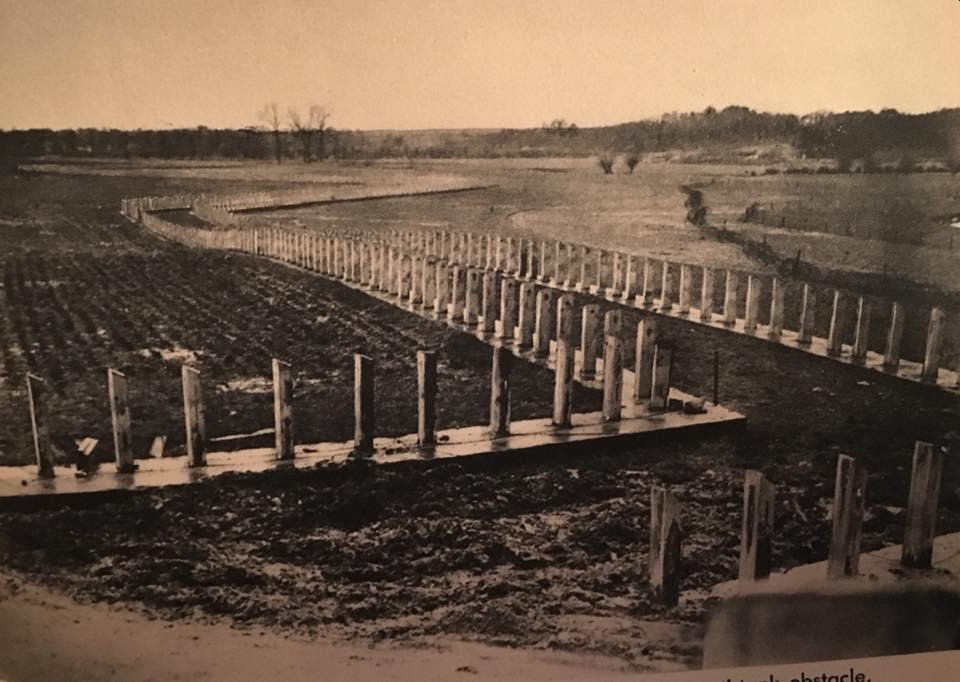
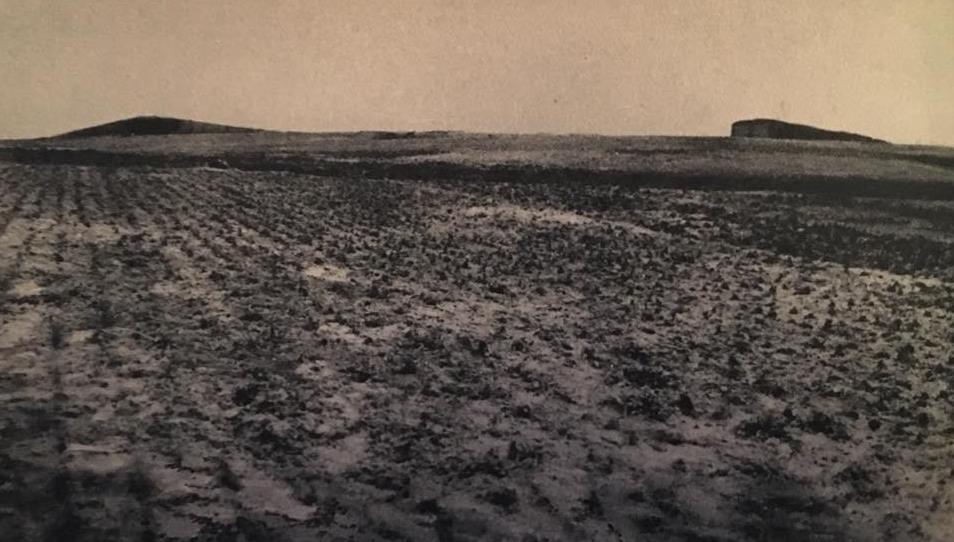
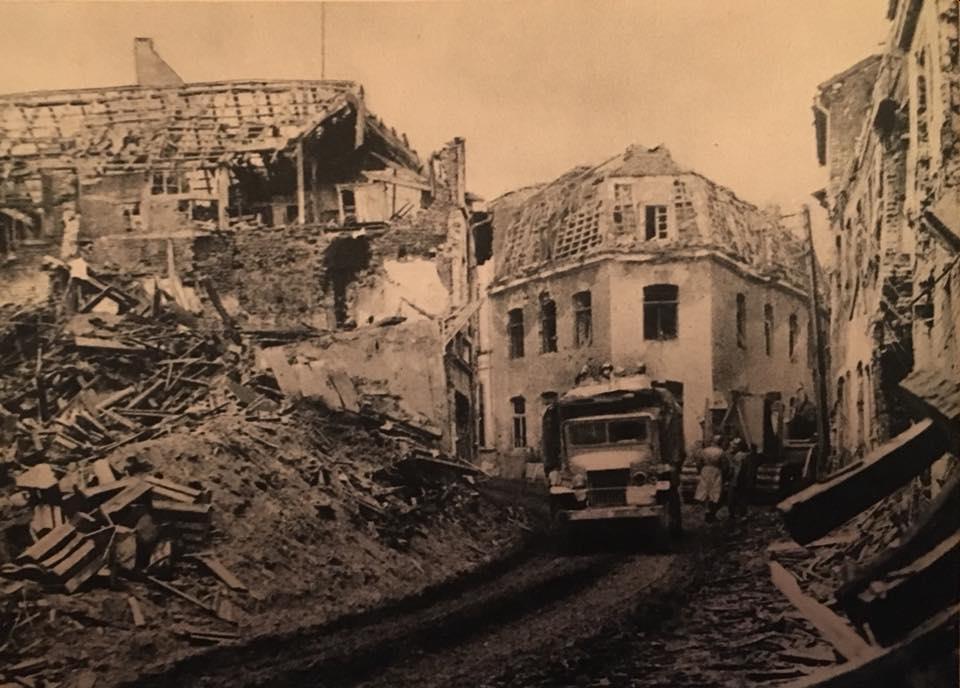
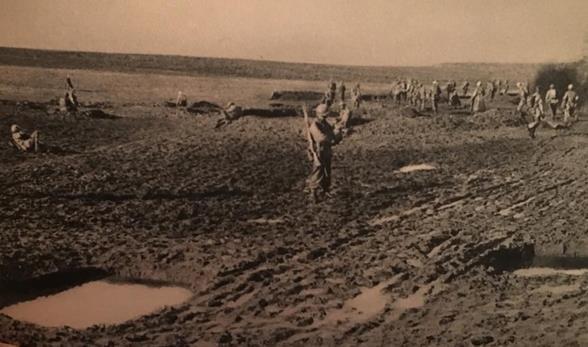
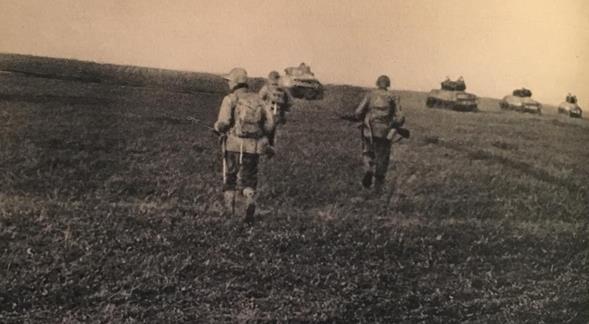
Frank operated a 90 mm canon as his main duty in WWII. That was as part of a canon team. While he was initially assigned to the 553rd AAA (Anti Aircraft Artillery) Mobile Battalion, Battery C. Eventually he became part of operating a 90 mm canon in the 84th Infantry Division, 334th Infantry Regiment, 3rd Battalion, Company M.

In reading about the military action of the 334th Infantry Regiment, it seems as if the 1st and 2nd Battalions of the 334th were the ones that did the initial assaults in a battle with the 3rd Battalion held in reserve to either provide backup forces or to do mopping up operations to clear an area completely of enemy combatants. As part of the 3rd Battalion I also discovered that Company M was where the artillery men were located. They were often called on to support pre battle shelling and to support forward assaults where cannon fire was needed.
The 90 mm cannon crew Frank was a part of could have been mobile as shown in one of the pictures or it could have been stationary as another photo shows. In either case the men of Company M worked as a team which consisted of a radar team, a generator team, a search light team and then the actual canon
team. In any case, Frank was involved in real fighting and actually shelling of things like Pillboxes, tanks or in shooting down German aircraft.
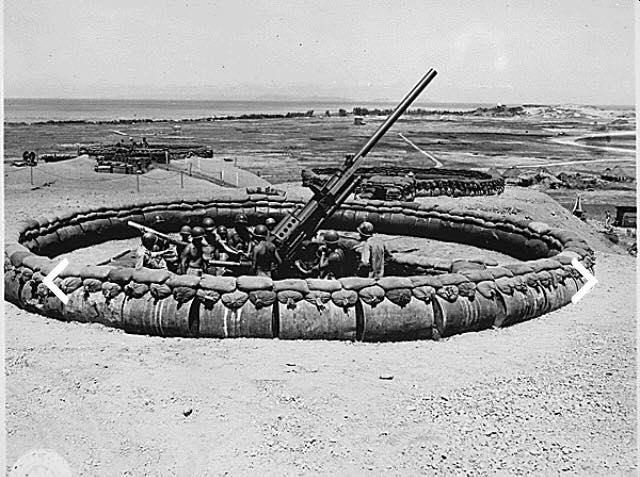
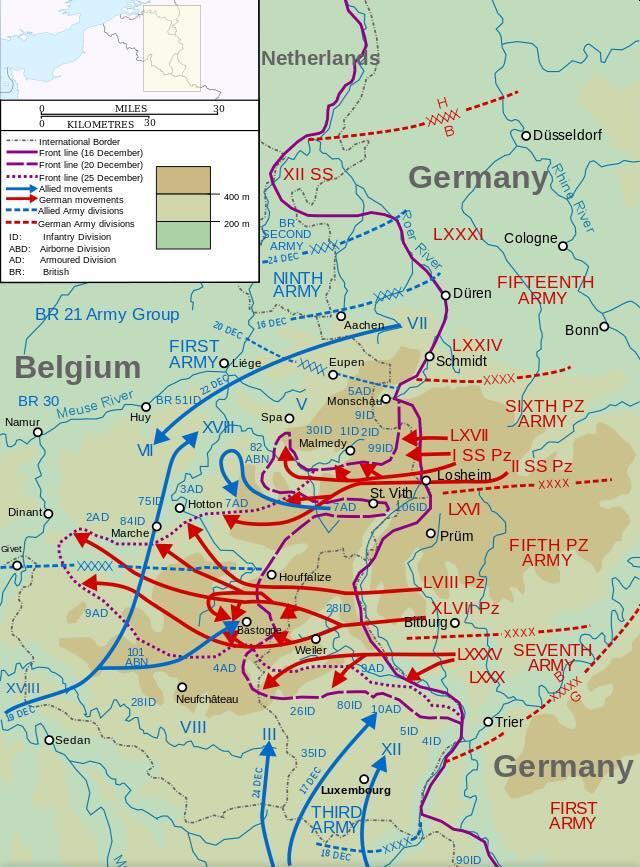
After the 84th Infantry Division Frank had finished mopping up operations in the towns of Prummern, Beeck, Lindern and eventually the town of Linnich, the plan was to cross the Roer River which lay ahead. However, those plans were delayed because the Germans had plans to retake what they lost and so they launched a plan that became known to the world as the “Battle of the Bulge”.
The 84th Infantry Division was part of the Nonth Army and you can see from the photo below where they were stationed on December 16,1944 when that battle began and below that you can see where the fighting took place. The 84th was called into action and was one of the main divisions called to fight. Yet for Frank, he saw no direction action in the campaign known in military circles as the Ardennes Campaign.
On November 27, 1944, the Ninth Army renews its attacks along the entire front and engages in fierce fighting with a determined enemy. Two days later on November 29 nine artillery battalions attack with infantry support and progress is made in capturing some towns.
From November 30 to December 4, 1944 fighting continued, but little new progress was made. By December 4 the 84th Division was ordered to be deployed along an arc of some twelve miles reaching
from Hogne, northwest of Marche, through Waha, south of Marche, and then bows back to the northeast in front of the Marche Hotton road.
Roads from Maastricht to the battle front deteriorate due to heavy rains and flooding. Telephone lines also deteriorate. Work was done to correct these supply problems. Some troops also stop fighting to fix road and communication problems. Difficulty in transportation caused casualties to mount. A cemetery was created nearby in the town of Margraten, Holland to bury the dead.
The leaders of the 84th Infantry Division’s 334th Infantry Regiment’s 3rd Battalion. Frank would have known all these men.
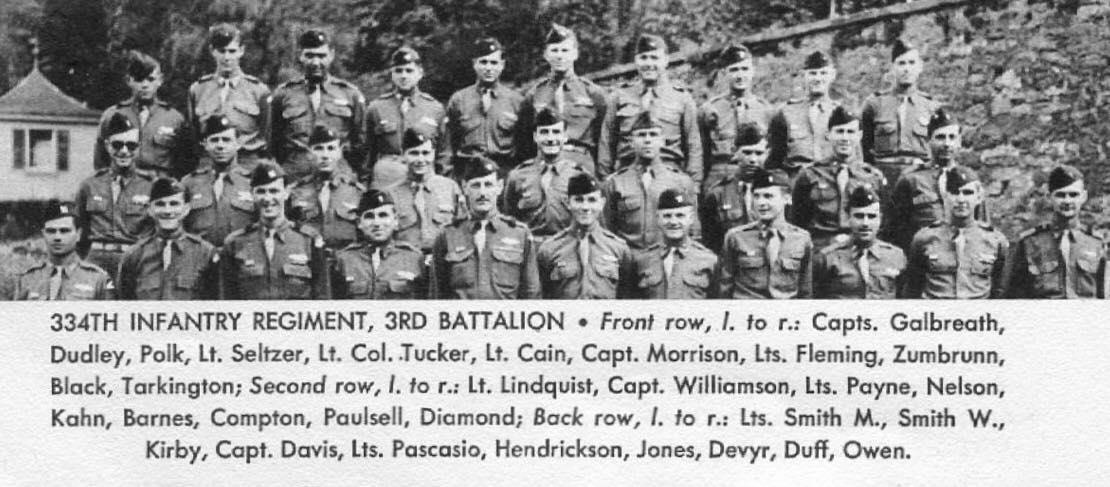
While there were a large number of Army units engaged in the battle known as the Battle Of The Bulge, the 84th Infantry Division would play a significant part and the 334th Infantry Regiment Frank was assigned to of particular importance. The battle began on December 16, 1944 and for Germany it had one purpose and that was to break the Allied line of defenses and retake the port city of Antwerp.
The Germany military amassed large number of men, tanks and artillery and had begun to move into previously held Allied territory. They created a bulge into an Allied controlled area from their victories which had the potential to divide the Allied troops and create a pathway to the sea. To stop this incursion, the 84th Infantry Division was called into action. Previous plans to cross the Roer River had to be put on hold and instead they had to engage the enemy in this important battle.
The 84th Infantry Division commander, Brigadier Gen. Alexander R. Bolling ordered his leading combat unit, the 334th to make their way into battle. Here is one account of the initial day:
“The first word of an attacking enemy reached the 84th Division command post in Marche, Germany at 0900, but the attack was being made at Hotton, to the northeast, where the 116th Panzer Division had thrown in an assault detachment to seize the Ourthe Bridge. General Bolling ordered the 334th under Lt. Col. Charles E. Hoy, to establish a perimeter defense around Marche. Meanwhile the 51st Engineer Combat Battalion asked for help in the Hotton fight. But when troops of the 334th reached the scene in midafternoon, the embattled engineers, aided by a few men from the 3rd Armored Division, had halted the enemy and saved the bridge a feat of arms subsequently acknowledged by the German corps and army commanders.
About noon Bolling received word from the XVIII Airborne Corps that the 334th was to hold the enemy south of the Hotton Marche line, both these villages to be the responsibility of his division. A few minutes later a corps message arrived saying that fifteen German tanks and an infantry company had been reported five miles southeast of Marche in the hamlet of Bande and that they were heading west.
By this time General Bolling had a more precise statement of his mission, for he had telephoned army headquarters about eleven o'clock to report the enemy blow at Hotton and to ask whether his single RCT
should be committed to battle on the Marche Hotton line. The answer was "Yes, hold." The question posed by the commander of the 84th had been much in the minds of Hodges and Collins that morning. With the German armored spearheads breaking out toward the west, the risk entailed in assembling the VII Corps piecemeal as far forward as Marche was very real, and the American commanders considered that perhaps the corps concentration should be made farther back to the north.”
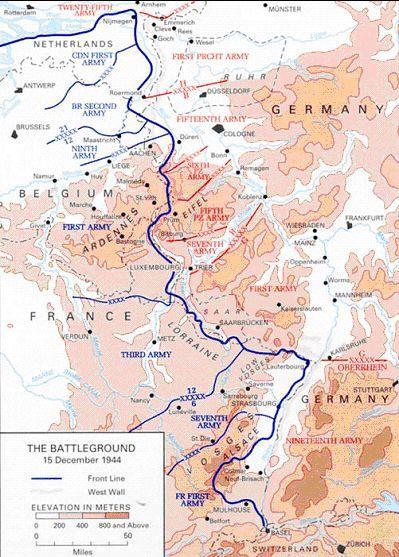
So, the question that needed to be asked was where was Frank when this battle started. I asked him one day and here is the story he told me:
He was scheduled to go into the Battle of the Bulge with the rest of his 334th Infantry Regiment. However, he went on to explain that at the last minute he was called to ‘rear guard’ to Liege, Belgium to guard General William Simpson’s headquarters. So, while his comrades marched off to war, Frank took up the role of a guard and he never saw that battle even from afar. He didn’t tell say where General Simpson was located, but it was far enough in the rear that the battle did not come near to him.
Reflecting on that situation, Frank stated that later in life he came to realize that God’s hand was on him that time, preserving his life and setting him on a course that God used to lead him to his future wife Sue, to the Gospel and to Christ’s salvation
We’ll save a connected story to this one for later, but sufficient to say that Frank’s life was saved by God at this point by a decision of some commander to call him to rear guard. Many in Frank’s 84th Infantry Regiment did not come back alive. Overall, by the time this battle ended, 19,276 Americans were killed in the Battle of the Bulge. That was more than in any single battle of World War II. Yet for Frank, God’s invisible Hand was on him and he returned from the war unscathed!
The 84th Infantry Division counted its prisoners which numbered 592. The entire cost the 84th Division 112 killed, 122 missing, and 348 wounded.
• The coldest, snowiest weather “in memory” in the Ardennes Forest on the German/Belgium border.
• Over a million men, 500,000 Germans, 600,000 Americans (more than fought at Gettysburg) and 55,000 British.
• 3 German armies, 10 corps, the equivalent of 29 divisions.
• 3 American armies, 6 corps, the equivalent of 31 divisions.
• The equivalent of 3 British divisions as well as contingents of Belgian, Canadian and French troops.
• 100,000 German casualties, killed, wounded or captured.
• 81,000 American casualties, including 23,554 captured and 19,000 killed. 1,400 British casualties 200 killed.
• 800 tanks lost on each side, 1,000 German aircraft.
• The Malmedy Massacre, where 86 American soldiers were murdered, was the worst atrocity committed against American troops during the course of the war in Europe.
• Most of these casualties occurred within the first three days of battle, when two of the division’s three regiments was forced to surrender.
On February 3, 1944, a month after the victory in the Battle of the Bulge, the 334th Infantry Regiment and Frank regrouped in the Prummern, Beeck and Lindern area they had previously conquered. What lay ahead was the crossing of the Roer River.
After the Battle of the Bulge the allies had two major physical obstacles to overcome in order to get to the nerve center of the Germany military and bring an end to the war. These obstacles each had their own significance and surprisingly not what you would think.
What lay immediately ahead for the 84th Infantry Division was the Roer River. At first glance, this should have been the easiest of rivers to cross. The rivers previously crossed by the 84th such as the Seine, Somme and the Meuse were much greater rivers and had been fairly easy to get across. It was only 2 5 feet deep most of the year and only 60 85 feet wide and while the depth rose to 12 feet in the winter it didn’t seem too much of an issue. However, the Roer River had been in their sights for almost three months and had not been crossed. Yet it became a difficult one to cross. Why was that?
The Germany army was well aware of the terrain in and around the Roer River. After all, it was inside the borders of their country and many German families had spent many leisure hours on its banks having picnics and allowing their children to frolic in the river. There was little to stop even the youngest of lads from wading into the waters. And that was just the point! It was the easiest of rivers to cross and what lay on the eastern shores is what concerned the Germany army.
Thus the German army was determined to stop the allied advance at all cost! Not only was the Battle of the Bulge an attempt to regain the port of Antwerp, but is was also an attempt to distract the allies from crossing the Roer.
So significant was stopping the allies at this juncture that the German military began drawing up plans to flood the area. To do that, the dams in the area would need to be destroyed so that the Roer would become a major obstacle.
The allied commanders had plenty of time to survey the area and understand what was being considered. The slow advance against the Germany army was costly in lives lost, but strategic for planning. Careful study was made of the area and the allies soon learned what the Germans already knew. Thus, plans were made by the allies to attack and then secure the dams in the area.
By February 10, 1945 the allies controlled the western side of the Schwammanauel Dam. However, the Germans had destroyed the valve house and had by this time opened the gates of the Hembach Dam. They had also blown up the Urft Reservoir. As a result, the Roer River was now 11 feet deep and it mostly stayed that depth for the entire month of February and into March.
While all things may seem equal, they weren’t! The eastern side of the Roer was the high ground. That was where the German army was perched! The western side, where the 84th lay was the low ground. That meant a strategic advantage for the Germany military. Any advance by the 84th would be quickly spotted and artillery shells could be accurately aimed at advancing troops. Plus, the flooding of the low area also meant the river was a much wider one and the approach very muddy. Thus, when the 84th would advance, they would advance slowly.
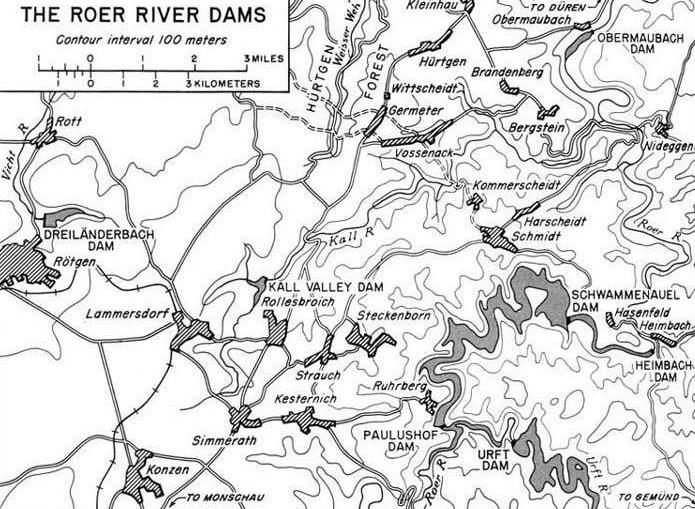
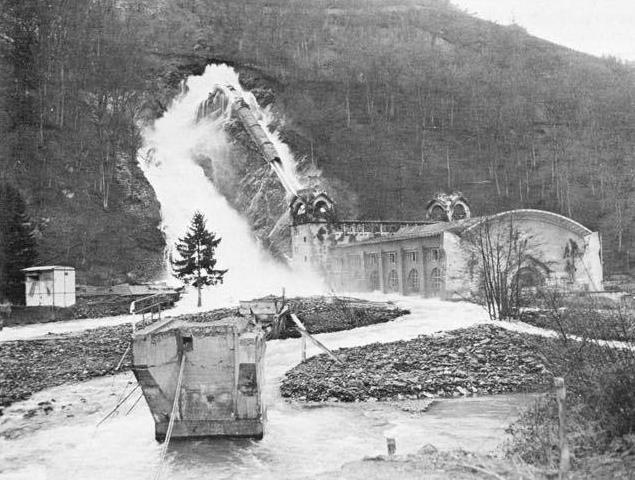
The night before the crossing of the Roer River, an announcement was made in the early hours of dusk to the men waiting on the banks of the Roer, “Mail call!!!”
What a wonderful sound. It wasn’t everyday that mail arrived, but every time it did it meant a touch of home. Letters from anyone were appreciate and the only thing better than a letter from a friend was a letter from your mother. Nothing better except a letter from your fiancé.
The story of this event as told my Frank’s son, Chuck, the author of this book:
“When my dad told me that he got such a letter, I was shocked because I knew he met my mom after the war. I had known that my dad had taken just three months from the time when he first met my mom until the time he married her. I knew that was 1947 and so did my dad.
So, he went on to quickly tell me that he was engaged to another woman before the war. The shock was double because I had never heard about this before. Thus, you can imagine my curiosity about what had happened to that woman. I never did dare to ask him who that woman was and to this day I don’t know.
I never asked my mom about this either as I didn’t want to embarrass her. Beside I’m not sure she ever knew about the other woman.
My dad went on to tell me that he was so excited to get this letter as it gave him hope that he’d survive the war and be welcomed into her warm embrace when he returned from war.
However, that joy turned to great pain as he read the letter. There, sitting on the eve of the greatest battle of his life the next day, Frank’s face was stone cold. There in his hand he read the terrible news that all GIs dreaded hearing. His fiancé had found another man and that she had already married him!
There on the banks of the Roer River he held a “Dear John” letter. In his hour of greatest need, he was rejected by the love of his life. And the pain was swift and severe.
My dad told me that on that night he didn’t care if he lived or died. He said he didn’t care if his head arose from the banks and his life ended with a gun shot from the enemy. All hope was lost. What was the purpose of going on in life?
Unknown to Frank at the time was that while Frank didn’t pay much attention to God, other than hearing about Him on occasion in church as a young boy, God had known him from before the world was created.
Jennie Mejeur was a young Christian who had a heart for children and so she picked up Frank and took him as a neighbor boy to the Knollwood Christian Reformed Church (which had started a Chapel in the area where William and Bernice Micheals and Frank lived). There Frank began to hear about God.
Those visits didn’t become a permanent feature in his home. That’s because I don’t believed that William Micheals family attended church regularly. William was a Roman Catholic and Bernice was a Methodist and for their wedding William wanted to be married in Kalamazoo in a Roman Catholic Church. Bernice replied that being a Methodist was good for her before her marriage and if he wanted to marry her it must be in a Methodist Church.
Bernice won the day, but it didn’t seem like any church attendance followed the wedding. Like many Americans believe, they think that being a Christian means some association to a church in some way through membership, baptism, professional of faith or even being married in a church. Frank grew up thinking that too.
When Frank got that letter he had no idea if God knew him. He hadn’t given it much thought. I’m sure Frank probably thought that if he died that night or next day that he would go to heaven because he knew about God and had been baptized in a Roman Catholic Church in Pittsburgh. But church membership, baptism or a profession of faith has saved no one. Jesus saves and He alone.
Frank did not know then that God knew his name because God had not revealed that to him. Later on in 1947 Frank did come to understand that God sovereignly ordained him to receive salvation and that it was also His sovereign will to have received that letter. That’s because God had a better plan, a plan that would lead Frank not only to his wife, but to the foot of the cross.
In God’s plan He had another woman he would meet, my mom Sue and God used that relationship to introduce Frank to Jesus.
That introduction between Frank and Sue happened in June or July 1946 when Frank had been home from the war for six months. God directed Frank to take a job at the Kalamazoo Vegetable Paper (KVP) in Parchment. It was the premier place to work.
Unknown to Frank at the time my mom had previously taken a job at KVP. It was in a different area from where Frank worked, but close enough for Sue’s workmates to notice him.
Sue’s female workmates were anxious to set up a blind date for her. After all, at age 26 she was way past the prime marrying age of 19. The girlfriends were determined to change that and took particular notice of Frank. He was a single man and a handsome man who had recently come home from the war. So, a blind date was arranged with Frank.
Frank took Sue out on their first date to the Coney Island hot dog restaurant in downtown Kalamazoo. A few weeks later, Frank invited Sue to do something on Sunday. Sue replied that she attended church on a Sunday and so she couldn’t go out with him. Instead she invited him to church and Sunday after Sunday he kept attending.
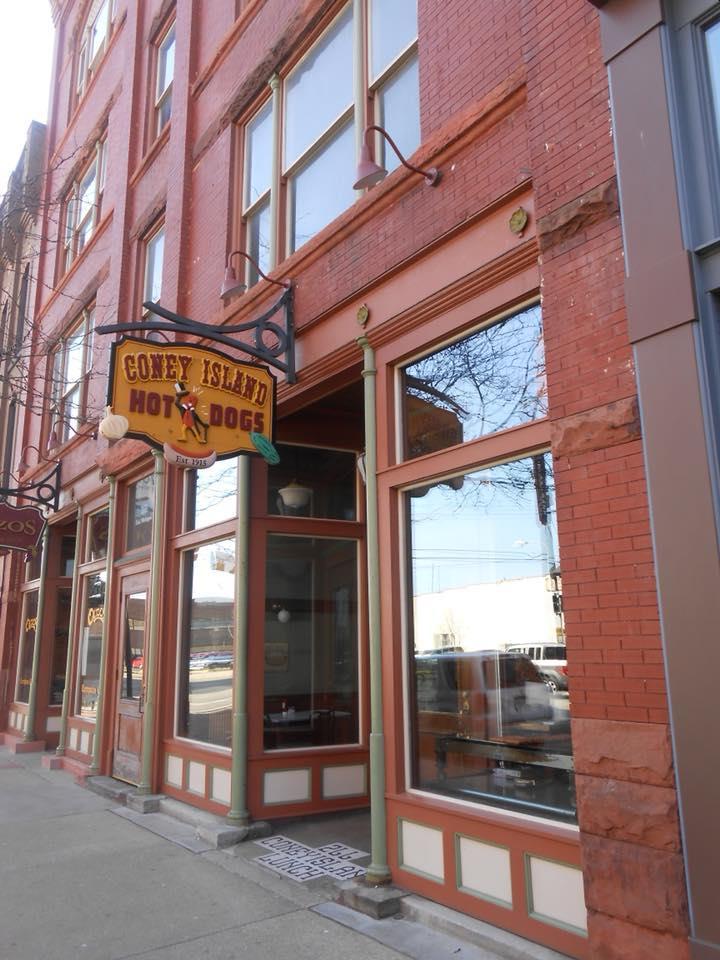
They married a few months later. When they married my mother was a Christian. God had saved her before their marriage by giving her the faith to believe and so she had received this faith and trusted Christ alone for her salvation. But my dad wasn’t saved then. God had not yet opened Frank’s eyes to salvation. That would come after they were married. (BTW, Jennie Mejeur happened to be the sister of Sue, Frank’s eventual wife)
I asked my mom why she married an unbeliever as Christians are forbidden in Scripture to marry such a person. I asked her how it was that her parents gave their blessing since they were believers and knew that believers were not to marry unbelievers.
Sue’s response was that Frank was willing to go to church and that satisfied her parents and the pastor. I was speechless as I knew the normal situation in such a marriage is that an unbelieving husband would
eventually encourage his wife to stop going to church and instead engage in worldly pursuits and eventually she would abandon her faith.
Well, again by God’s sovereign plan, God had determined before the foundation of the earth to save Frank and Sue so even disobedience would not keep then from being saved.
What could have been a marriage of sorrow or a broken marriage, God instead in His grace chose to bless. As Frank heard the Gospel preached in church over the next year Frank learned that he was a sinner and deserved the punishment of hell. However, he also learned that all who call upon Christ in true faith would not be cast aside. When Frank heard that Christ’s death on the cross was sufficient to pay for all his sins, God saved him and gave Frank the ability for him to believe and place his trust in Christ alone for his salvation.
God had determined by His sovereign will alone and not by any foreknowledge of what Frank would do to save Frank. God had determined in the council of His will even before the world came into existence to save Frank. And so God regenerated Frank’s heart and made Jesus death effectual for Frank and so He gave Frank His Holy Spirit who then gave Frank the faith to believe.
Frank received this gift because it was given to him. He couldn’t resist it because this was God’s decision. That didn’t happen because of Frank’s decision to accept that salvation, but because of what Jesus did for Frank. Jesus saved him!
So, after hearing all this I asked my dad what happened to that woman. He told me that some years later he ran into her in a store in Kalamazoo. He discovered she had divorced her husband. How happy he told me he was that he never married that woman.
So, what happened after that? Well, Frank’s faith grew as he faithfully attended the preaching of the Word twice every Sunday, as he read and studied the Bible, as he participated in the Lord’s Supper regularly and was faithful in prayer.
Everyone who knew Frank knew he did not deviate from that routine and some say that it was because he was so disciplined. He was. However, I believed Frank was this way because when God knew Frank God
preserved him. Frank was God’s adopted Son and Frank’s attendance to the means of grace noted above was a demonstration that he had true faith. Frank was saved by grace and grace alone through faith and faith alone. His tombstone inscription makes that clear. But Frank’s faith wasn’t a faith that was alone. It was accompanied by the good works that God had also prepare ahead of time for Frank to do. Frank’s good works and life devoted to following all of God’s commands (albeit not perfectly) were evidence to him and us that when God knows our name, our whole life changes and not just to make a good impression to gain a wife as Frank might have done at the time he dated my mom. Frank’s heart was changed and so Frank lived this way out of a thankful heart for what God had done for him in Christ.
The Roer River was crossed, but more importantly Frank crossed over from death to life when God revealed Jesus to my dad and saved him.”
Romans 10:17, “So faith comes from hearing, and hearing through the word of Christ.”
So, as As Frank sat under the Word of God preached at Second Christian Reformed Church in Kalamazoo, Michigan, Frank too heard God calling his name. On June 27, 1948 Frank made his public profession of faith at Second CRC. The rest they say is history!”
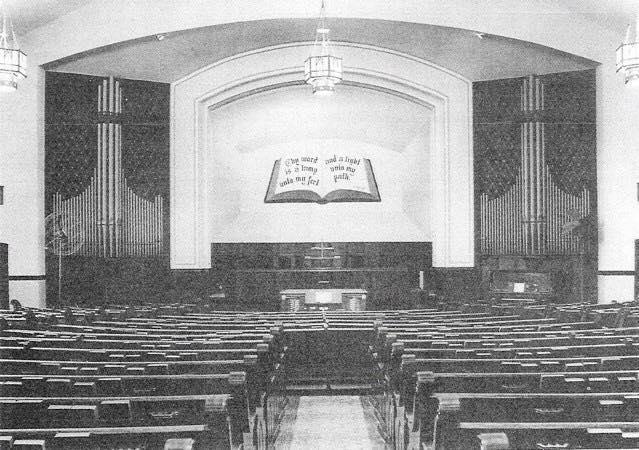
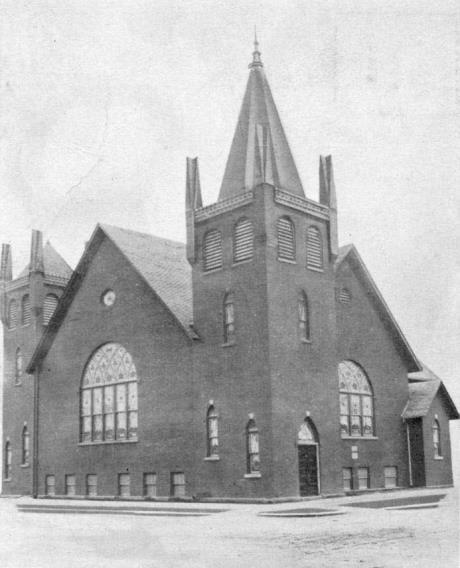

Frank was up very early the morning of the crossing. Here is the account:
“At 2:45 on the gray, chilly morning of Friday, February 23, 1945, a tremendous artillery barrage lit up the dark skies as 1,500 guns of the Ninth, First, and British Second Armies hammered suspected German strongpoints across the River Roer. When the shelling died down after 45 minutes, Simpson started his assault across the river on a 14 mile front. The infantry of six divisions dragged their 15 man assault boats across the muddy shores and into the river.
The most northerly of the assault formations, Maj. Gen. Alexander R. Bolling’s 84th Infantry Division, jumped off from the center of Linnich across a relatively narrow section of the Roer. Leading troops of the 1st Battalion of the 334th Regiment paddled across the swollen river. The swift current swept away broadsiding boats, but the first infantry waves made it across with few casualties. Successive assault waves were peppered by enemy mortars and small arms fire until they reached the far side, but the casualties were still relatively light.
The orderly initial crossing was followed by chaos and delays. Boats were stuck on the far shore, some drifted downstream, and hastily laid wooden footbridges were broken up by enemy fire. Bolling’s 3rd Battalion was not able to start across the river until 6:45 am. Using a shuttle service of boats, the battalion completed its crossing at 10:35 am.
German planes and artillery homed in and pounded the crossing site, but the gallant infantrymen and combat engineers persevered. New treadway spans were laid, anchored to trees and assault craft, and more troops made it across the river. The 84th Division’s 1st Battalion took the enemy by surprise, captured the village of Korrenzig, and carved out a 4,000 yard bridgehead. Bolling’s entire 334th Regiment was over the river by 2:50 pm.”
The Ninth Army suffered a little over 1,000 casualties, including 92 dead, in crossing the Roer. Gen. Omar Bradley later called the Ninth Army’s attack across the Roer and subsequent move toward the Rhine “one of the most perfectly executed of the war.” The attack, he continued, “cleared thirty four miles from the Roer to the Rhine ... capturing some 30,000 German troops.” The success of Operation Grenade and other
Allied offensives in the west combined with the Russian juggernaut in the east, meant that the end of the war in Europe was in sight.
Here is some video footage of the crossing: https://www.youtube.com/watch?v=ylHP8ONG7L0 https://www.youtube.com/watch?v=LbWU9MTkcnE
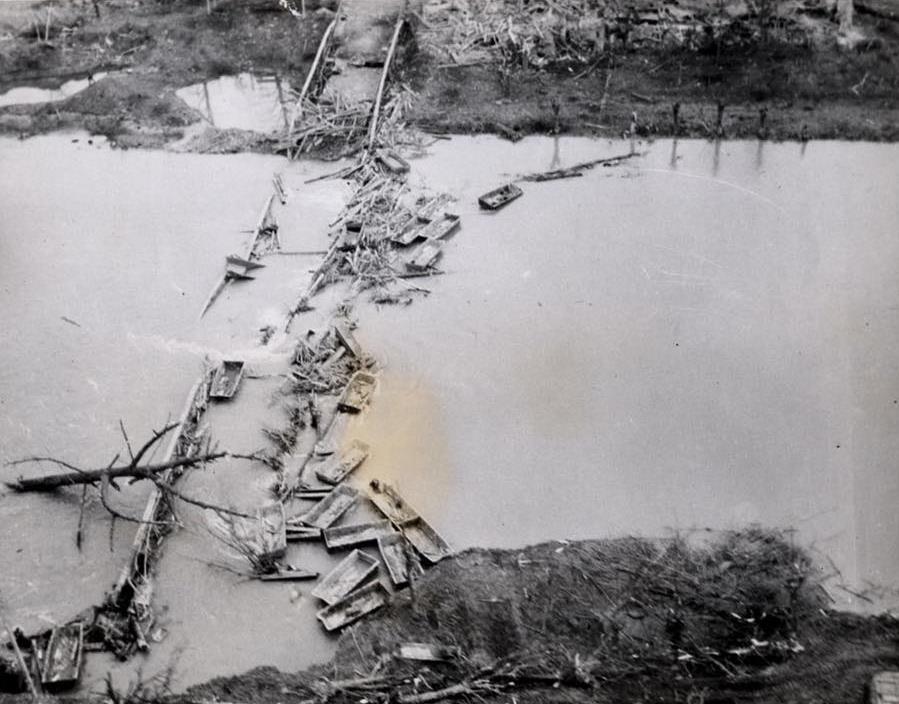
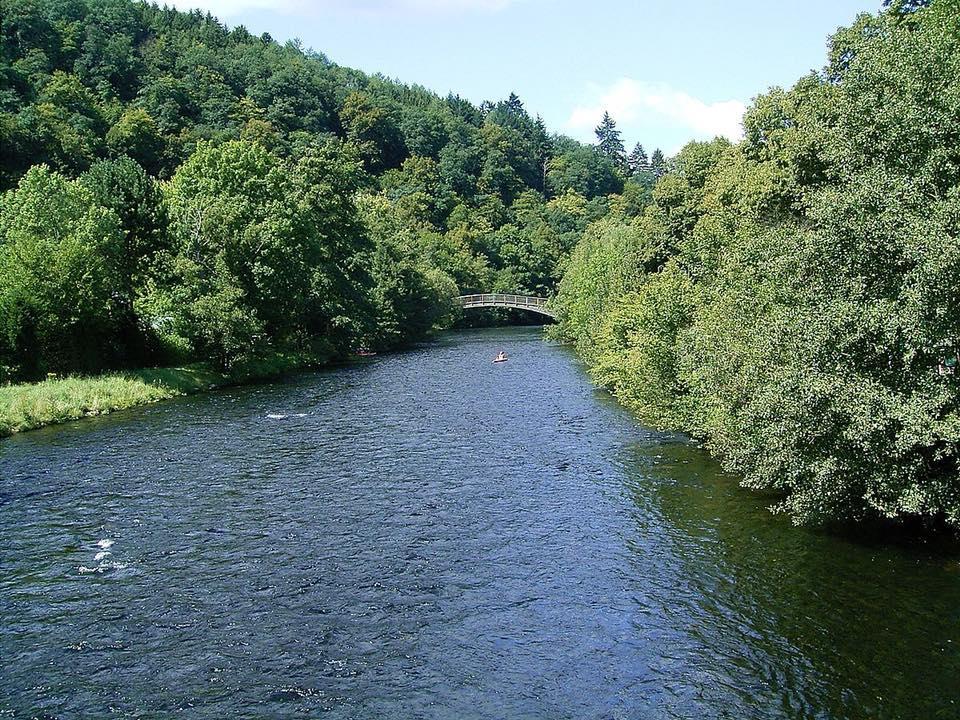
• February 23, 1945 The 84th Division moves from the Roer to the Rhine in ten days.

• February (late), 1945 The 84th Division captures Kerrenzig and then in rapid succession, Baal, Matzerath, Hoven and Gelkrath.
• March (early), 1945 The 84th Division captures Krefeld and then starts the drive to the Rhine River.
• March 5, 1945 The 84th Division reaches the Rhine River. Large artillery attacks begin at 1:00 AM.
• April 1, 1945 The 84th Division crosses the Rhine River at Wesel, Germany without opposition. AAA Battalions given priority in crossing. Frank crossed in the early morning
• April 4, 1945 Ninth Army reverts to the command of the 12th Army Group.
• April 5, 1945 The 84th Division supports attack with artillery fire at the bridgehead at the Weser River.
• April 7, 1945 The 84th Division moves ahead toward Stadthagen and Bückeburg. Hanover, Germany is only 25 miles ahead!
• April 9, 1945 The 84th Division pauses.

• April 10, 1945 The 84th Division captures Hanover and the Ahlem concentration camps and frees POWs!
• April 14, 1945 The 84th Division overtakes advancing armor to reach the Elbe River and meets the Russian Army and captures Salzwedel. Over 30% of attacking German planes (120) destroyed by Ninth Army antiaircraft artillery.
• April 21 & 22, 1945 The 84th Division clears the Wehrenberg Pretzetze sector along the Elbe River.
• May 2, 1945 The 84th Division makes contact with advancing Russian Army forces near Balow and Abbendorft and shake hands.
(Frank guarded this facility after it was captured)
April 2, 1945 The Army Division captures Obrigheim, Germany where the Daimler Benz plant aircraft engine plant was using forced Jew, civilian and POW labor to build engines.
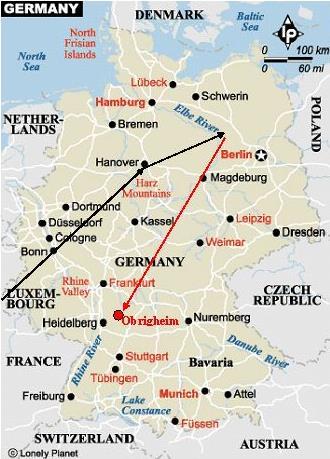
During the war the Daimler Benz plant brutally used forced labor (deported civilians, Jews and concentration camp inmates) to produce over 600 aircraft engines a month for the Nazi air force. This plant had over 1800 machines working on this effort.
In 1943 allied bombardments produced a great concern the Germany government. To continue the produce of Hitler’s war machinery a large part of the armament production was transferred underground.
In the spring of 1944, the airplane motors work of the Daimler Benz corporation was moved to this plaster pit in Obrigheim, Germany.
The entrance to the pit begins at the old railroad tunnel near the curtain factory as shown above. It is marked with the goldfish logo. This area connected up to 10 work stations which were above ground.
The plaster pit was damp and had insufficient ventilation. Many prison workers died in these conditions. The workers were housed in six warehouses in Neckarnähe. The main warehouse (which today is the Clemens Brentano elementary school). At one time this plant housed 1,200 prisoners. These prisoners worked in two twelve hours shifts.

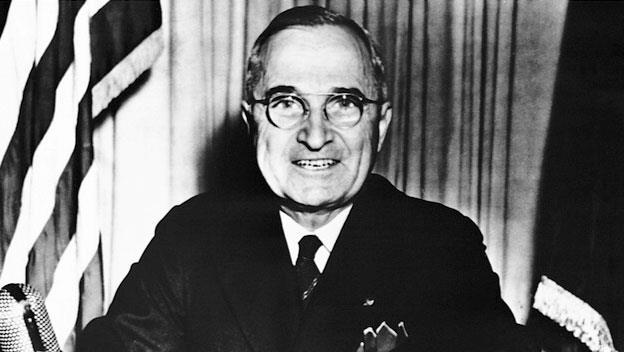
"This is a solemn but a glorious hour. I only wish that Franklin D. Roosevelt had lived to witness this day. General Eisenhower informs me that the forces of Germany have surrendered to the United Nations. The flags of freedom fly over all Europe.
For this victory, we join in offering our thanks to the Providence which has guided and sustained us through the dark days of adversity. Our rejoicing is sobered and subdued by a supreme consciousness of the terrible price we have paid to rid the world of Hitler and his evil band. Let us not forget, my fellow Americans, the sorrow and the heartache, which today abide in the homes of so many of our neighbors neighbors whose most priceless possession has been rendered as a sacrifice to redeem our liberty.
4 http://www.history.com/s3static/video thumbnails/AETN History_Prod/74/942/History_Speeches_1143_Truman_Germany_Surrender_still_624x352.jpg
5 http://www.trumanlibrary.org/ww2/veday.htm
We can repay the debt which we owe to our God, to our dead and to our children only by work by ceaseless devotion to the responsibilities which lie ahead of us. If I could give you a single watchword for the coming months, that word is work, work, and more work.
We must work to finish the war. Our victory is but half won. The West is free, but the East is still in bondage to the treacherous tyranny of the Japanese. When the last Japanese division has surrendered unconditionally, then only will our fighting be done
We must seek to bind up the wounds of a suffering world to build an abiding peace, a peace rooted in justice and in law. We can build such a peace only by hard, toilsome, painstaking work by understanding and working with our allies in peace as we have in war.
The job ahead is no less important, no less urgent, no less difficult than the task which now happily is done.
I call upon every American to stick to his post until the last battle is won. Until that day, let no man abandon his post or slacken his efforts.
And now, I want to read to you my formal proclamation of this occasion:
"A proclamation The Allied armies, through sacrifice and devotion and with God's help have wrung from Germany a final and unconditional surrender. The western world has been freed of the evil forces which for five years and longer have imprisoned the bodies and broken the lives of millions upon millions of free born men. They have violated their churches, destroyed their homes, corrupted their children, and murdered their loved ones. Our Armies of Liberation have restored freedom to these suffering peoples, whose spirit and will the oppressors could never enslave.
"Much remains to be done. The victory won in the West must now be won in the East. The whole world must be cleansed of the evil from which half the world has been freed. United, the peace loving nations have demonstrated in the West that their arms are stronger by far than the might of the dictators or the tyranny of military cliques that once called us soft and weak. The power of our peoples to defend themselves against all enemies will be proved in the Pacific war as it has been proved in Europe.
"For the triumph of spirit and of arms which we have won, and for its promise to the peoples everywhere who join us in the love of freedom, it is fitting that we, as a nation, give thanks to Almighty God, who has strengthened us and given us the victory.
"Now, therefore, I, Harry S. Truman, President of the United States of America, do hereby appoint Sunday, May 13, 1945, to be a day of prayer.
"I call upon the people of the United States, whatever their faith, to unite in offering joyful thanks to God for the victory we have won, and to pray that He will support us to the end of our present struggle and guide us into the ways of peace.
"I also call upon my countrymen to dedicate the day of prayer to the memory of those who have given their lives to make possible our victory.
"In Witness Whereof, I have hereunto set my hand and caused the seal of the United States of America to be affixed."
Frank received a letter from President Harry Truman, thanking him for serving in the military and winning this important victory.

It is not known where all the places Frank visited after the war ended and before he disembarked back to the USA. However, it is known that he visited Heidelberg, Germany, Morocco and Belgium.
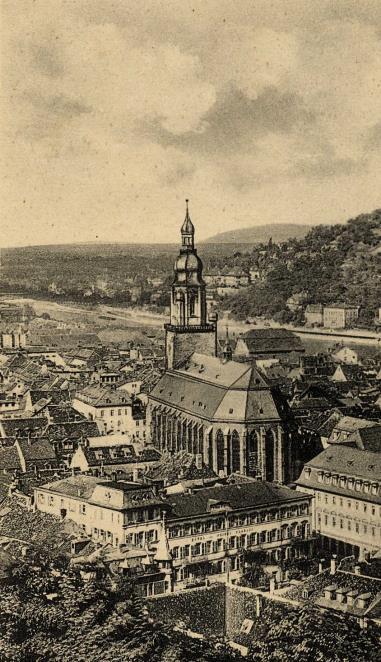
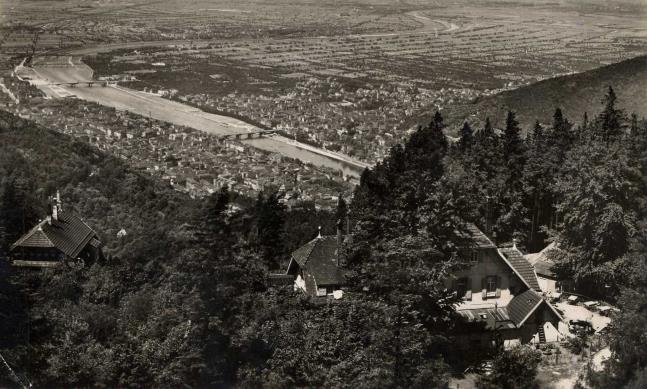
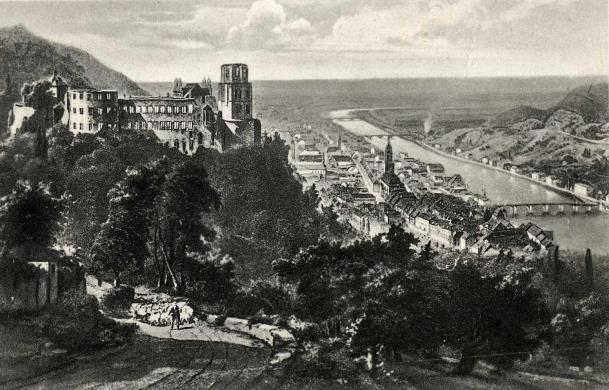
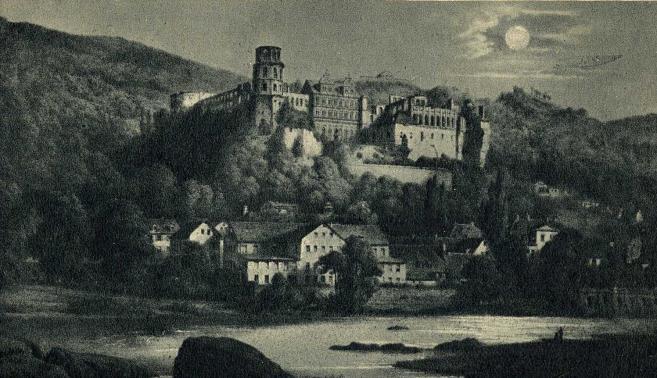
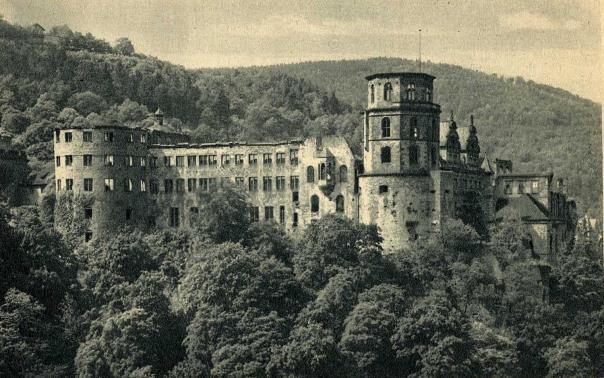
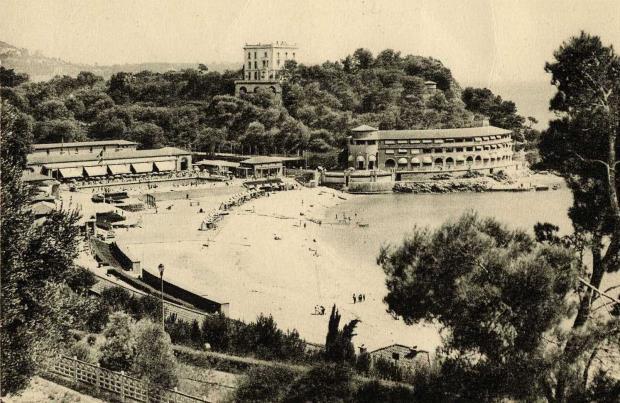
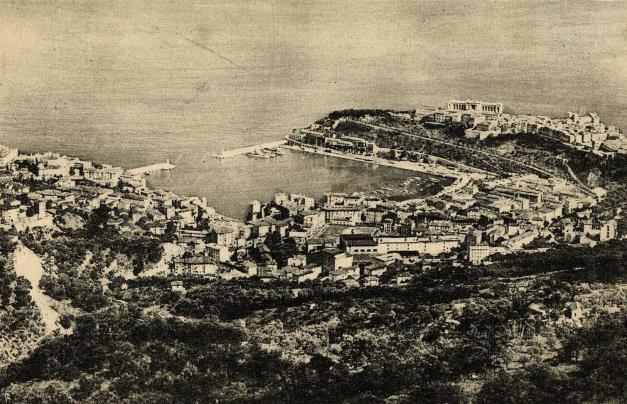

The 58 Adjusted Service Rating points Frank had accumulated was enough for him to head home in January 1946 because by this date only 50 points were needed to head home.
Frank’s last stop on the European continent before heading home was in Le Harve, France. Le Harve had been the second largest shipping port in France before the war, but bombing during the war flattened the city.
Yet, the ports were reconstructed enough after they were captured by the Allies that Le Harve became a major shipping port for incoming Allied ships during the war. After the war Le Harve would be the port for the “Victory Ships” which would take the GIs back to the USA where they would go to two Separation Camps in the USA before heading to their homes.
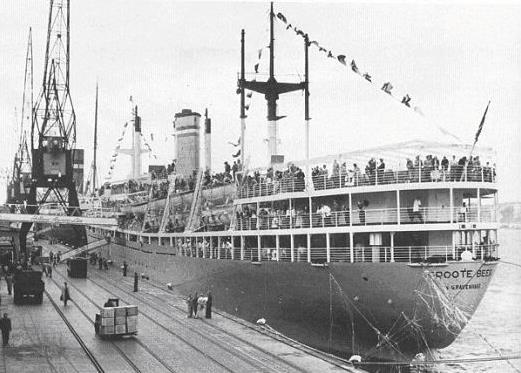
Here is what the Le Harve port looked before and after the bombing in 1944:

Here is what the camp Lucky Strike in Le Harve looked like that Frank would have stayed in before heading to the USA. https://youtu.be/4G_pReGM3uI
In all there were over 500 Victory Ships. They were all built as cargo ships during the war. However, only 97 of these ships were repurposed to handle the shipment of troops back to the USA. The rest continued to be used to haul cargo for reconstruction purposes in Europe.
https://en.wikipedia.org/wiki/List_of_Victory_ships
https://en.m.wikipedia.org/wiki/SS_Costa_Rica_Victory
These Victory Ships were able to transport up to 1,600 troops at a time back to the USA. That meant that the 97 ships took many trips across the Atlantic to eventually carry all the GIs back home.
The “Victory Ships’ were unlike the 2,700 “Liberty Ships” which were built as the ‘plain Jane’ cargo hauling ships during the war. The Victory Ship accommodation was fully ventilated and heated. Those heated rooms were a real treat for the GIs. Yet there was still the usual meagre style troop bunks, a hospital, food galleys and washrooms. However, on the Victory Ships there were several public rooms where the men could gather to talk and play card games.
In January 12, 1946, Frank rode on the Costa Rica Victory Ship with many other GIs back to the USA. Unfortunately, only three of these men, Pierre J. Laut, William K. Osbourne from 1723 14th Street, Seattle, WA and John Huchuls signed the autograph part of the certificate Frank received when boarding the ship. I have tried to locate these men and their families, but haven’t yet been able to locate them anywhere. It is possible one of them may be still alive and if they had families most likely their children would still be living.
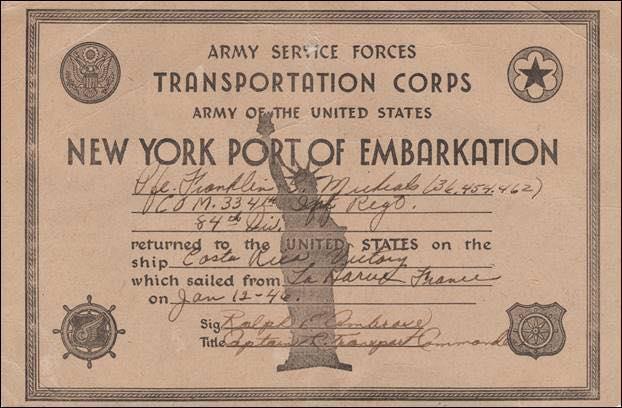
It took just 8 days to make the trip back to the USA. The ship arrived in the New York City harbor on January 20, 1946. There were bad storms on the way home.

Boring from all accounts! Many men played bridge and others mostly slept the entire trip. The men were only fed twice a day (breakfast and then they had nothing all day until supper).
Sleeping bunks were four bunks high, the lower one, the next one, the middle one and the top which was so close to the ceiling that the nose was close to the roof, or the bulkhead.
Many men gambled, but Frank told me he never gambled although many of the men did and lost their entire savings. Some men even jumped overboard due to fear when traveling to the ETO

Lady Liberty greeted these heroes as they steamed into the NYC harbor to a victors celebration! Frank was back home in his beloved country!!!
Frank told me he that once his feet touched American soil had no interest in traveling overseas again. He told me the USA was the best place to live and that he never wanted to ever leave it.
He never did, unless you count the one time our family drove over the Windsor Bridge into Canada for a very brief visit. We didn’t stay long as Frank was happiest at home. His wandering feet during the war was all the walking and visiting he ever wanted to do. Now he couldn’t wait to be back in his own bed again!
Many played bridge. We were fed twice a day. You'd get up, and you'd have breakfast, and then, you had nothing all day until supper, and then, you would have supper, and it was very boring. It took us almost two weeks to go overseas, we sort of all gathered together, and we had learned to play bridge, and we’d sit there and play bridge, to pass the time of day.
Sleeping bunks were four bunks high, the lower one, the next one, the middle one and the top which was so close that your nose was close to the roof, or the bulkhead.
Frank said he never gambled although many of the men did and lost their entire savings.
• January 1946……………Camp Kilmer, New Jersey 1st Separation Center
• January 1946……………Camp Atterbury, Indiana 2nd Separation Center
• From Camp Atterbury Frank returned home to Kalamazoo, Michigan where he lived at: 1101 Lafayette Avenue.
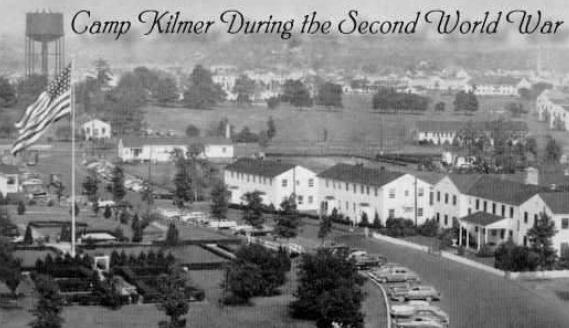
In 1941 the War Department selected the New Brunswick area as the best site for a staging area to serve the port of New York. Construction was started in January 1942, and Camp Kilmer was officially opened in June of that year.
The post is located two miles east of New Brunswick, an industrial city of (at the time) 38,768 people; 30 miles south of New York; and 55 miles northeast of Philadelphia. Camp Kilmer is locate near US Route 1, the Garden State Parkway, and the New Jersey Turnpike; and has railroad tracks leading to the PA Railroad, Lehigh Valley Railroad, and the Reading Railroad.
Camp Kilmer, an installation of the New York Port of Embarkation, operated by the Army Transportation Corps, is located in Stelton, N.J., about three miles east of New Brunswick and an equal distance west of Metuchen.
It was the first and largest Army camp constructed exclusively for the staging of overseas bound troops.
Built in the record breaking time of four and one half months, it was completed on June 15, 1942. There are 1268 buildings on the 1544 acres covered by the post, including 29 mess halls, five theaters, three gymnasiums, three service clubs, and an 8500 seat outdoor amphitheater, the Kilmer Bowl.
An outstanding feature facilitating the movement of troops in and out of camps is the completely electrified 14 track railhead, with 29 miles of track. It is served by three major carriers, the Pennsylvania, the Reading, and the Lehigh Valley Railroads.
Colonel Cecil L. Rutledge, T.C., is the post commander.
On January 9, 1945, Area 1 was activated as the first disposition area in the country. There are now ten such areas in camp with the sole function of processing troops returning from overseas duty for furlough, redeployment, or discharge. These men are fed, issued new clothes, and prepared for transshipment to reception stations in their home areas within 24 to 48 hours after their arrival.
The camp is named for Sgt. Joyce Kilmer, World War I soldier poet, who gained fame from his poem "Trees." Born in December 6, 1886, in New Brunswick, Sgt. Kilmer was killed in action June 30, 1918, while with the 42nd "Rainbow" Division during the Aisne Marne offensive.
When it was definitely known that an army camp would be established near New Brunswick, the Joyce Kilmer Post of the American Legion sponsored a movement to name the camp in honor of the poet. On February 24, 1942, the War Department announced that the new installation would be named Camp Kilmer.

Activated: 2 June 1942
Named For: BG William Wallace Atterbury, Chief of Transport, American Expeditionary Force (WW 1), President, Pennsylvania Railroad, native of New Albany, Indiana.
In 1946 at Camp Atterbury Separation Center, about 561,000 personnel were separated at a rate of almost 3,000 separations per day.
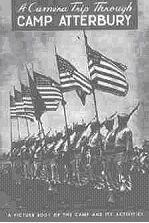
Typical Day At Separation Camp
0700 Make up your bed with clean sheets furnished you by Barracks Leader.
0730 Pack your Barracks Bag for a complete move, taking with you of the bedding only two sheets, and one pillow case that you used the evening before and move them to Supply Room, Building 473, waiting there for the next call, where they will tell you to report.
0800 You will receive initial orientation in Building 483, to include the mission of Wakeman Convalescent Hospital together with explanation of your processing, step by step. To save a lot of confusion, pay close attention to the above explanation. At the completion of the Orientation, you will be given a break and a chance to smoke.
0910 Your next step in processing will be a conference in the same building, at which time you will receive information on particular phases of army life and your part in it.
0940 You will receive instructions from Counseling Personnel, w/attention directed to affairs that may have arisen since you have been away.
1040 You will return to Barracks, Building 465, and wait there until your group is taken to Battalion Supply, Building 473. At this building you will get your bed and barracks assignment, draw 2 blankets and be advised about clothing issue. You will sign for 2 blankets, 2 sheets, and 1 pillow case, since you have the sheets and pillow case in your possession.
1300 You will promptly report to your Company Order Room Company "A", Building 464 and Company "B", Building 473 where you will receive such instructions as are necessary for the afternoon.
1315 Upon completion of company formations, you will proceed to Battalion supply, Building 473 for clothing check. After your clothing has been checked, you will be taken to a Model Stock Supply Room and the clothing that you are short, issued that day. When this is completed you have finished your first day of processing , when you will retire to your barracks and see that everything is in order for tomorrow.
0800 You will have a dental examination in Building 482 on the first floor.
1000 Upon completion of dental examination you will report to the Appointment Clerk, at which time a Medical Appointment Slip will be given you which explains all the Medical Workup. You will be given appointments from 1000 to 1630 for Ear, Eyes, Nose and Throat, and Physical Examination, Social Work,
and Personal Conference. At the end of the day when all your appointments are complete and your Medical Appointment Slip is completed, you will turn the slip in to the Appointment Clerk on the first floor. When this is done you have completed the Second day of Processing.
0800 You will have an Eyes, Ears, Nose and Throat examination in Building 482 on the second floor along with Medical Examination by Medical Officers. They will determine the length of convalescent furlough, if you are eligible for one at this time. If you are eligible for a furlough you will sign the application at this time. You will also be given appointments for Medical Consultations, and the proper time to report. Be sure you meet these appointments, since it is important before your Medical Workup is completed. Medical Workup will continue the remaining part of the day until you have finished your workup or have appointment for the following day. After having completed the three examinations mentioned, your second day of processing will be finished.
0830 You will turn in your bedding which consists of 2 blankets, 2 sheets, 1 pillow case and bunk tag, to Supply Room, Building 473. Move your bags to your Orderly Room and wait for the Shipping Clerk to take your processing Slips.
0800 Shipping Clerk will take up your processing slips and move you by bus to your new Battalion
The 35,000 acres of the former Camp Atterbury are now known as the Atterbury Fish and Wildlife Area (located on US 31 near Edinburgh, Indiana).
Frank’s Military Discharge: January 27, 1946, Camp Atterbury, Indiana
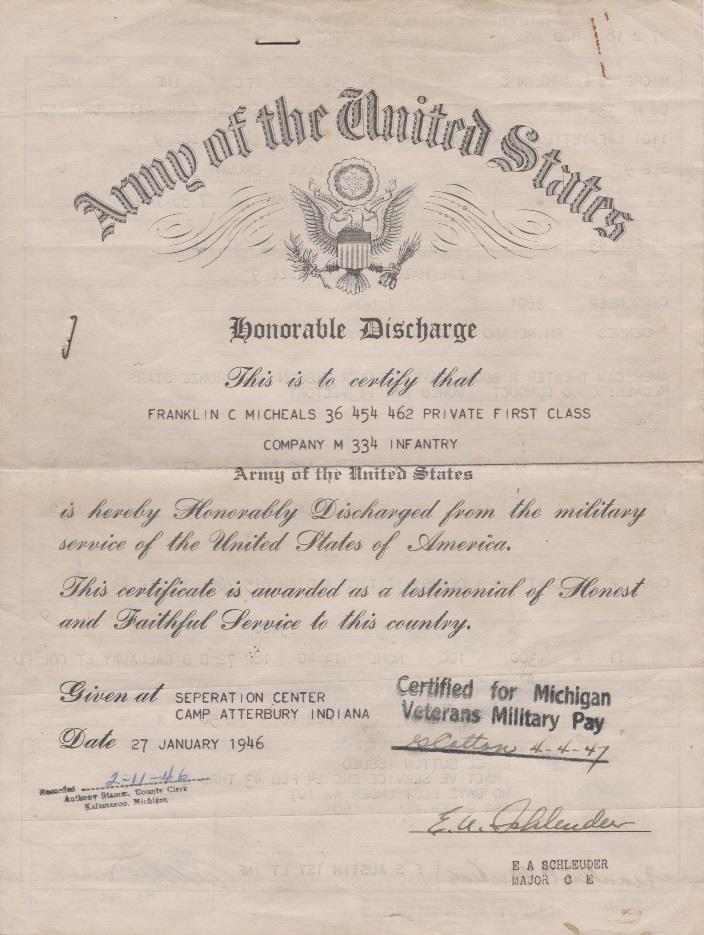
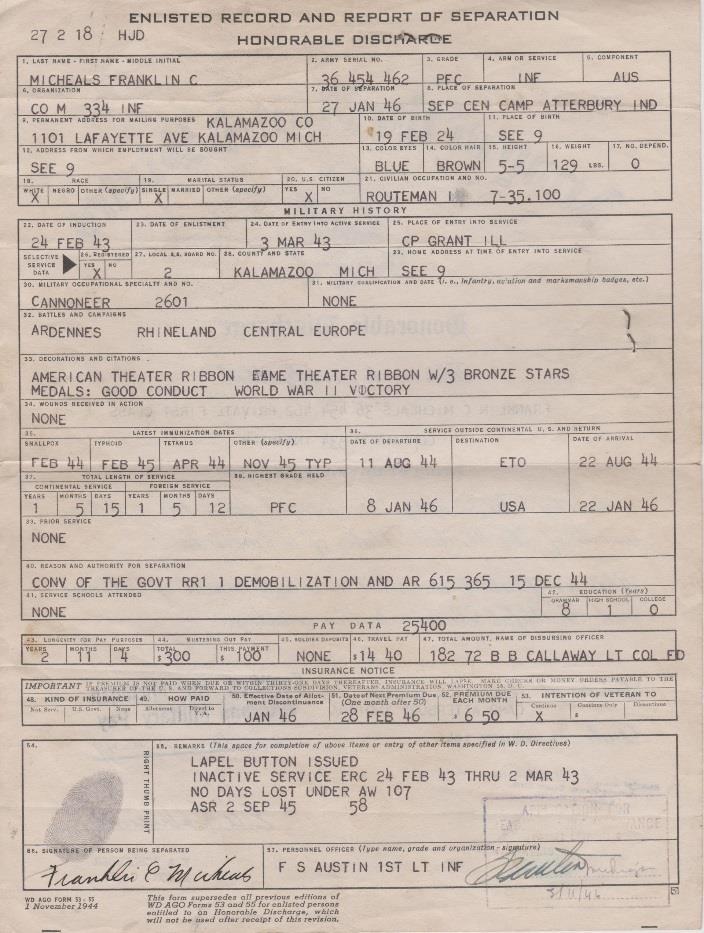

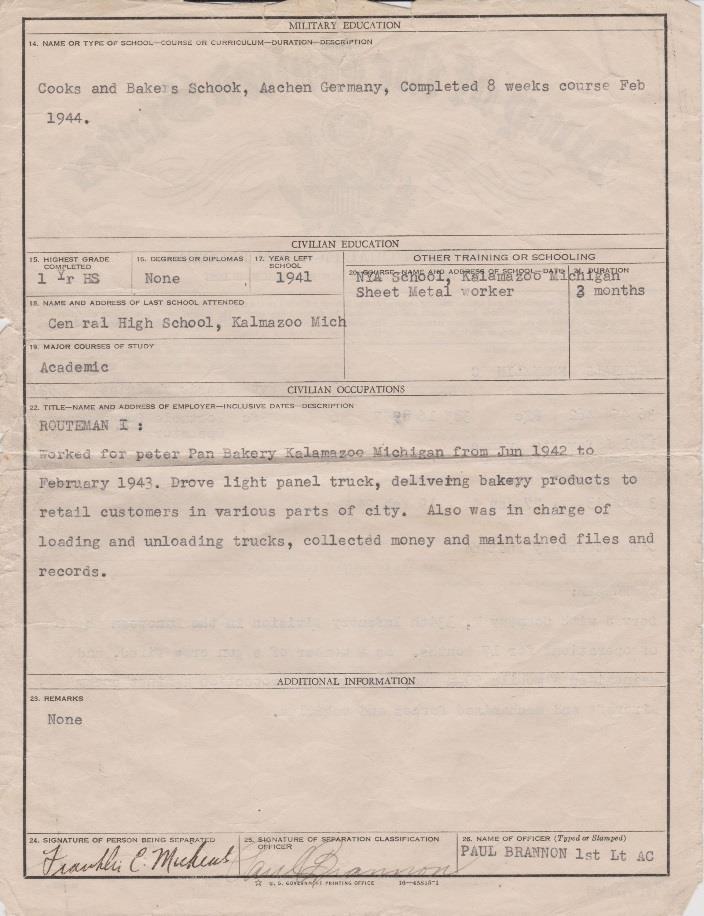
At some point in Frank’s military career he received training in being a Portable Power Generator Operator. That was to aid the 553rd's AAA Spotlight Unit.
The Office of The Quartermaster General, as staff agency of the Army Service Forces, organized a Food Service Program which went into effect on 31 July, 1943. Since that time tremendous strides have been made in food service. Soldiers today are much better fed. Waste has been reduced at least fifty per cent. Hundreds of progressive ideas have been put into effect and have saved millions of dollars. How was this done? Its actual accomplishment rests upon constant attention to training and supervision.
Trained, qualified personnel, supplemented by supervisory assistance is the heart of the program. Capable officer and non commissioned officer technicians from the Office of The Quartermaster General; from the offices of the Directors of Food Service in Service Commands; from the many Army operated schools

for bakers and cooks, and leading civilians in the food industry men with years of food experience, who have been appointed as civilian consultants to the Secretary of War have done much to make food service a vital force. Maintaining high standards of food service in Army messes is their never ending job.
The Food Service Program is not a generalization. It is hard work backed by years of experience. In order to get the program in operation, the Food Service Branch, Subsistence Division, OQMG, was organized. This branch, in turn, was subdivided into three sections: Bakery, Schools for Bakers and Cooks, and Mess Supervision. Recently, Refrigeration and Mess Equipment Sections have been added.
Mess Supervision Section provides an "escort service" for food from the time it leaves the commissary to the time it is prepared and ready for consumption by the soldier. It has handled specific perplexing problems of different types of installations. Mention of a few of these will suggest the scope of the activities in which mess supervision is involved.
Early last year heavy troop movements through staging areas and ports of embarkation seriously taxed the feeding facilities of these installations. Considerable difficulty was being experienced in feeding large groups of soldiers in mammoth cafeteria type messes. At the request of the Chief of Transportation, Mess Supervision officers made a clinical study of feeding at several of the ports. As a result of that study a standard pattern of operation was adopted. Central meat cutting plants, central pastry shops, central sandwich shops, and central warehousing facilities were installed, and relieved the burden at each of the individual messes. Today, at major staging areas, feeding standards can be rated with the best in the Army.
Food service at hospitals must be the finest possible. Sick and injured soldiers deserve only the best. Messing problems in these establishments, of necessity, are numerous. An exhaustive study of these problems resulted in a manual of operation, prepared for the Surgeon General’s Office and designed to assist in the improvement of hospital feeding.
Mess operations observed in twenty four prisoner of war camps provided the Food Service Branch with the material which formed the basis for a prisoner of war mess manual, published by the Provost Marshal General. Prisoners are not being pampered in regard to food. Their ration has been adjusted to take into consideration their national eating habits, and scarce or rationed foods have been reduced to a minimum in PW menus. Elimination of waste and conservation of food is a must in these camps.
The Army has also experienced feeding problem in defense plants, supply depots, arsenals, and holding and reconsignment points. These are all classed as Army installations, even though the actual feeding operations may be conducted by civilians for civilians. Again, searching and detailed studies were made to perfect high standards of food service.
The War Shipping Administration, on learning of the success of the Army Food Service Program, has requested and received help in improving the messing of troops aboard allocated vessels.
Fourteen day menus, listing a choice of entrees, with a tested recipe for every dish, have been contributions of the Food Service Program to the Army Ground Forces and Army Service Forces redistribution stations.
Surveys conducted in 1944 by the Food Service Branch disclosed that food preferences of the Women’s Army Corps were different from those of men. As a result of this investigation, and in keeping with the actual desires of the women in uniform, their menus have been modified. For instance, bacon has been decreased 15%, veal 20%, eggs from 30 to 50%, bread 20%, and coffee 25%. At the same time, many fresh and canned fruits have been increased, such as fruit cocktail 50%, pears 100%, and apples 50%.
One project which has received much favorable publicity has been the rendering of fats. It has affected tremendous savings. Issues of shortening have been reduced in most service commands. Many posts have issued no shortening to messes for several months. Others have not only been self sufficient in providing their own shortening, but have rendered sufficient fats to meet the requirements of their bakeries. A few posts are even shipping surplus rendered fats to other stations.
Weekly drives featuring a particular phase of messing have been of great assistance in improving food service. They have been given distribution on every front, at home and overseas, through the medium of the Quartermaster Training Service Journal. A few of the food service drives have been: the proper use of leftovers, coffee brewing, attractive food service, preparation of fresh and frozen vegetables, stock room control, care of ranges, and the cooking of meats.
Each of these drives has a purpose. Each one concentrates upon a particular problem. For example, the drive stressing use of a moderate temperature in cooking meats indicated that a saving of at least
$20,000,000 a year was possible when meats were roasted at proper temperatures. Use of moderate temperatures also makes meat more tender and tasty.
Coffee is important in the life of most American soldiers. Special emphasis has been placed by the Food Service Branch on the proper brewing of coffee. A manual giving instructions for the handling, storage, and brewing of coffee has been prepared and distributed. Instruction charts have been placed on all Army Service Forces urns so that even the greenest recruit can make good coffee.
During the past year the Food Service Program was active in promoting victory gardens at Army posts. The Seventh Service Command, alone, has reported the value of the products raised in its garden as more than $93,000.
The Bakery Section is established for the purpose of controlling post bakery operations through an adequate field service organization. It directs the utilization of all bakery equipment and machinery, and passes on all requisitions for new equipment. This is no small task when one considers the 152 garrison bakeries with a production capacity of over 2,000,000 pounds of bread per day.
The Schools for Bakers and Cooks Section constantly reviews the training doctrine and visual aids used for educational work. It aids in the preparation of new courses of instruction which are required from time to time for special purposes. The revision of such documents as the Army Cook, the Army Baker, and other training manuals and technical bulletins is another duty. At one time, in order to keep pace with our fast growing Army, there were nearly 100 schools strategically located throughout the country.
The Refrigeration Section was recently established for the purpose of formulating policies covering the technical control of the utilization of refrigerator space and, at the same time, to develop and issue instructions covering storage methods, layouts, and temperature requirements.
The Mess Equipment Section maintains close liaison with General Supplies Branch, OQMG, and the Office of the Chief of Engineers in order to furnish information concerning requests for equipment to be installed in central meat cutting plants, central pastry bakeries, fat rendering plants, kitchens, and mess halls. Periodic reports on available mess equipment are analyzed for redistribution purposes.
The Food Service Program to improve messing, conserve food, and eliminate waste will continue to operate to the end that GI Joe may remain the best fed soldier in the world. As the days and months go by it will be the continued duty of every officer connected with the mess to be constantly on the alert for ways and means of improving the food served our soldiers.
The Cannoneers always traveled as a battalion whenever they moved from one camp to another, going out on a bivouac, on our trip overseas, and from one location to another in Europe. Frank was a part of the 553rd Anti Aircraft Artillery Battalion and it was made up of approximately 750 men.
The battalion was broken down into five batteries, called A (Able), B (Baker), C (Charlie), D (Dog), and Headquarters. The four letter batteries were further broken down into eight gun sections each. Frank was in C Battery.
Headquarters Battery consisted of men involved with supply, training, logistics, and paper shuffling. Each battery had its own kitchen and staff. In addition to the main Battalion Headquarters and supply system, each letter battery had its own facilities in these areas.
A gun section consisted of a crew of 8 men. For equipment, Frank’s unit had:
A 40mm anti aircraft gun that could fire rounds at two per second, or it could also be set to fire single shots. It was mounted on a platform that sat on a steel frame. At each of the four corners was a rubber
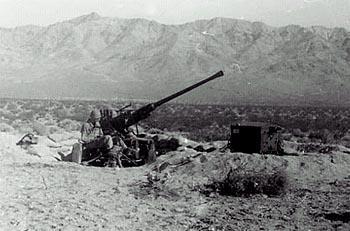
truck tire for traveling. It had a ten foot long draw bar that was six inches in diameter for attaching to the back of a truck when moving from one place to another.
When they arrived at their destination, they would unhook the gun from the truck, move it into position by manpower, pull the outriggers out to the sides, remove some safety pins, lower the gun onto four pads 90 degrees apart, and then level the gun with hand cranks that were mounted at the ends of the outriggers.
The gun was aimed by sighting through cross hairs mounted on each side of the gun. There were seats behind the cross hairs for the trackers; the left side cranked horizontally, and the right side cranked vertically. One man, called the loader, stood on a platform and loaded clips of six shells each into a slot. While firing at two rounds per second, he had only three seconds to get the next clip in before he ran out of ammunition. This loader also cocked the gun originally to put a round into the firing chamber. He fired the gun by stepping on a lever located on the platform. The gunner stood on the ground and directed the fire. They also had a rope that was tied to the leg of the loader. Because it was so noisy while firing, they would just pull the loader’s leg off the petal when necessary.
The gun could also be aimed by a director that consisted of a steel box, approximately four feet cube, that was full of gears. It sat on a tripod, and it, too, had a leveling mechanism. There was a scope on each side, and the trackers stood on each side on the ground instead of sitting on the gun seats. The director stood about 15 feet from the gun. It had to be coordinated with the gun by sighting both of them on some distant object and then locking them together. The trackers had a six inch diameter wheel located next to the scopes that they moved to keep on a moving target. The gears in the box were supposed to build a lead on a target so that if you were tracking a plane, the projectile would be fired out ahead of it so that it would allow for the time it took the projectile to reach the plane.
When they were using the director, which was only when they had to, the gun and the director were powered by electricity. This came from a gasoline driven power plant we had that generated the electricity. The gun, director, and power plant were inter connected with electrical cable.
One, 2 1/2 ton truck: pulling the 40mm gun. The truck had wooden slats arched across the body with canvas tarpaulin over that. The truck hauled the 8 man crew in our gun section, ammunition, tents, cots,
duffel bags for our clothes, sand bags to build gun pits, power plant, director, rifles, gas masks, some basic cooking gear, and everything else we owned in the world.
During their training, they spent a lot of time on aircraft identification. If they were going to shoot down aircraft, they had better know the enemy from our own. They used movies, flash cards and models to learn the characteristics of all the war planes that were being used at that period of time.
The average infantry soldier carried approximately 30 pounds of gear into combat. Many carried more. Shown here is the M 1 Garand .30 caliber semi automatic rifle. The Garand was the standard issue infantry weapon. It fired an eight round clip of 30 06 ammunition. With each pull of the trigger the rifle would fire and reload another round into the chamber. After all eight rounds were fired the rifle would eject the steel clip with a distinctive ping. The bolt would remain open until another clip was manually inserted into the rifle. Also shown here is the M 1 bayonet and M 7 grenade launcher which fit later model Garands.
The M 7 device allowed the M 1 to utilize a special cartridge to fire rifle grenades. Multiple bandoleers for carrying additional ammunition often supplemented the standard ten clip ammo belt. Also show are typical fragmentation grenades, entrenching tool, and rifle cleaning tools. The smaller knife is a M 3 fighting knife with M 8 scabbard. The helmet is a mid to late war design with swivel bales and a front seamed stainless rim.
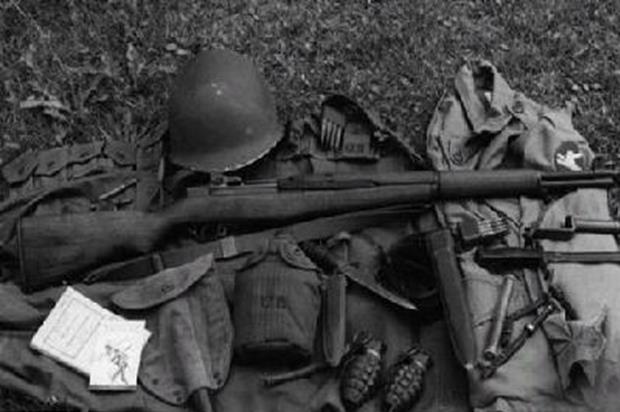
Chuck and Barb Micheals and Tim and Vicki Micheals visited the WW II Memorial Dedication on the weekend of Memorial Day, May 29, 2004. Chuck's sister Sue and her husband Bruce also visited with us over the Memorial day weekend, but were unable to attend the actual dedication ceremony.
We were able to see and hear President George Bush speak to a crowd of over 100,000 people in front of the memorial with the WW II Memorial and the Lincoln Memorial in the background. You can hear President Bush's speech online at: http://www.americanrhetoric.com/speeches/gwbww2memorial.htm (read his speech below)

Thousands of veterans from WW II attended and many were dressed in their WW II uniforms. The dedication was just part of four days of activities to honor the heroes of WW II. Tents were set up featuring areas for reunions, music and many artifacts from the war. We were able to talk to many veterans who were in Chuck's dad's 84th Infantry Division along with several vets who served in the Papua New Guinea campaigns. We thanked each veteran for their service to our country! See our pictures in the link to the left.
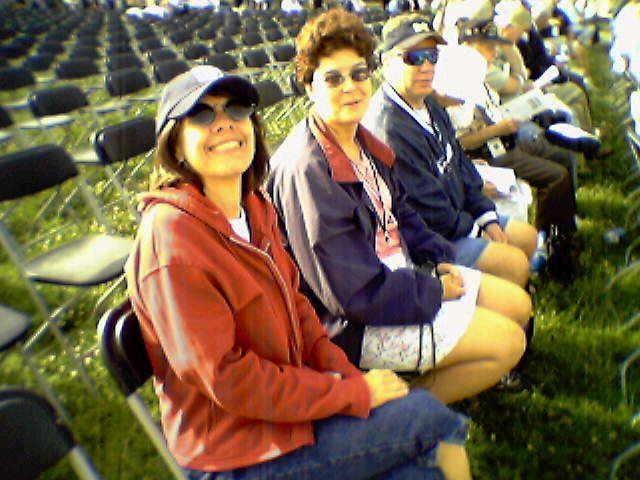
THE PRESIDENT: Thank you all very much. I'm honored to join with President Clinton, President Bush, Senator Dole and other distinguished guests on this day of remembrance and celebration. And, General Kelley, here in the company of the generation that won the war, I proudly accept the World War II Memorial on behalf of the people of the United States of America.
Raising up this Memorial took skill and vision and patience. Now the work is done, and it is a fitting tribute, open and expansive, like America; grand and enduring, like the achievements we honor. The years of World War II were a hard, heroic and gallant time in the life of our country. When it mattered most, an
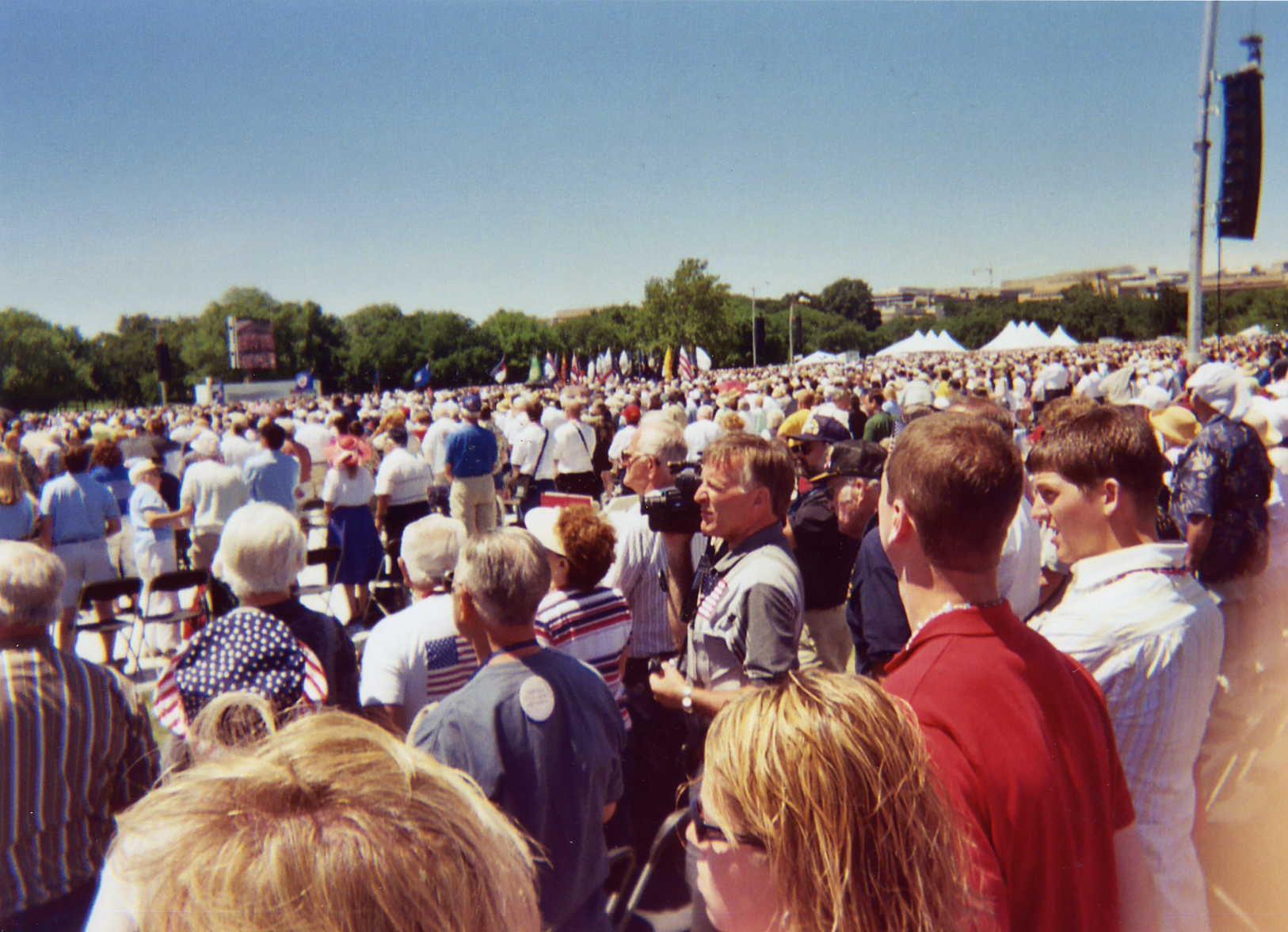
entire generation of Americans showed the finest qualities of our nation and of humanity. On this day, in their honor, we will raise the American flag over a monument that will stand as long as America itself.
In the history books, the Second World War can appear as a series of crises and conflicts, following an inevitable course from Pearl Harbor to the Coast of Normandy to the deck of the Missouri. Yet, on the day the war began, and on many hard days that followed, the outcome was far from certain.
There was a time, in the years before the war, when many earnest and educated people believed that democracy was finished. Men who considered themselves learned and civilized came to believe that free institutions must give way to the severe doctrines and stern discipline of a regimented society. Ideas first whispered in the secret councils of a remote empire, or shouted in the beer halls of Munich, became mass movements. And those movements became armies. And those armies moved mercilessly forward until the world saw Hitler strutting in Paris, and U.S. Navy ships burning in their own port. Across the world, from a hiding place in Holland to prison camps of Luzon, the captives awaited their liberators.
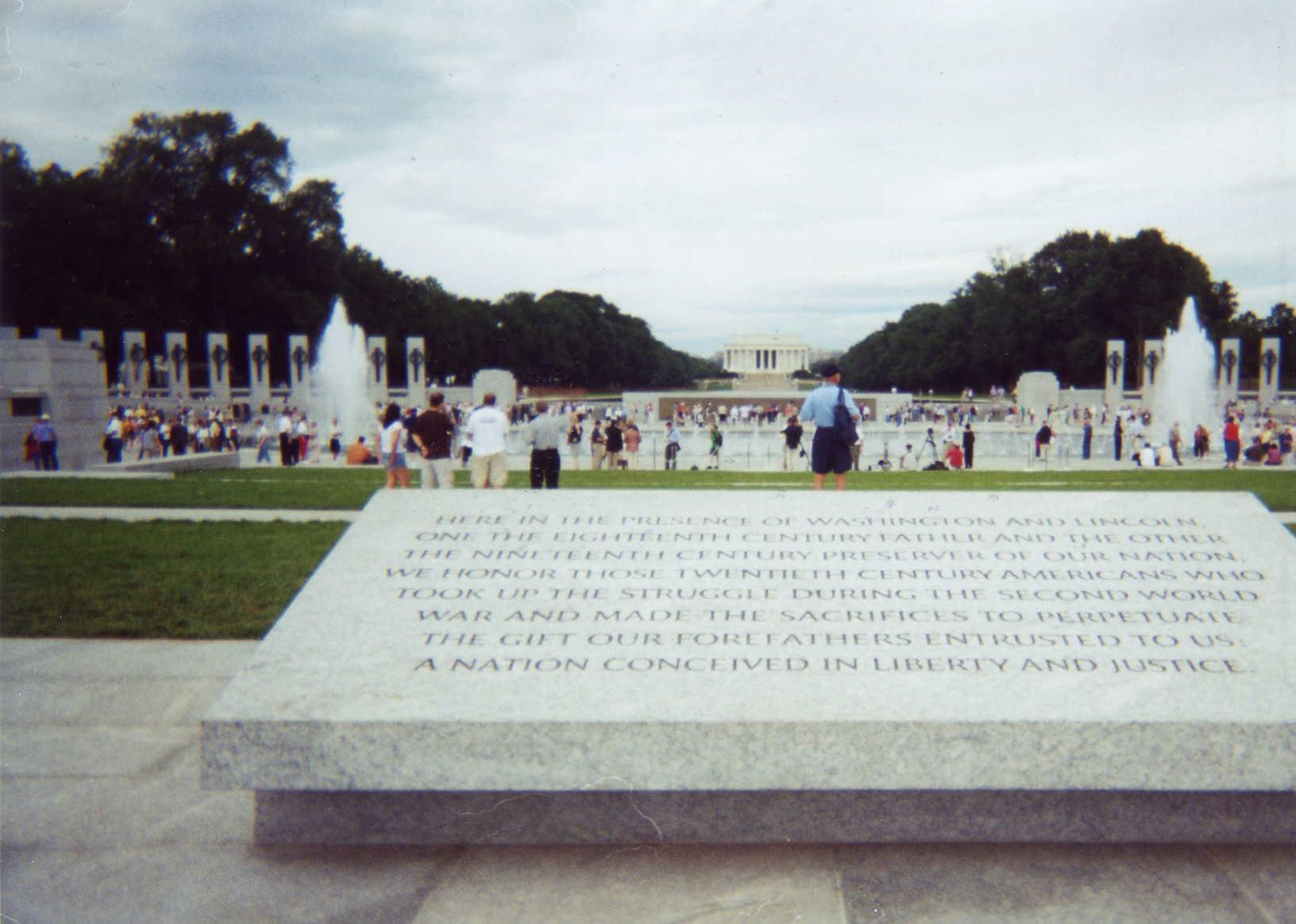
Those liberators would come, but the enterprise would require the commitment and effort of our entire nation. As World War II began, after a decade of economic depression, the United States was not a rich country. Far from being a great power, we had only the 17th largest army in the world. To fight and win on two fronts, Americans had to work and save and ration and sacrifice as never before. War production plants operated shifts around the clock. Across the country, families planted victory gardens 20 million of them, producing 40 percent of the nation's vegetables in backyards and on rooftops. Two out of every three citizens put money into war bonds. As Colonel Oveta Culp Hobby said, "This was a people's war, and everyone was in it."
As life changed in America, so did the way that Americans saw our own country and its place in the world. The bombs at Pearl Harbor destroyed the very idea that America could live in isolation from the plots of aggressive powers. The scenes of the concentration camps, the heaps of bodies and ghostly survivors, confirmed forever America's calling to oppose the ideologies of death.
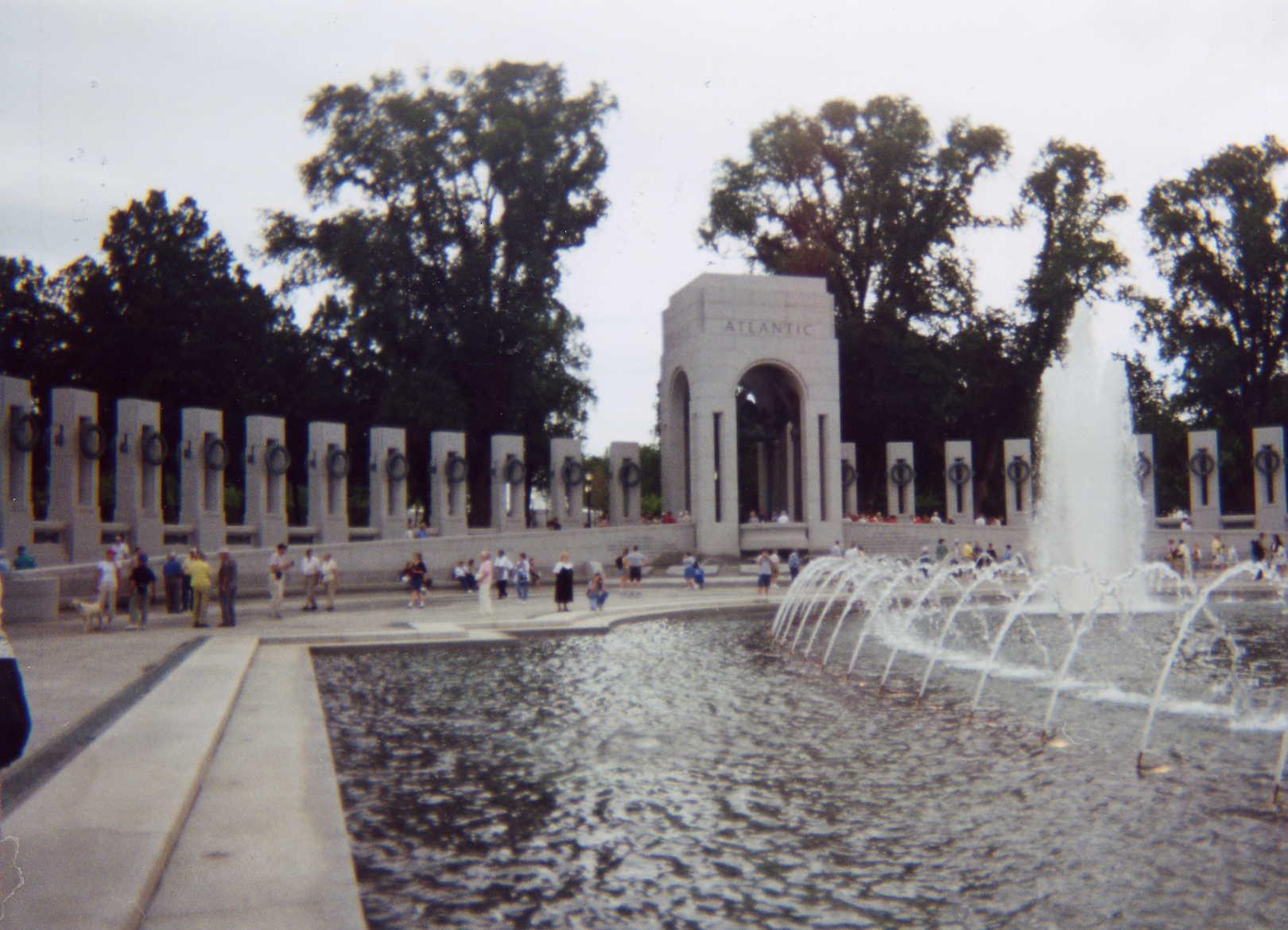
As we defended our ideals, we began to see that America is stronger when those ideals are fully implemented. America gained strength because women labored for victory and factory jobs, cared for the wounded and wore the uniform, themselves. America gained strength because African Americans and Japanese Americans and others fought for their country, which wasn't always fair to them. In time, these contributions became expectations of equality, and the advances for justice in post war America made us a better country.

With all our flaws, Americans at that time had never been more united. And together we began and completed the largest single task in our history. At the height of conflict, America would have ships on every ocean, and armies on five continents. And on the most crucial of days, would move the equivalent of a major city across the English Channel.
And all these vast movements of men and armor were directed by one man who could not walk on his own strength. President Roosevelt brought his own advantages to the job. His resolve was stronger than
the will of any dictator. His belief in democracy was absolute. He possessed a daring that kept the enemy guessing. He spoke to Americans with an optimism that lightened their task. And one of the saddest days of the war came just as it was ending, when the casualty notice in the morning paper began with the name, Franklin D. Roosevelt, Commander in Chief.
Across the years, we still know his voice. And from his words, we know that he understood the character of the American people. Dictators and their generals had dismissed Americans as no match for a master race. FDR answered them. In one of his radio addresses, he said, "We have been described as a nation of weaklings, playboys. Let them tell that to General McArthur and his men. Let them tell that to the boys in the flying fortresses. Let them tell that to the Marines."
In all, more than 16 million Americans would put on the uniform of the soldier, the sailor, the airman, the Marine, the Coast Guardsman or the Merchant Mariner. They came from city streets and prairie towns, from public high schools and West Point. They were a modest bunch, and still are. The ranks were filled
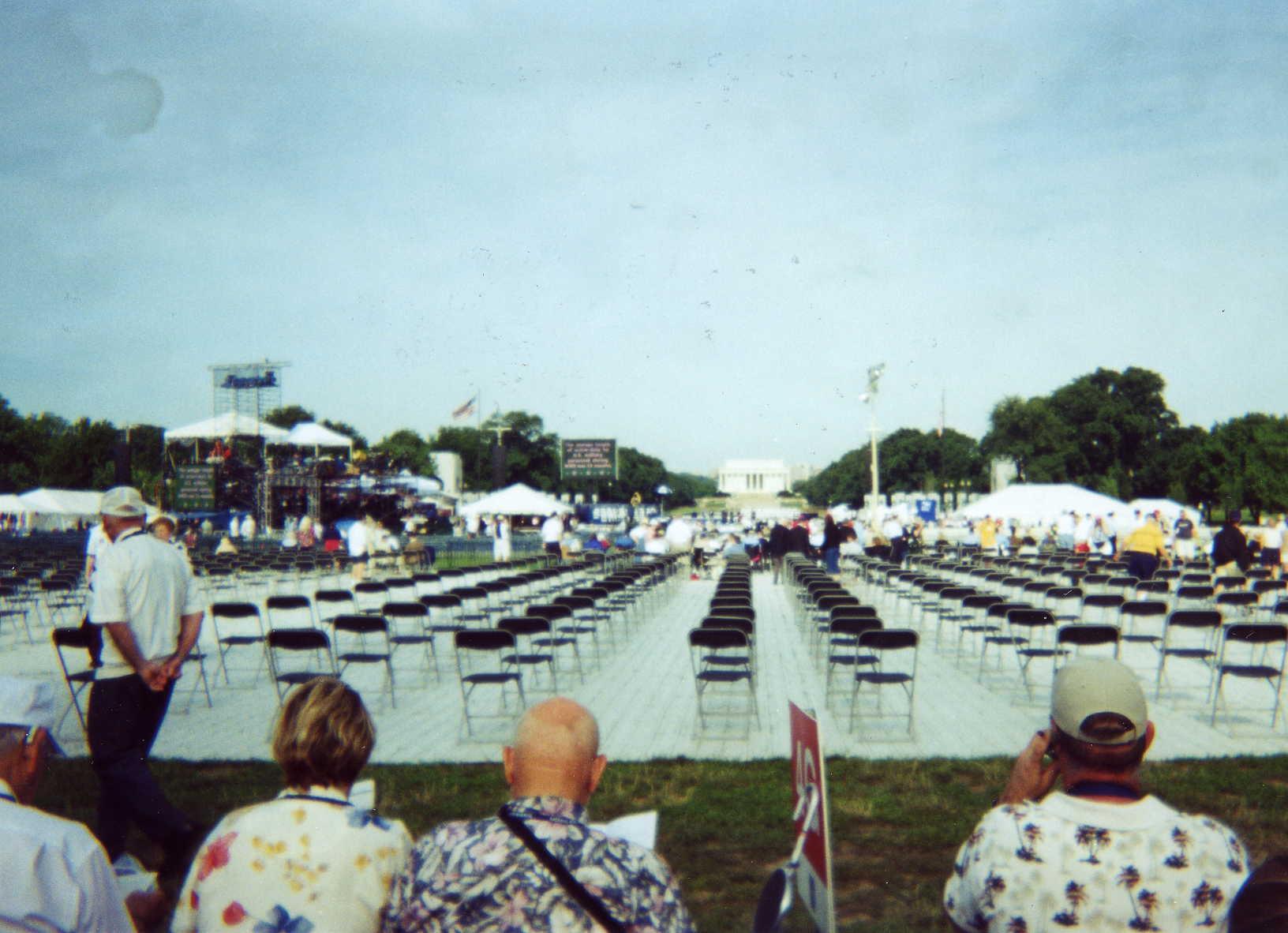
with men like Army Private Joe Sakato. In heavy fighting in France, he saw a good friend killed, and charged up a hill determined to shoot the ones who did it. Private Sakato ran straight into enemy fire, killing 12, wounding two, capturing four, and inspiring his whole unit to take the hill and destroy the enemy. Looking back on it 55 years later, Joe Sakato said, "I'm not a hero. Nowadays they call what I did 'road rage."
This man's conduct that day gained him the Medal of Honor, one of 464 awarded for actions in World War II. Americans in uniform served bravely, fought fiercely and kept their honor even under the worst of conditions. Yet they were not warriors by nature. All they wanted was to finish the job and make it home. One soldier in the 58th Armor Field Artillery was known to have the best kept rifle in the unit. He told his buddies he had plans for that weapon after the war. He said, "I want to take it home, cover it in salt, hang it on a wall in my living room so I can watch it rust."
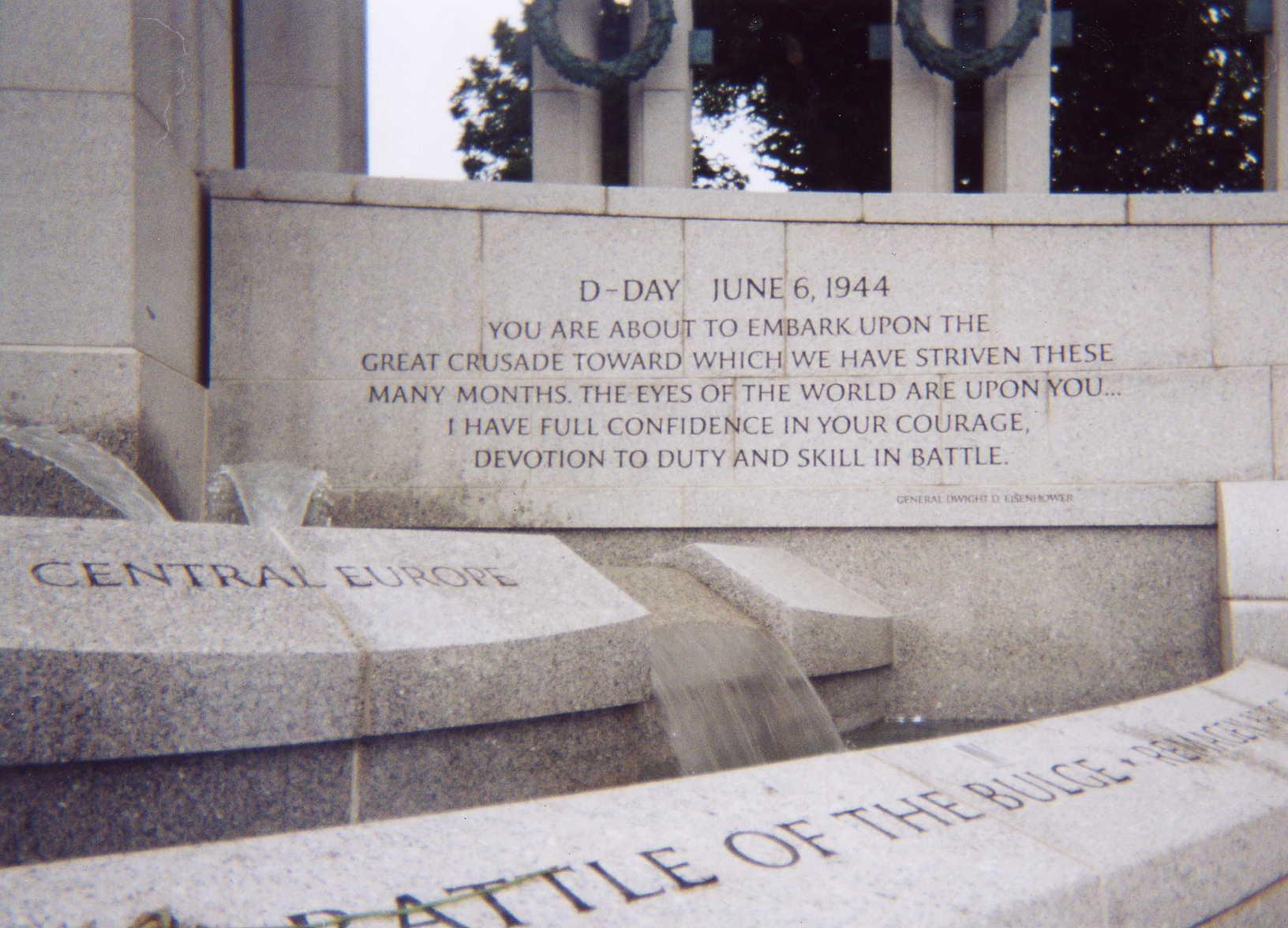
These were the modest sons of a peaceful country, and millions of us are very proud to call them Dad. They gave the best years of their lives to the greatest mission their country ever accepted. They faced the most extreme danger, which took some and spared others, for reasons only known to God. And wherever they advanced or touched ground, they are remembered for their goodness and their decency. A Polish man recalls being marched through the German countryside in the last weeks of the war, when American forces suddenly appeared. He said, "Our two guards ran away. And this soldier with little blonde hair jumps off his tank. 'You're free,' he shouts at us. We started hugging each other, crying and screaming, 'God sent angels down to pick us up out of this hell place.'"
Well, our boys weren't exactly angels. They were flesh and blood, with all the limits and fears of flesh and blood. That only makes the achievement more remarkable the courage they showed, in a conflict that claimed more than 400,000 American lives, leaving so many orphans and widows and Gold Star Mothers.
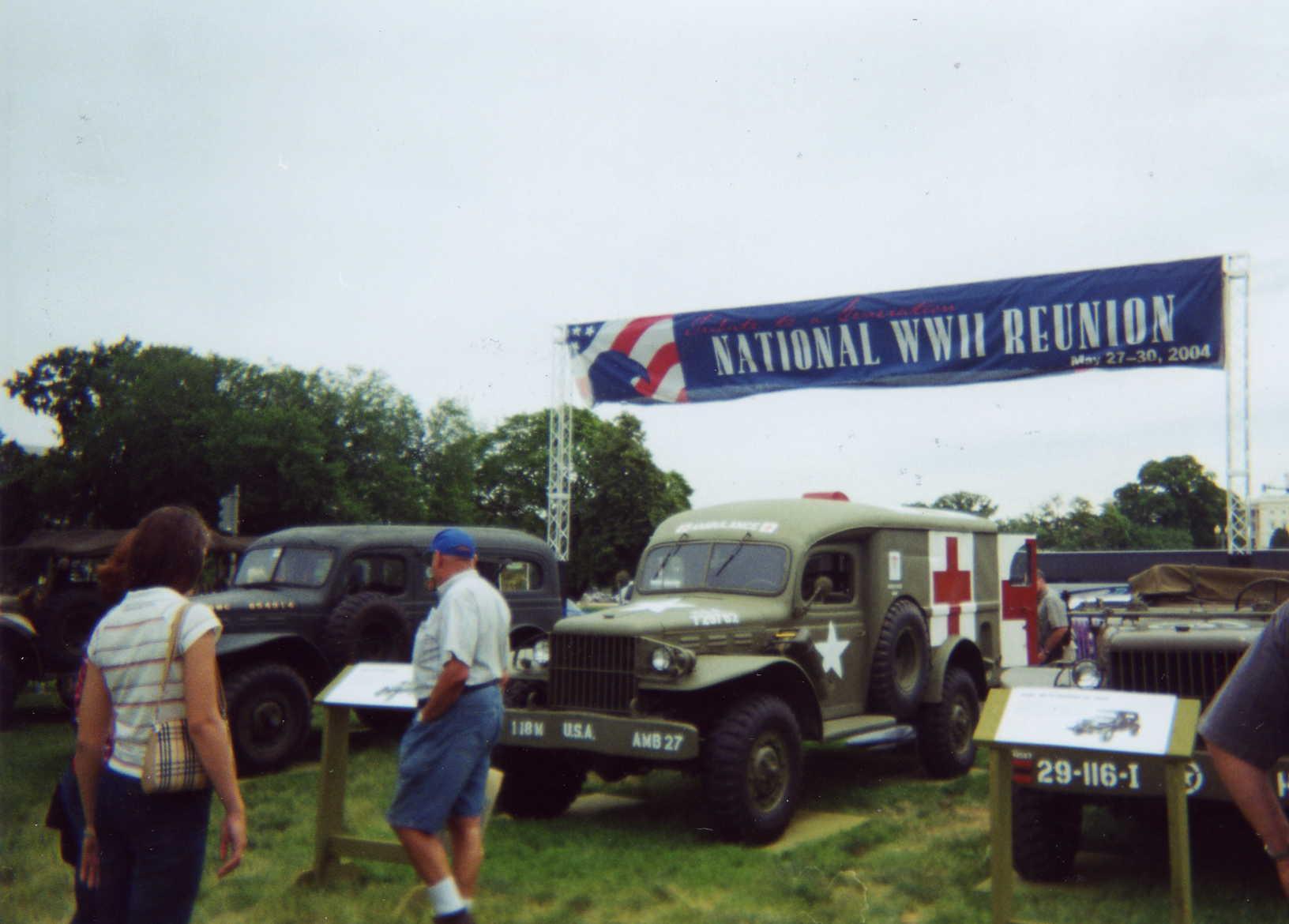
The soldiers' story was best told by the great Ernie Pyle, who shared their lives and died among them. In his book, "Here Is Your War," he described World War II as many veterans now remember it. It is a picture, he wrote, "of tired and dirty soldiers, who are alive and don't want to die; of long, darkened convoys in the middle of the night; of shocked, silent men wandering back down the hill from battle; of Jeeps and petrol dumps and smelly bedding roles and C rations; and blown bridges and dead mules and hospital tents and shirt collars greasy black from months of wearing; and of laughter, too, and anger, and wine, and lovely flowers and constant cussing. All these, it is composed of; and of graves and graves and graves."
On this Memorial Day weekend, the graves will be visited, and decorated with flowers and flags. Men whose step has slowed are thinking of boys they knew when they were boys together. And women who watched the train leave, and the years pass, can still see the handsome face of their young sweetheart. America will not forget them, either.
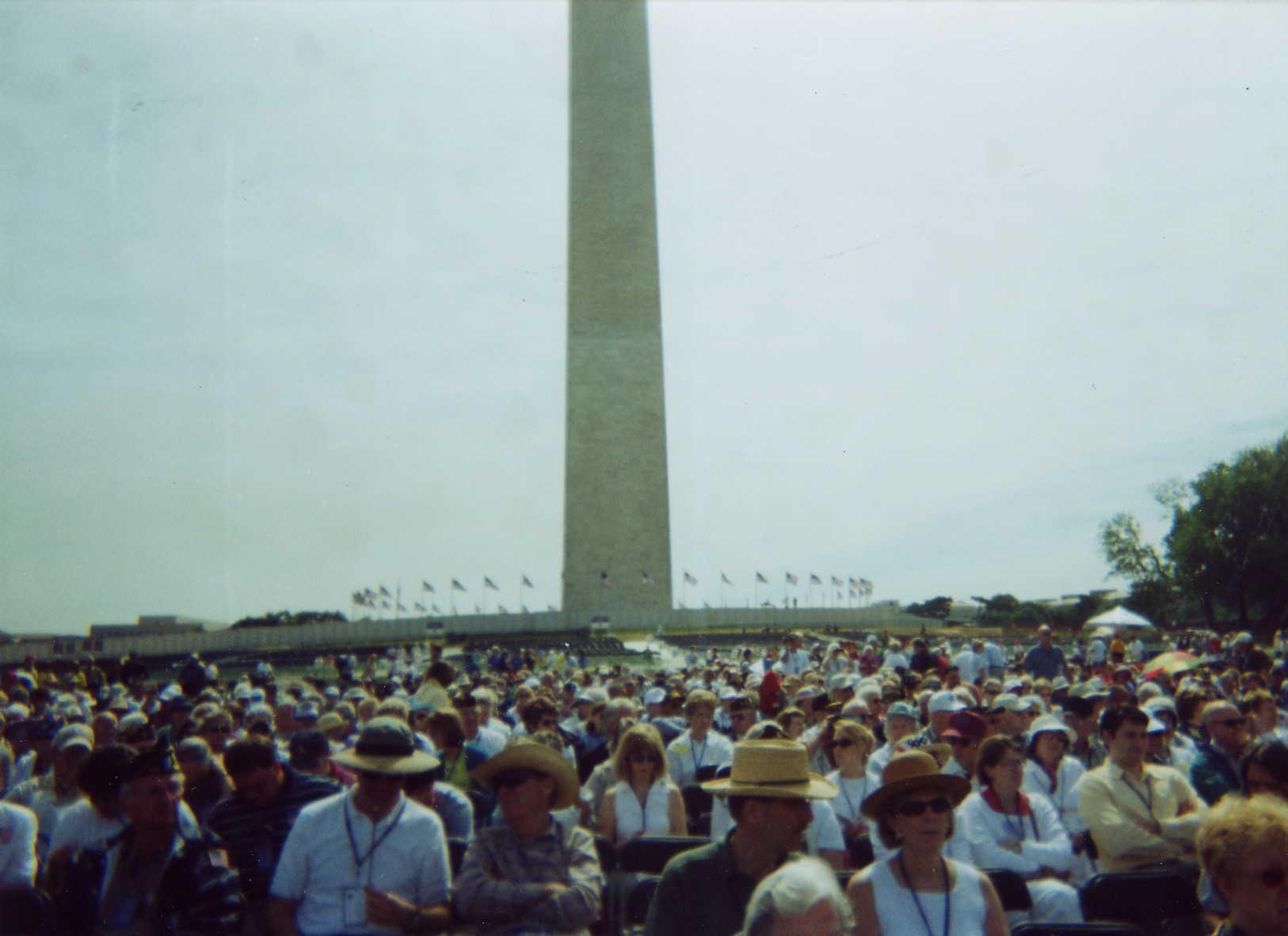
At this place, at this Memorial, we acknowledge a debt of long standing to an entire generation of Americans: those who died; those who fought and worked and grieved and went on. They saved our country, and thereby saved the liberty of mankind. And now I ask every man and woman who saw and lived World War II every member of that generation to please rise as you are able, and receive the thanks of our great nation.
May God bless you.”
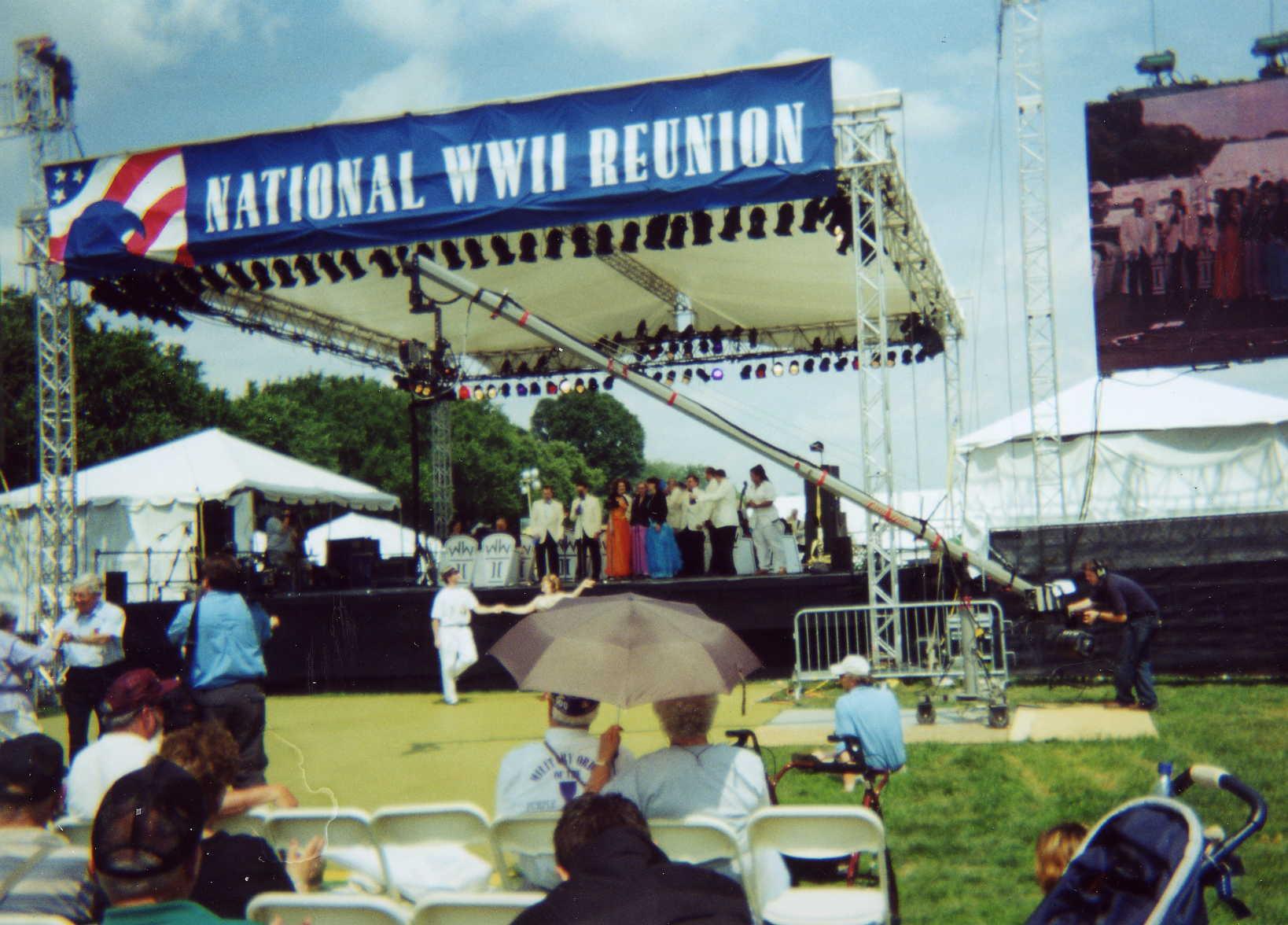
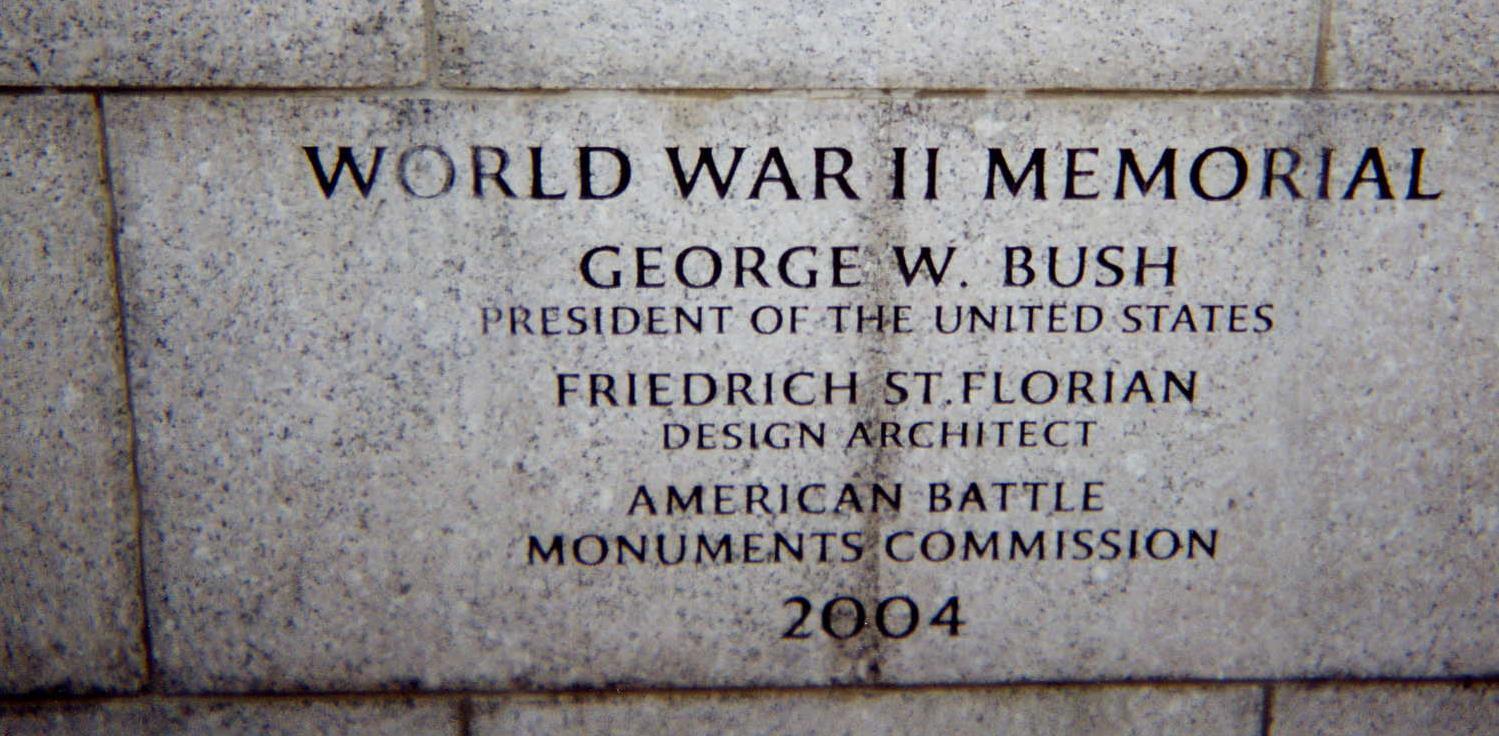

Charles Micheals is a native of Michigan and lived the first thirty years of his life there, eventually working in the grocery industry. In 1985, Charles, his wife Barbara and their four small children joined Wycliffe Bible Translators and moved to the country of Papua New Guinea (PNG) where they worked with the internationally known non profit linguistic organization, SIL International (formerly the Summer Institute of Linguistics). Charles served in a variety of administrative roles in PNG, including several years as the Chairman of the SIL PNG Job Evaluation and Wage Review Committee and on the SIL PNG Executive Committee.
During their 15 years of service in PNG, Bible translation work was completed in 67 languages and over 100 additional Bible translation projects were started. Today, almost 180 language communities, representing 1.8 million people in PNG have access to the Scriptures in their own languages.
In 2000, Charles and Barbara moved back to the USA and Charles served for several years as the Regional Director for Recruitment for Wycliffe, living in the Chicago, Illinois area. In 2004 they moved to Orlando, Florida where Charles served for six and one half years as the Vice President for Recruitment Ministries for Wycliffe. He currently heads up Wycliffe’s Management and Professional Recruitment Department and speaks at various mission conferences and colleges each year. Barbara coordinates applications for Wycliffe Volunteers and Interns.
Charles holds a BS degree in Food Distribution from Western Michigan University and a MA degree in Organization Management from Dallas Baptist University. He served on the Board of Directors for The Finishers Project [now Mission Next], a non profit mission dedicated to helping people in the second half
of life find places to serve in missions. He has also been involved in helping create and develop Mission Next Education, a ministry dedicated to helping place teachers in MK (Missionary Kid) mission schools around the world and Military Believer, a growing ministry dedicated to helping military personnel who are leaving the military, find opportunities for service in global missions.

Charles has also authored a number of articles about the work of SIL in PNG and other historical articles about life in the Aiyura Valley in PNG. (http://issuu.com/cbmicheals/docs)
Both Charles and Barbara are members of Saint Andrew’s church in Sanford, FL and are involved in a variety of church activities there. Charles serves as an elder at the church. However, they are still members of Second Christian Reformed Church, in Kalamazoo, Michigan which is the church that commissioned them for their work with Wycliffe. All four of their children are actively supporting missions and church ministry work. Two of their four children are serving with Wycliffe around the world.
